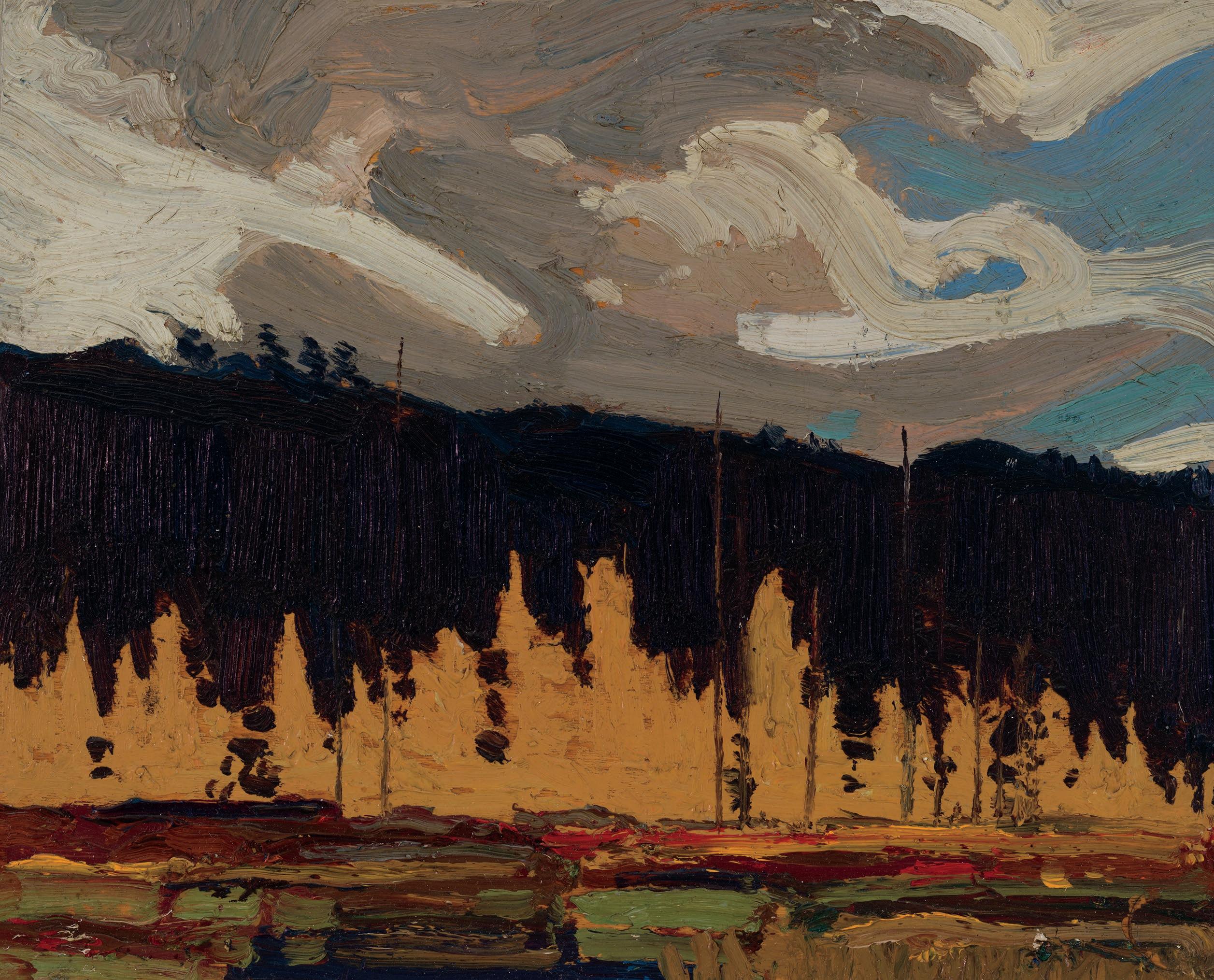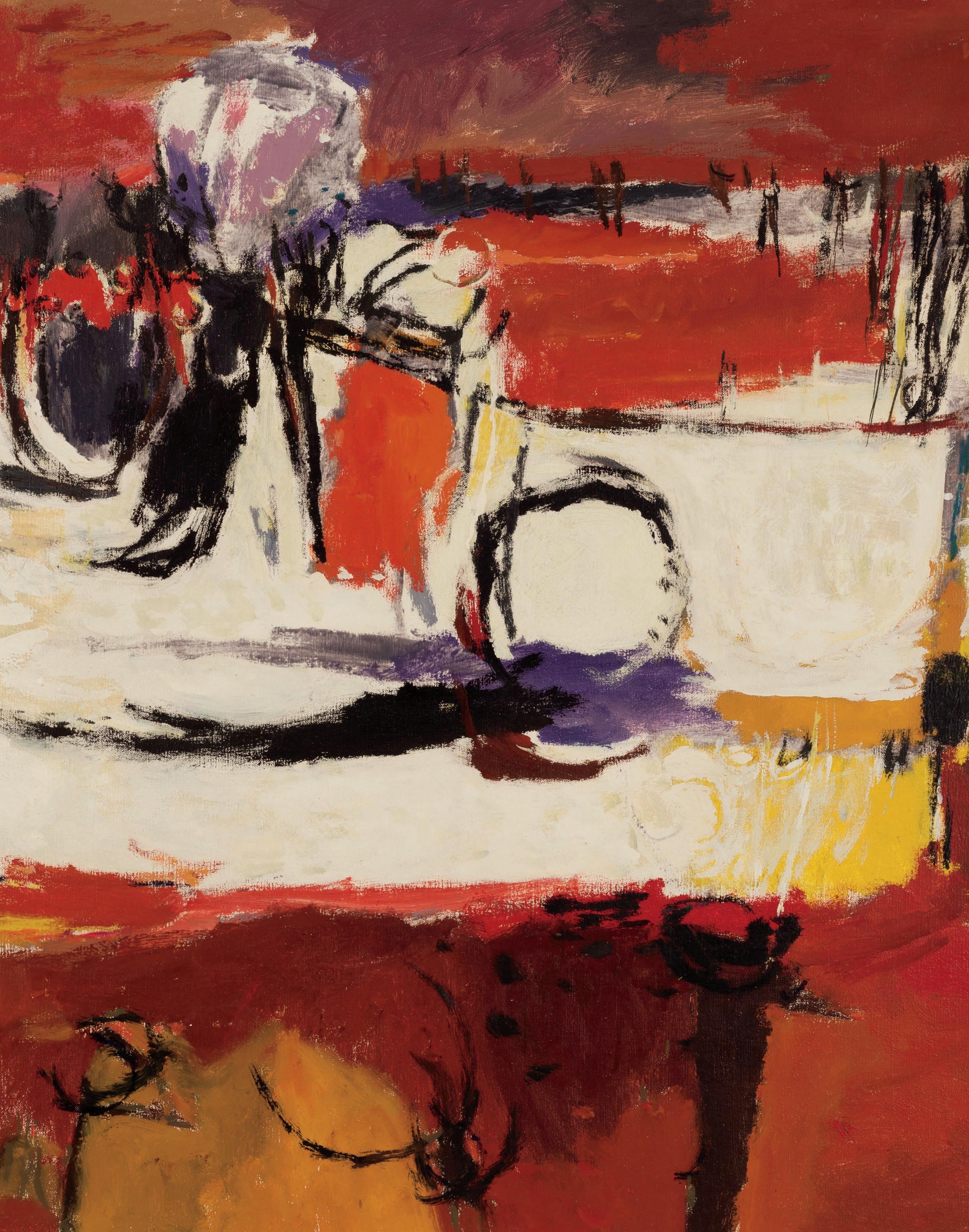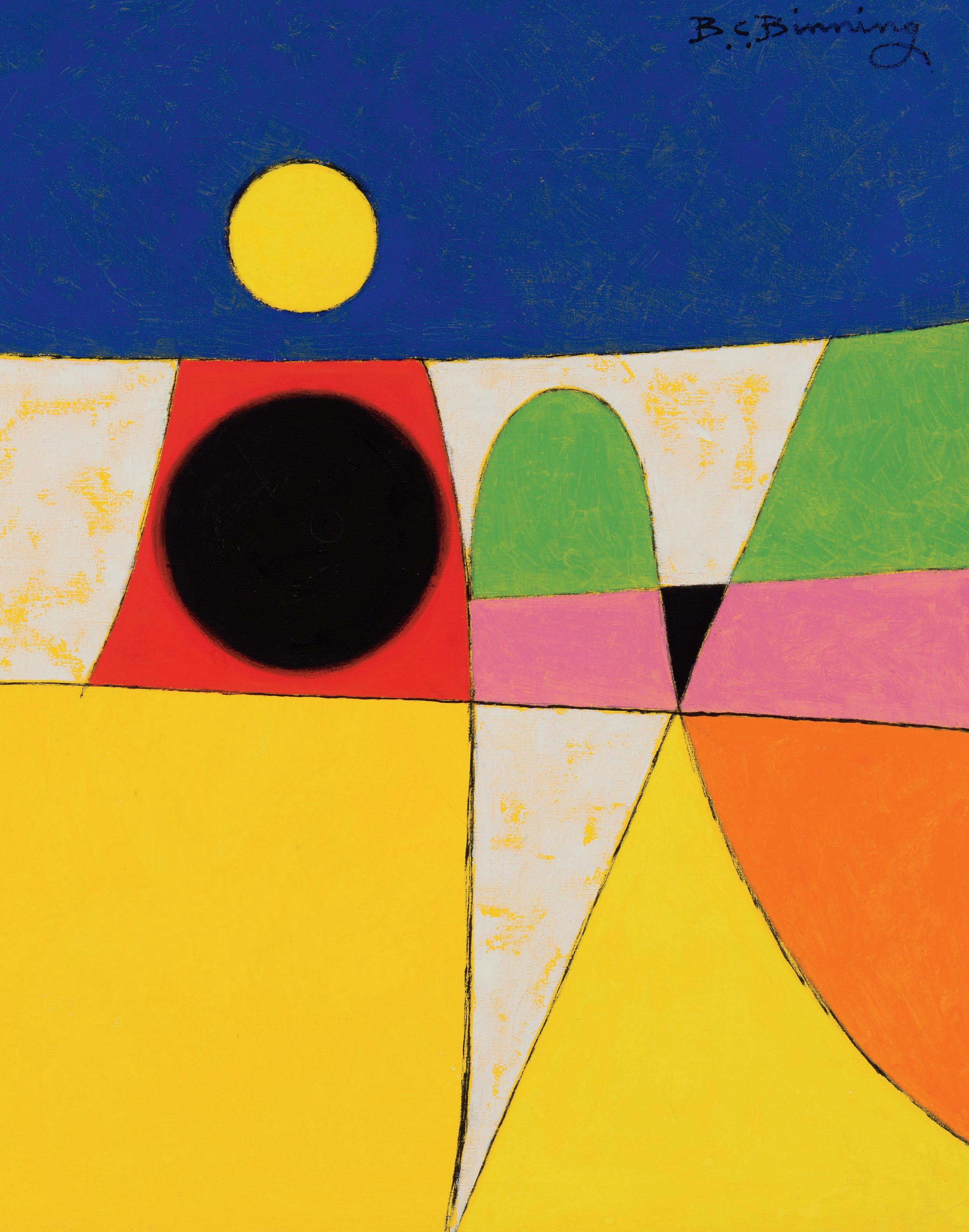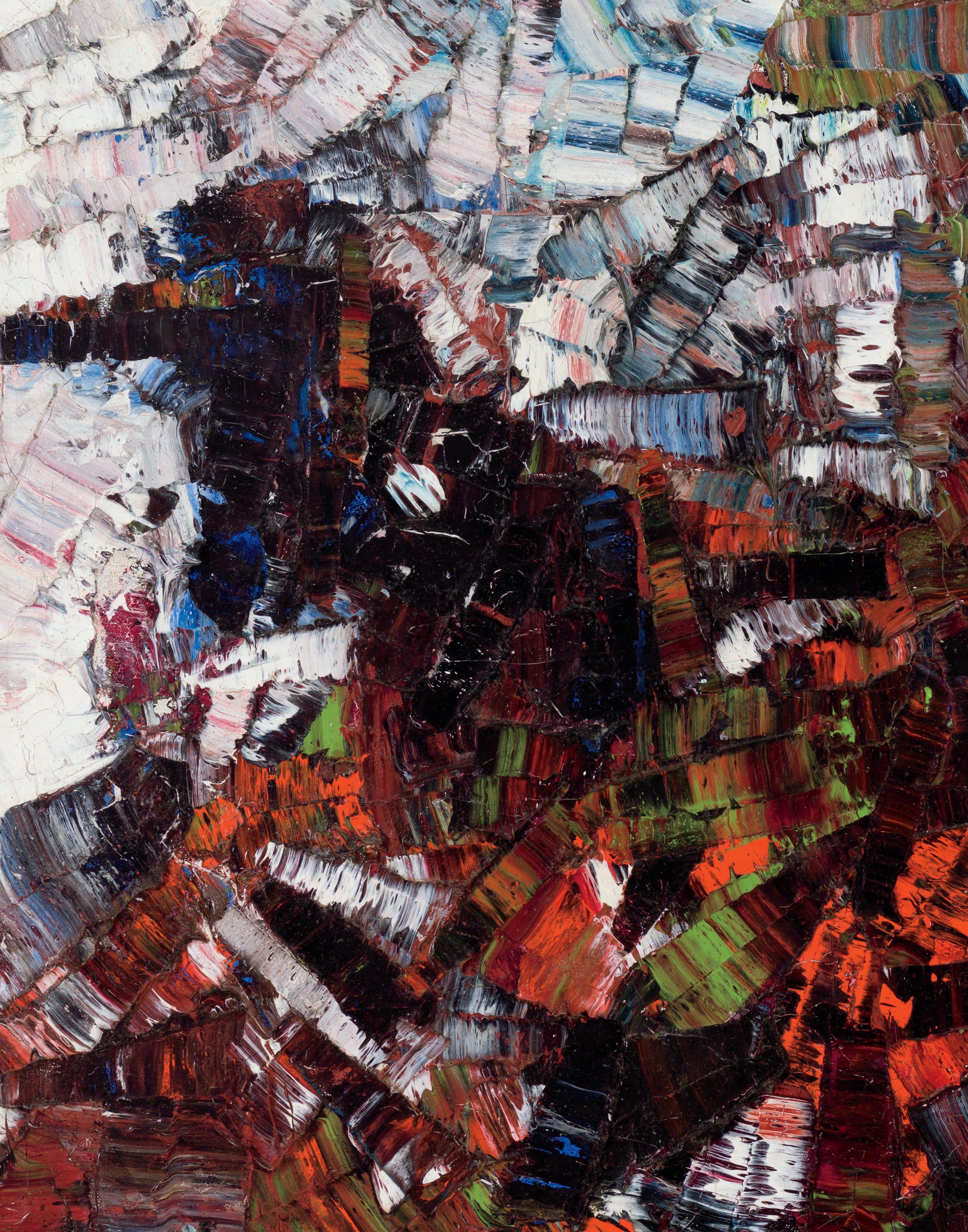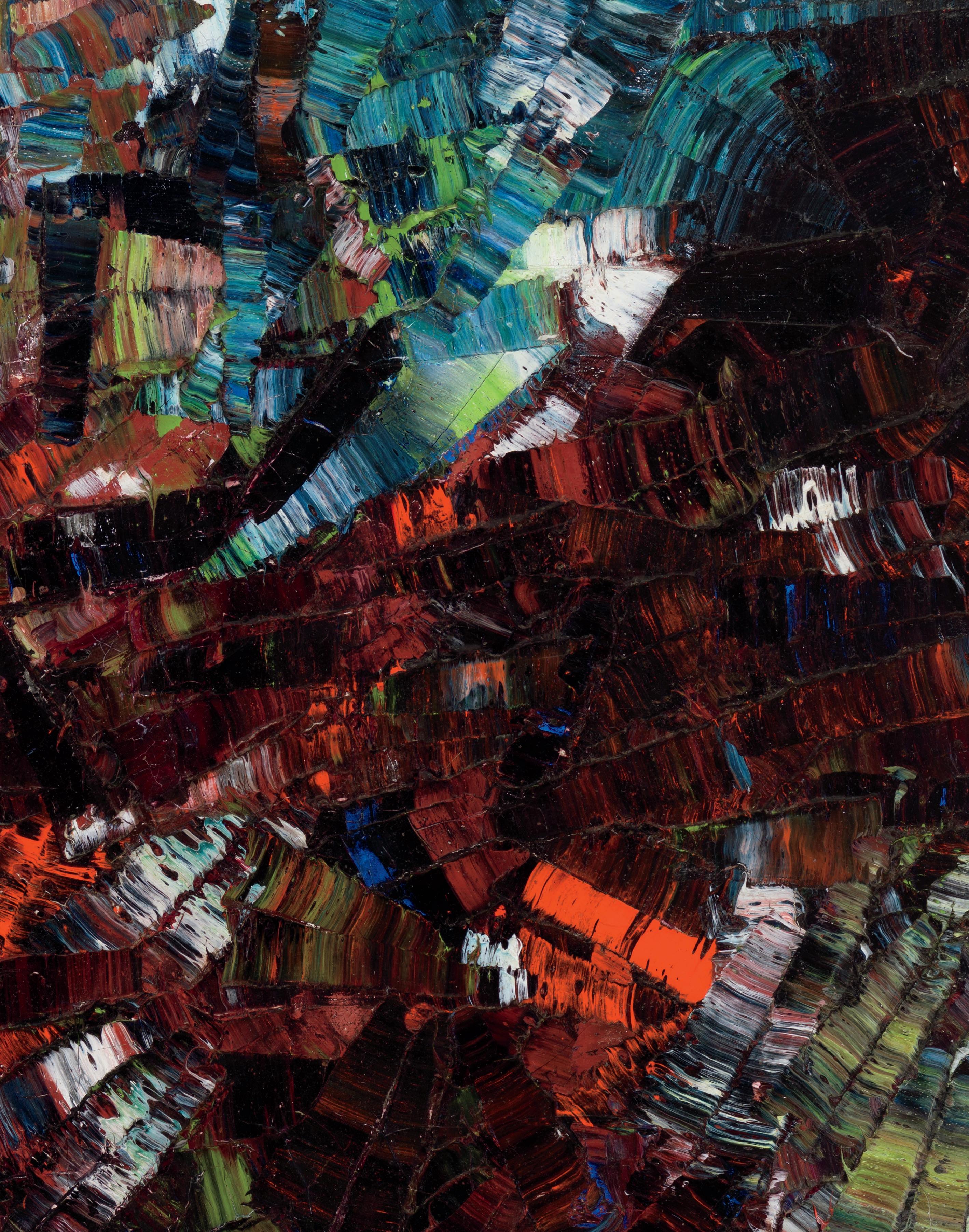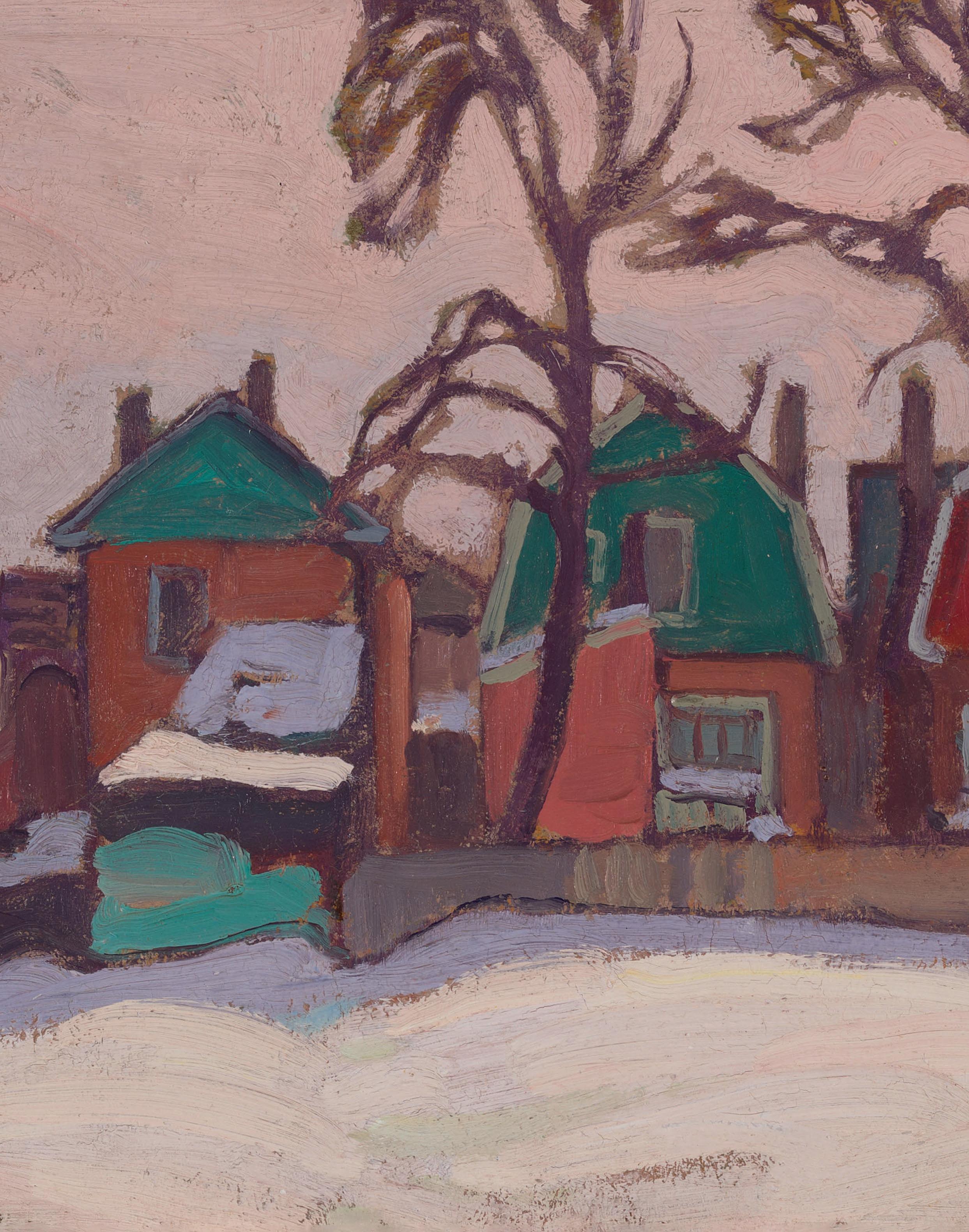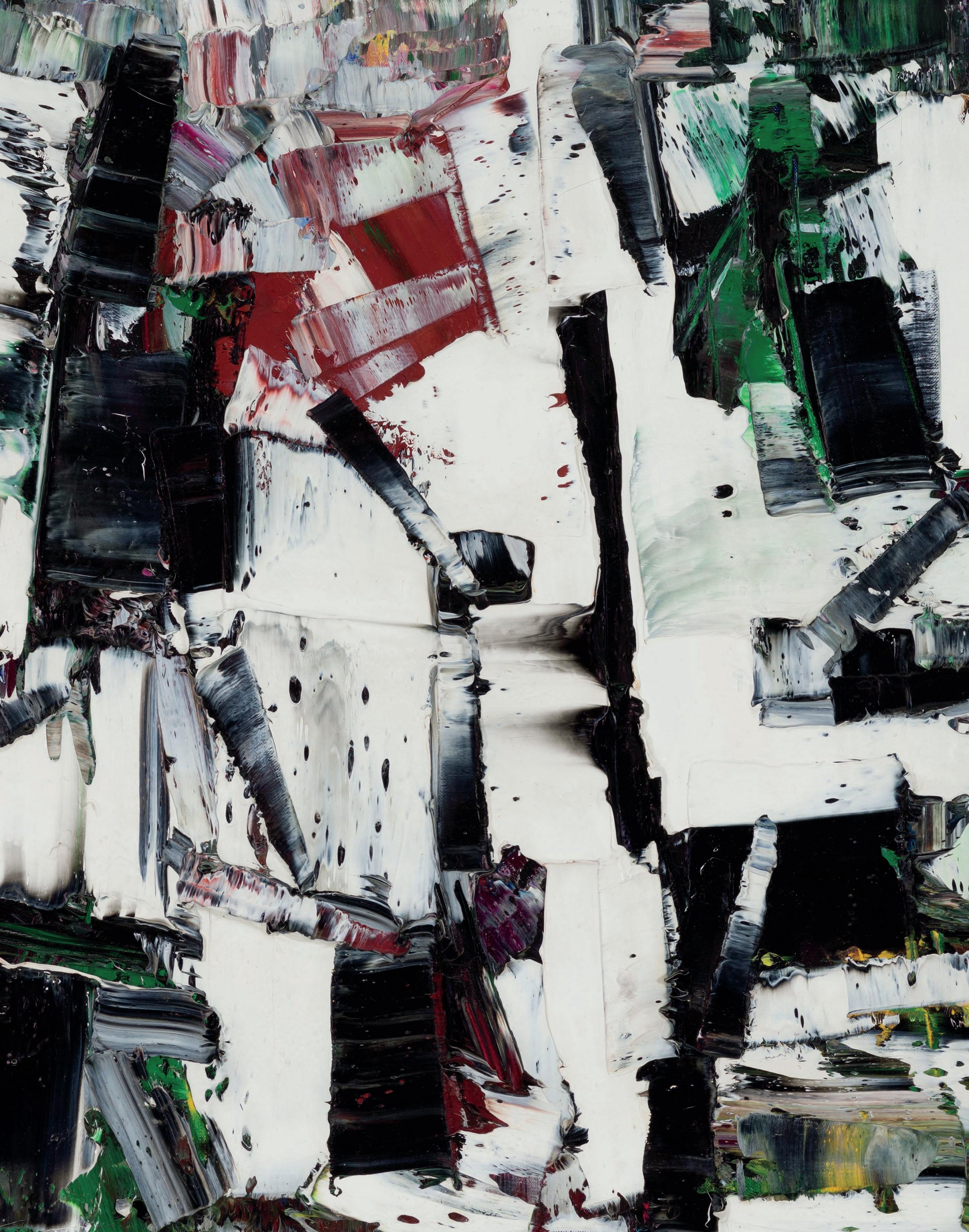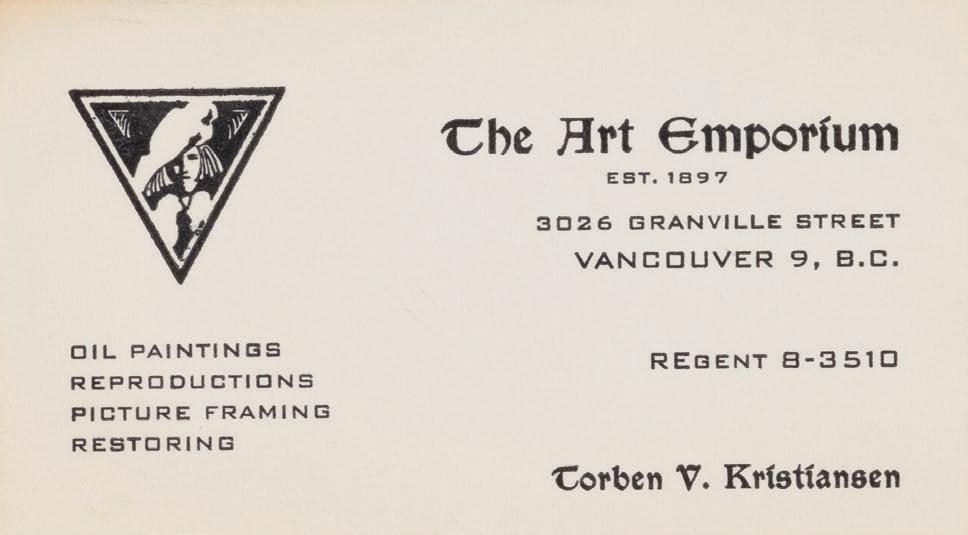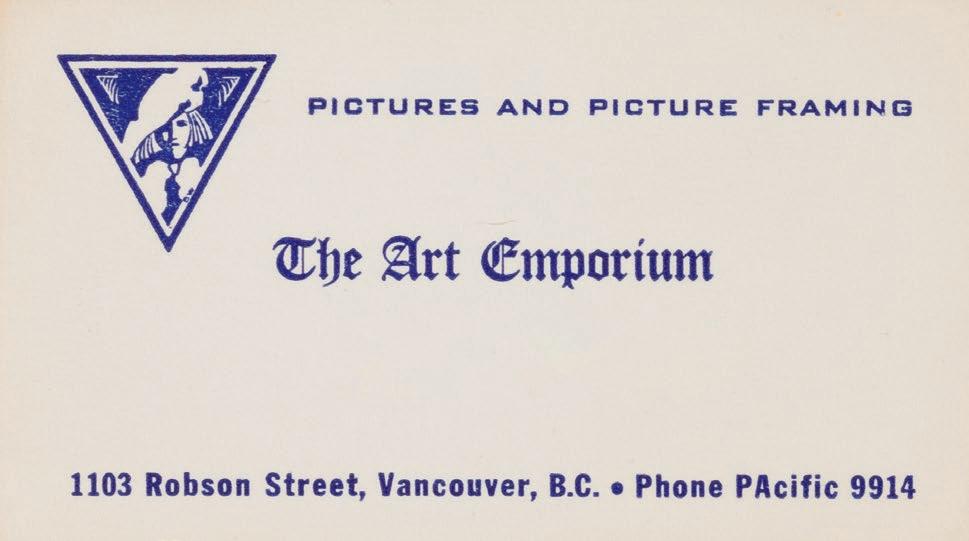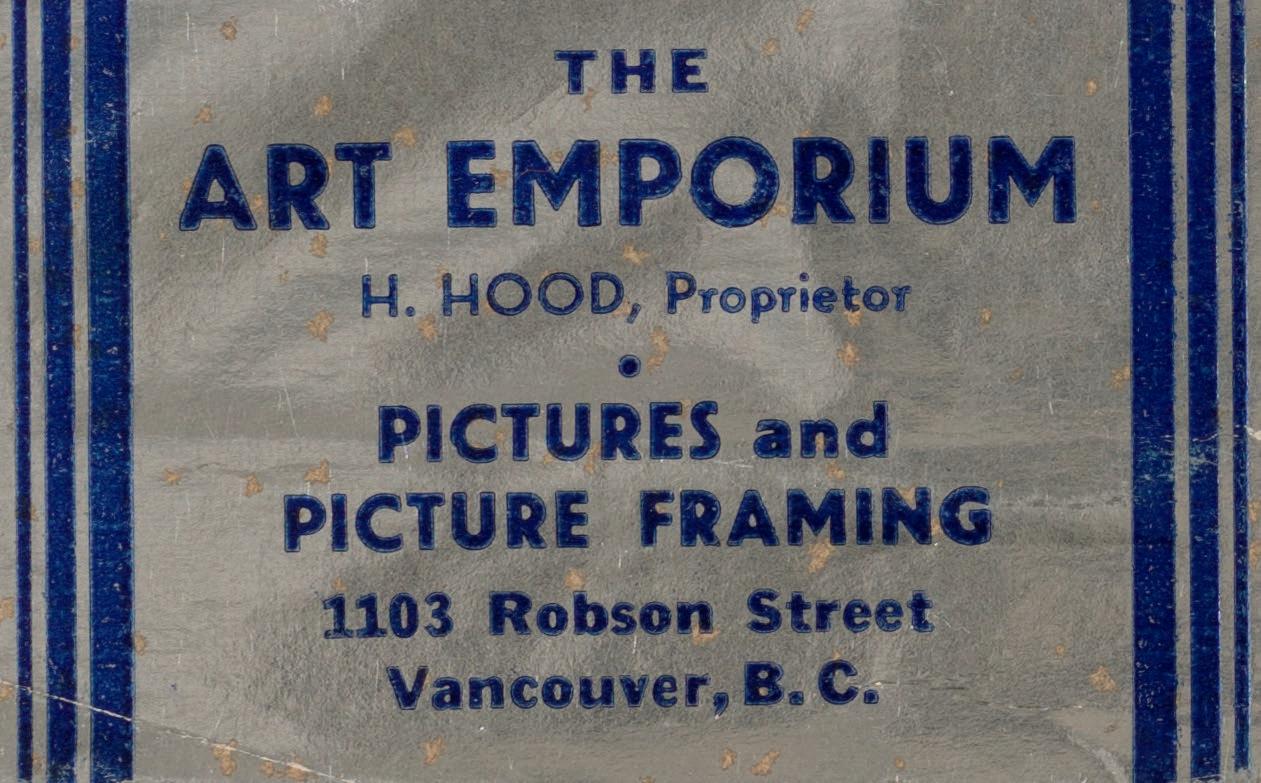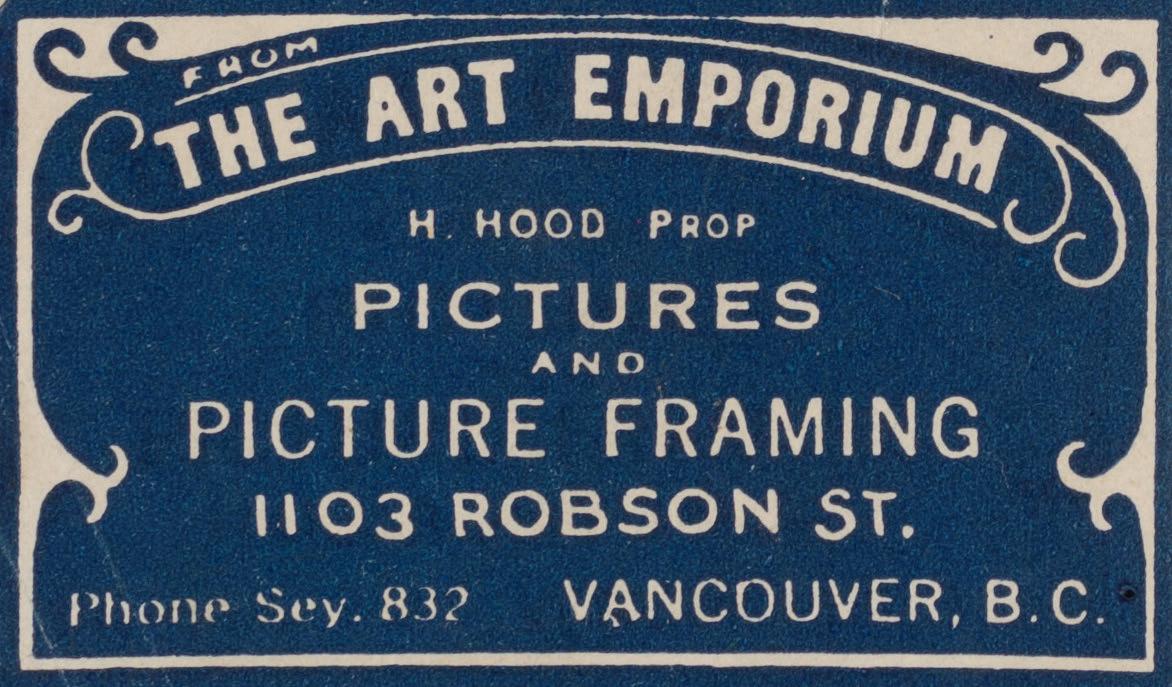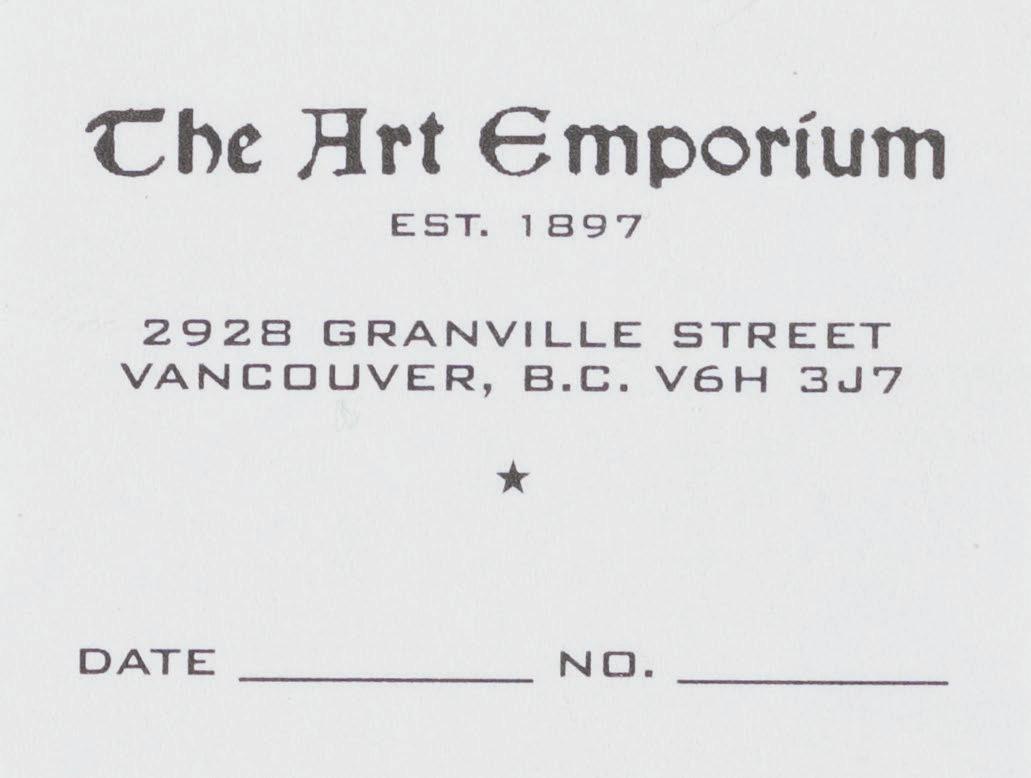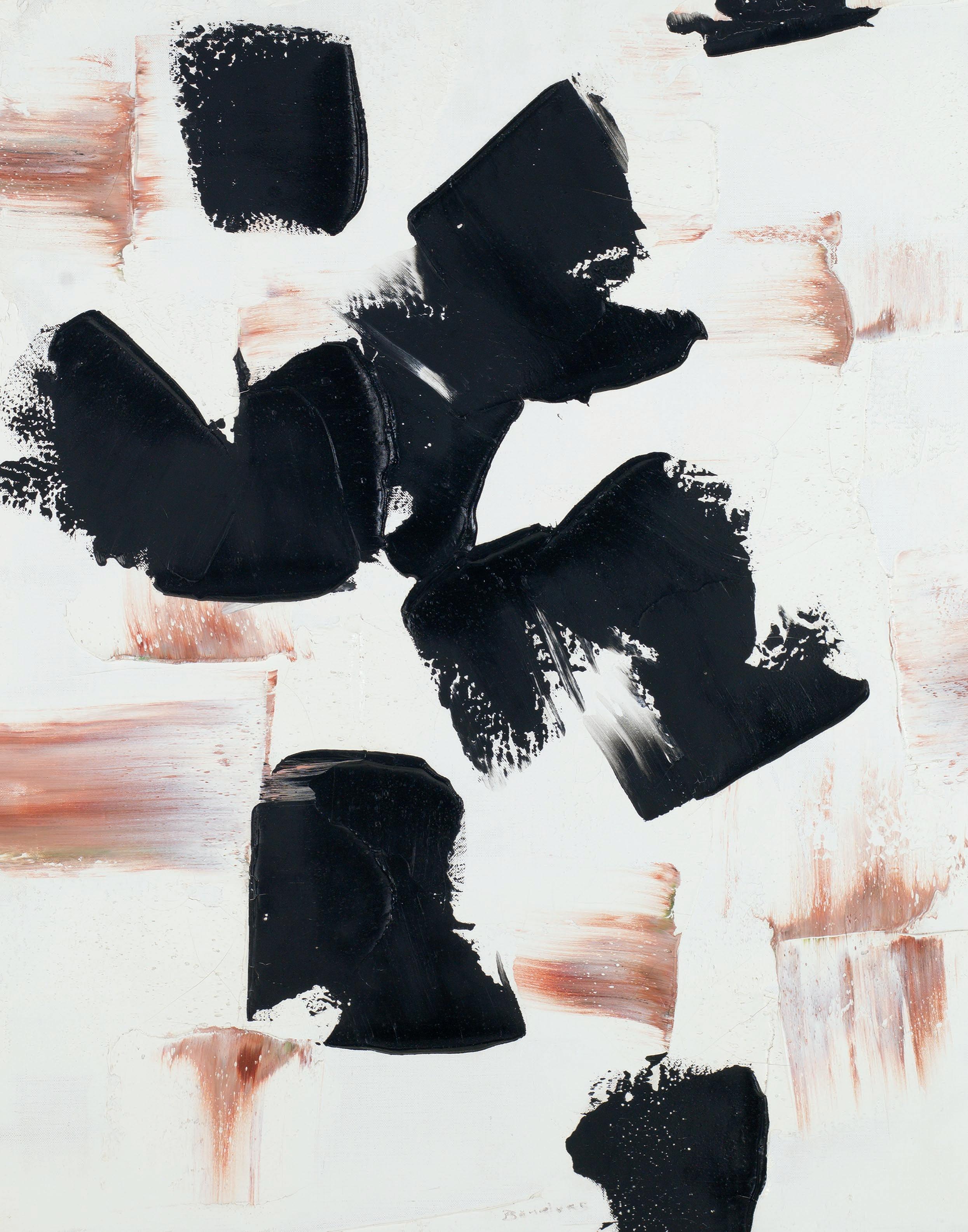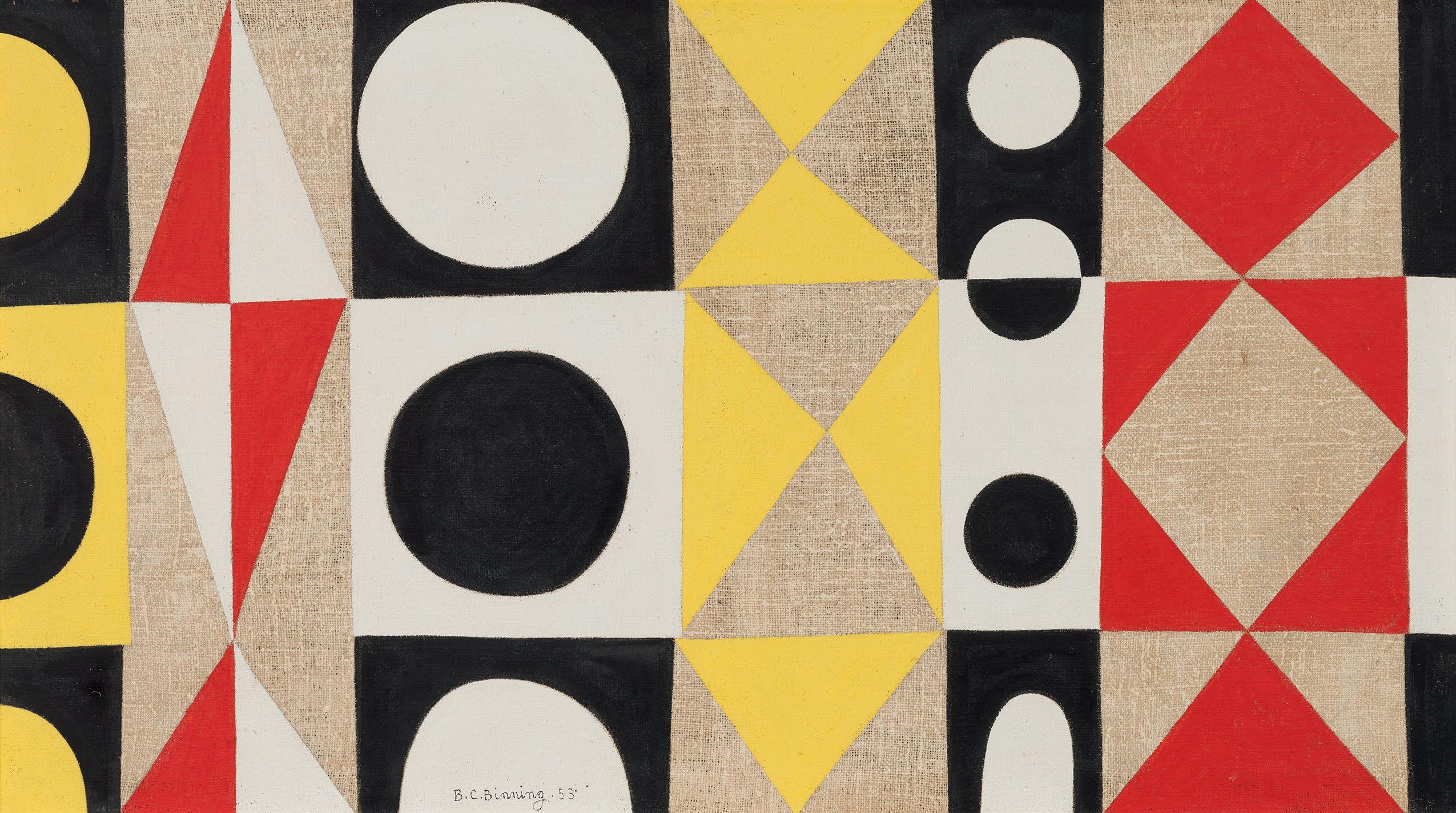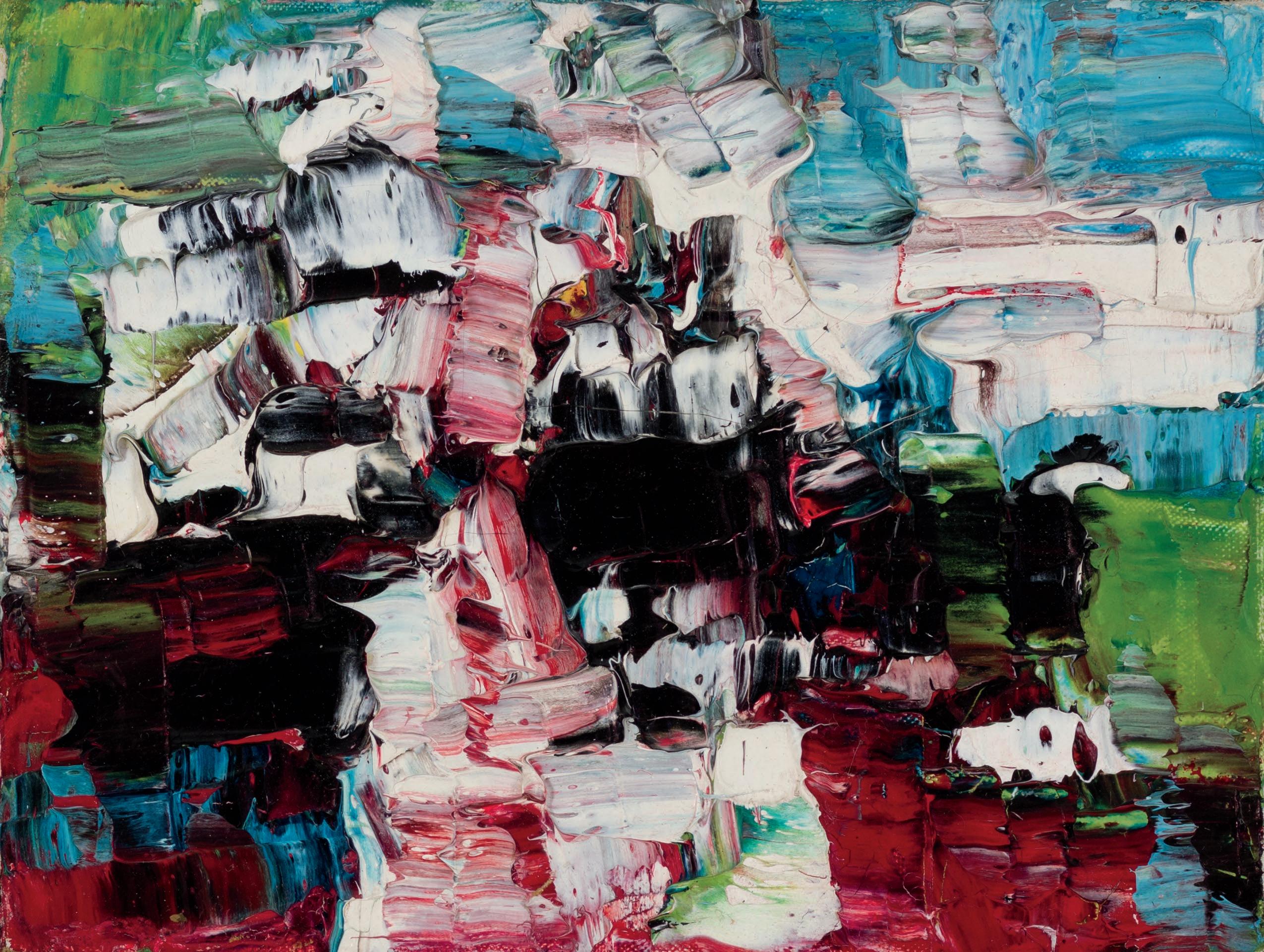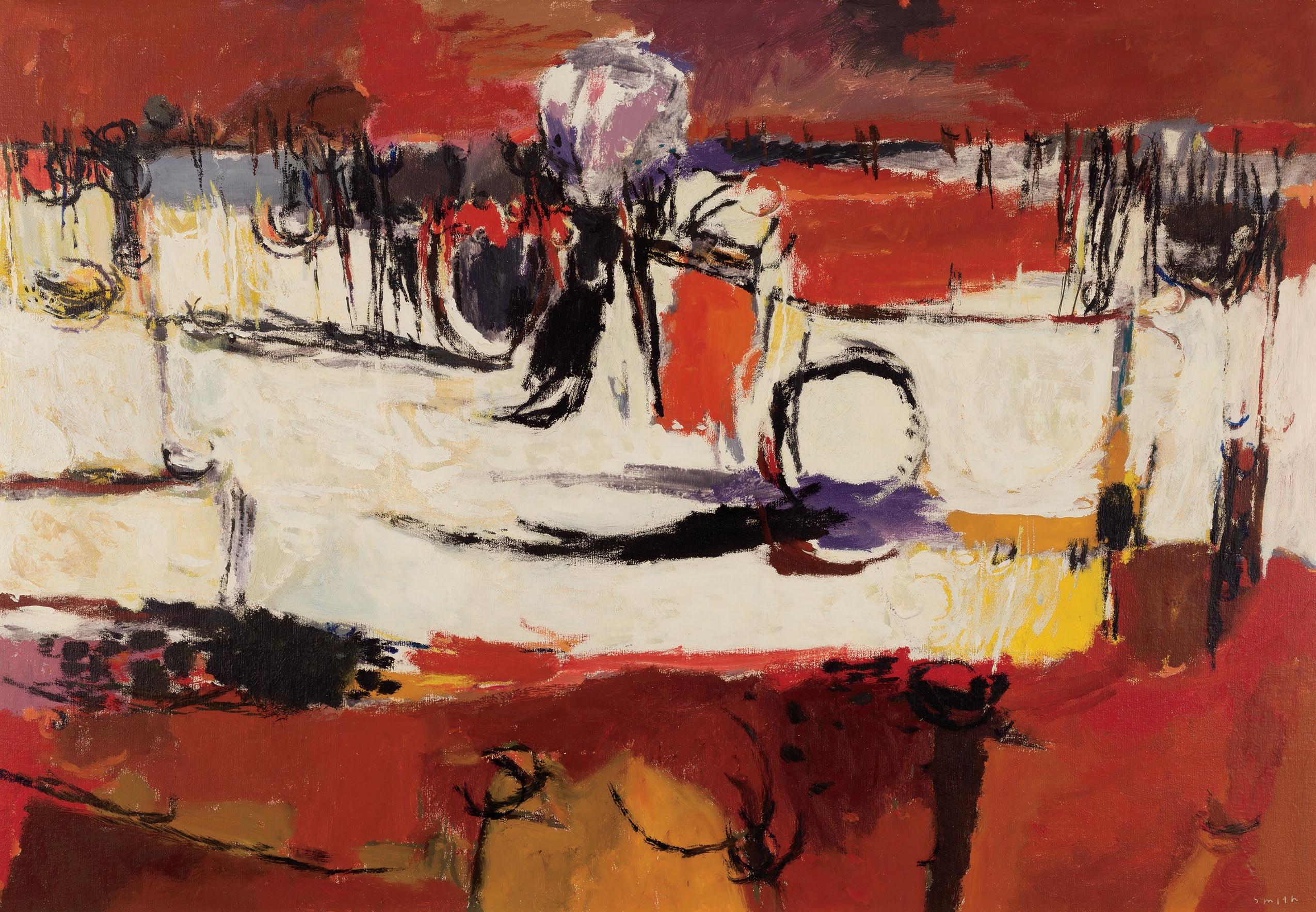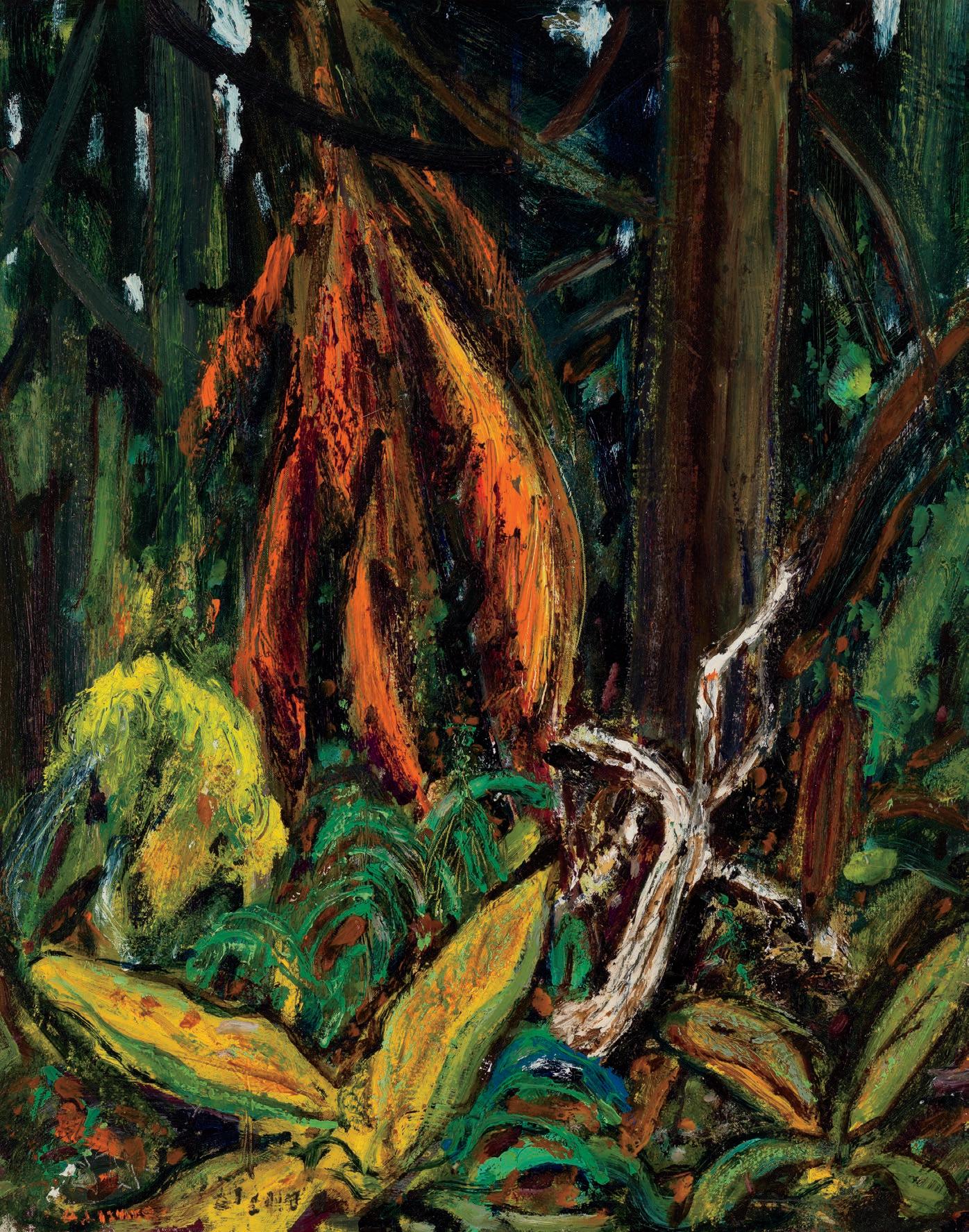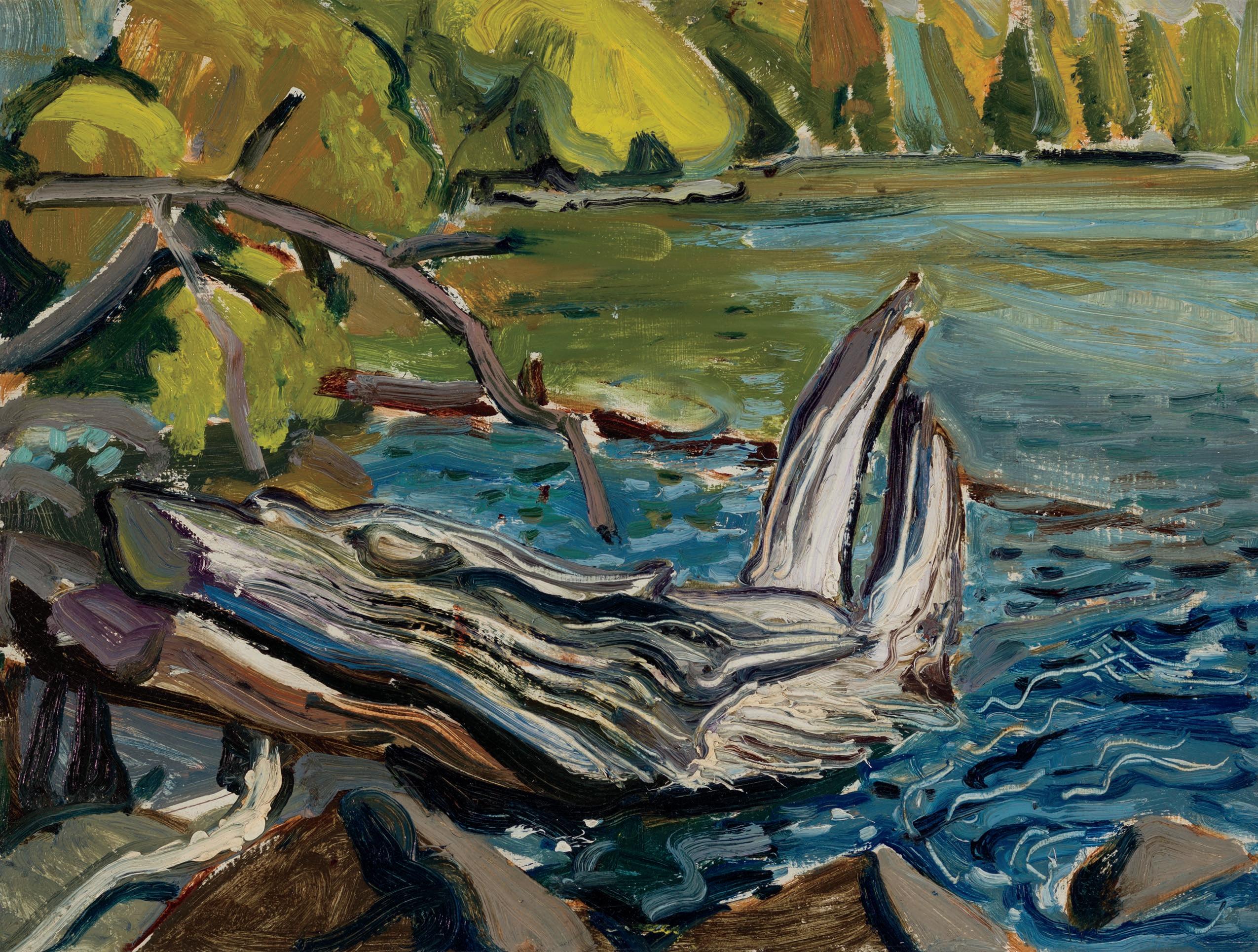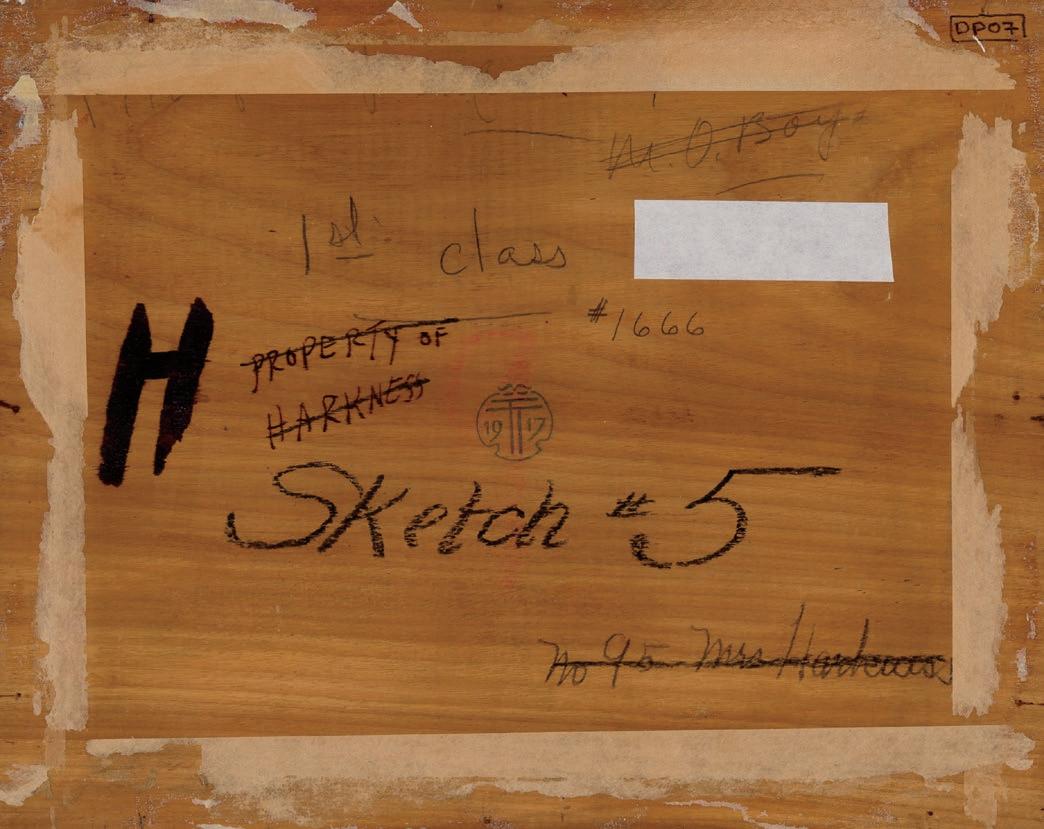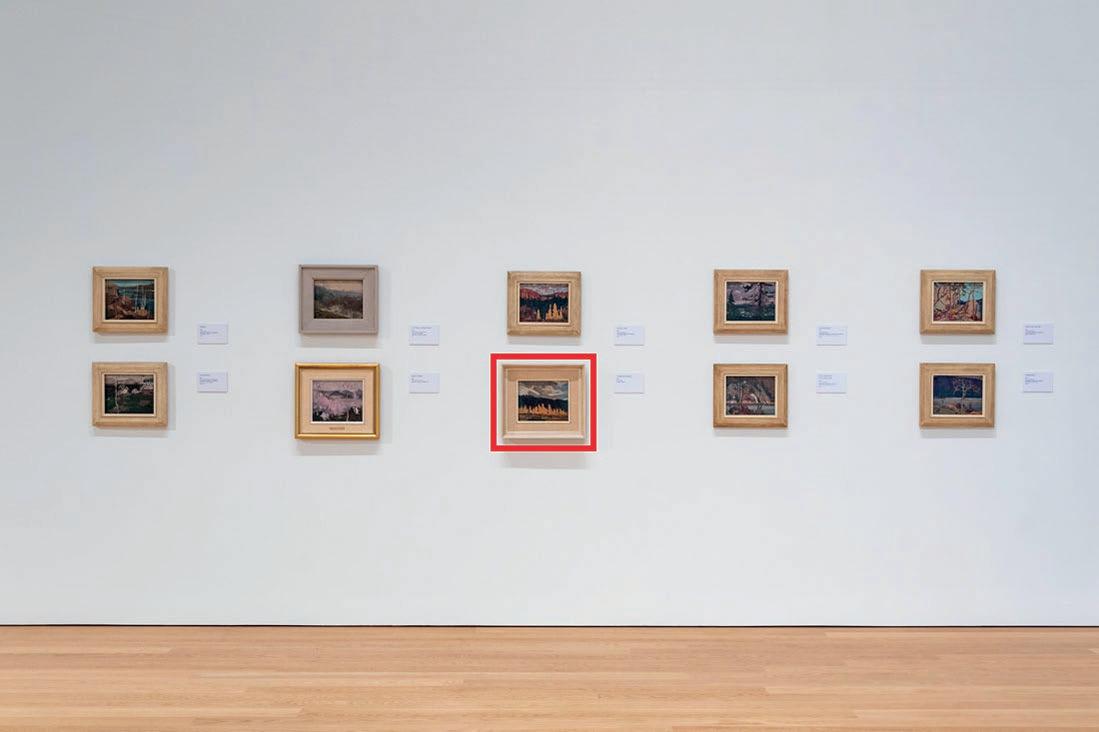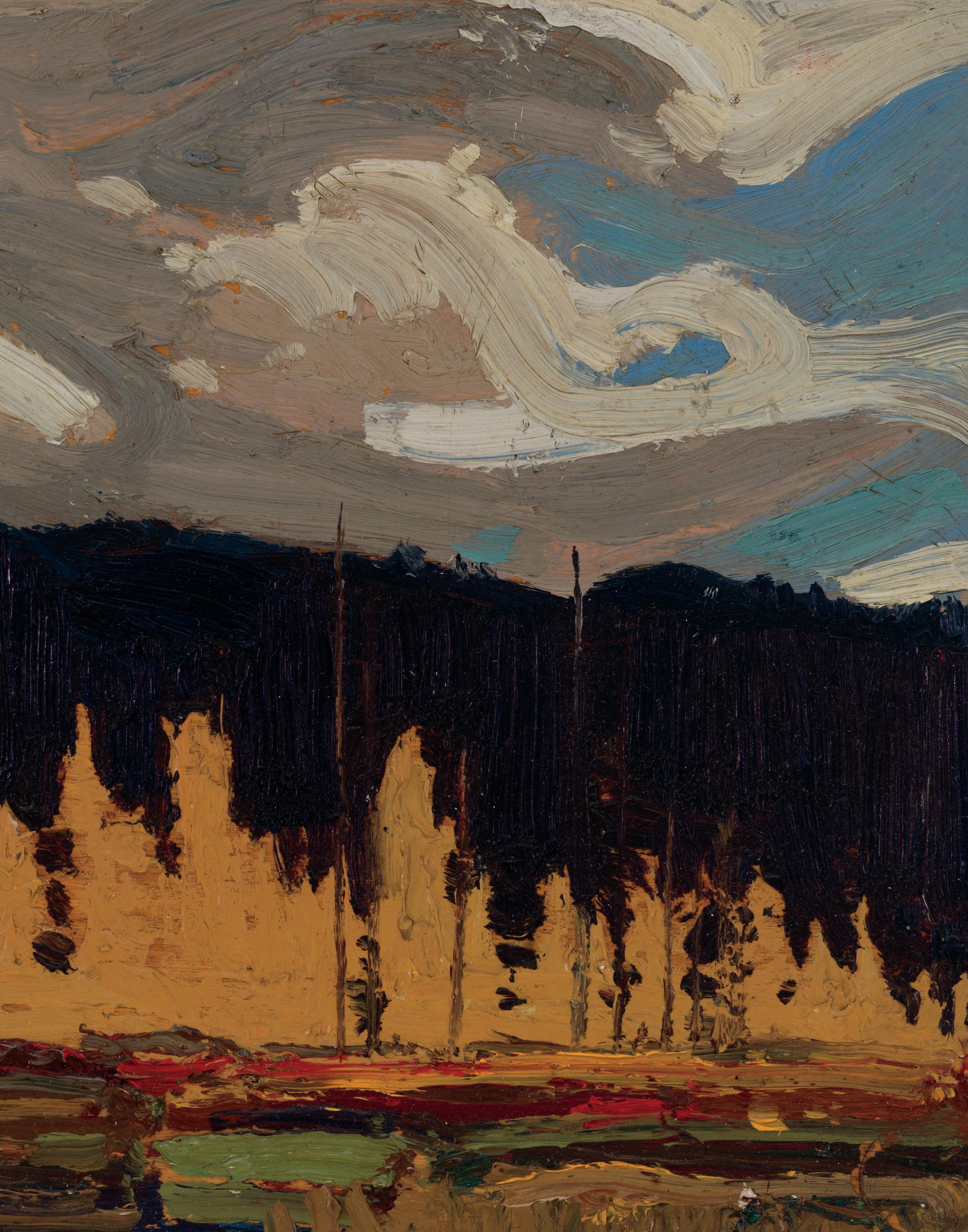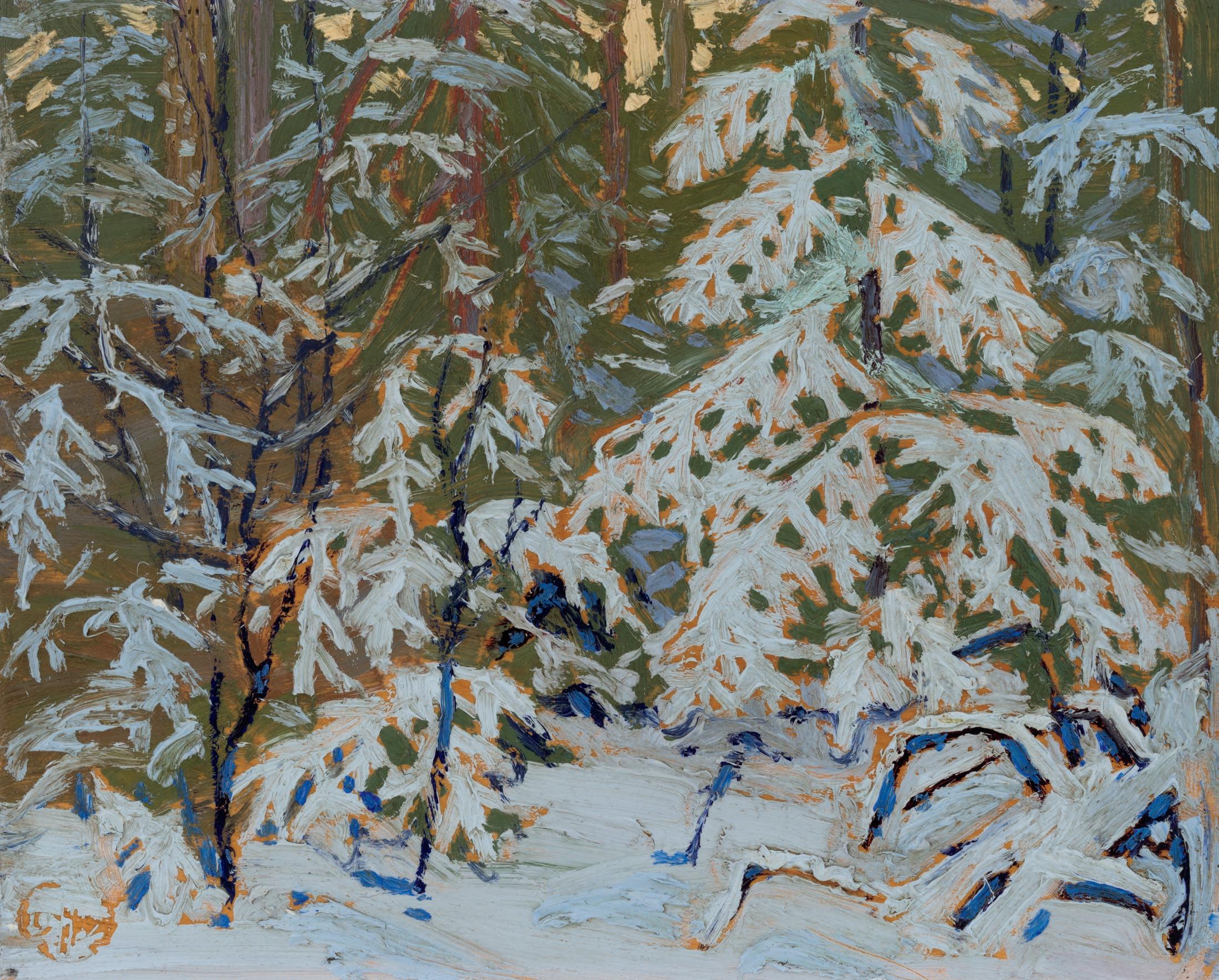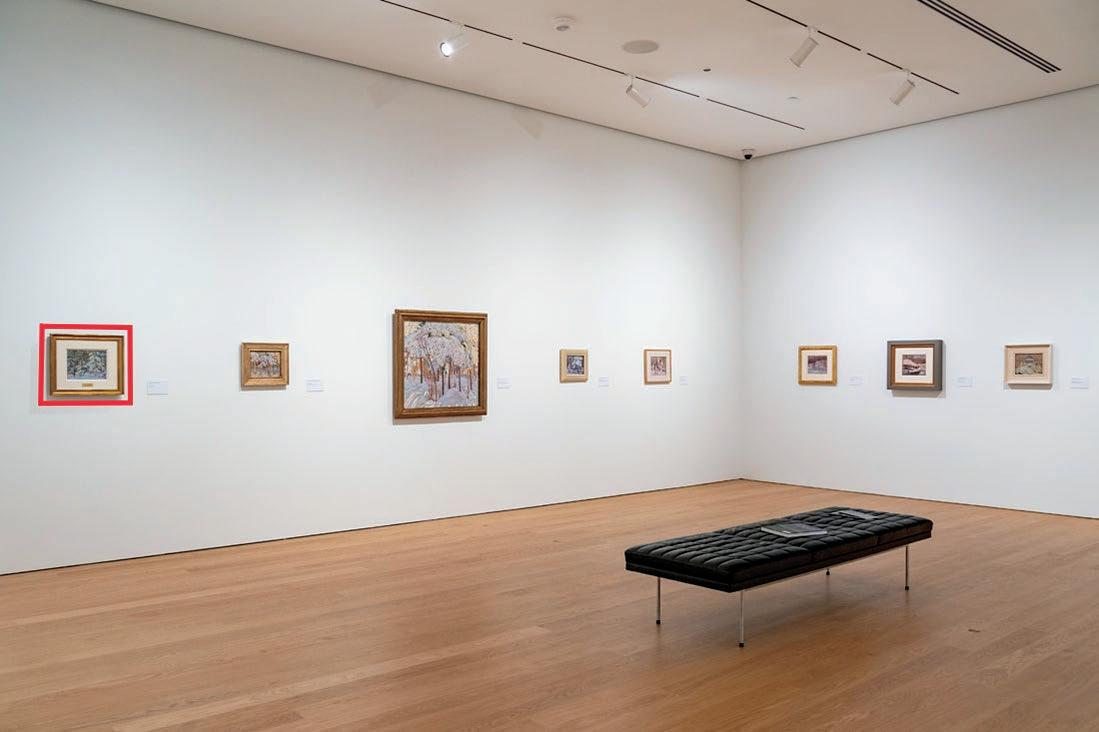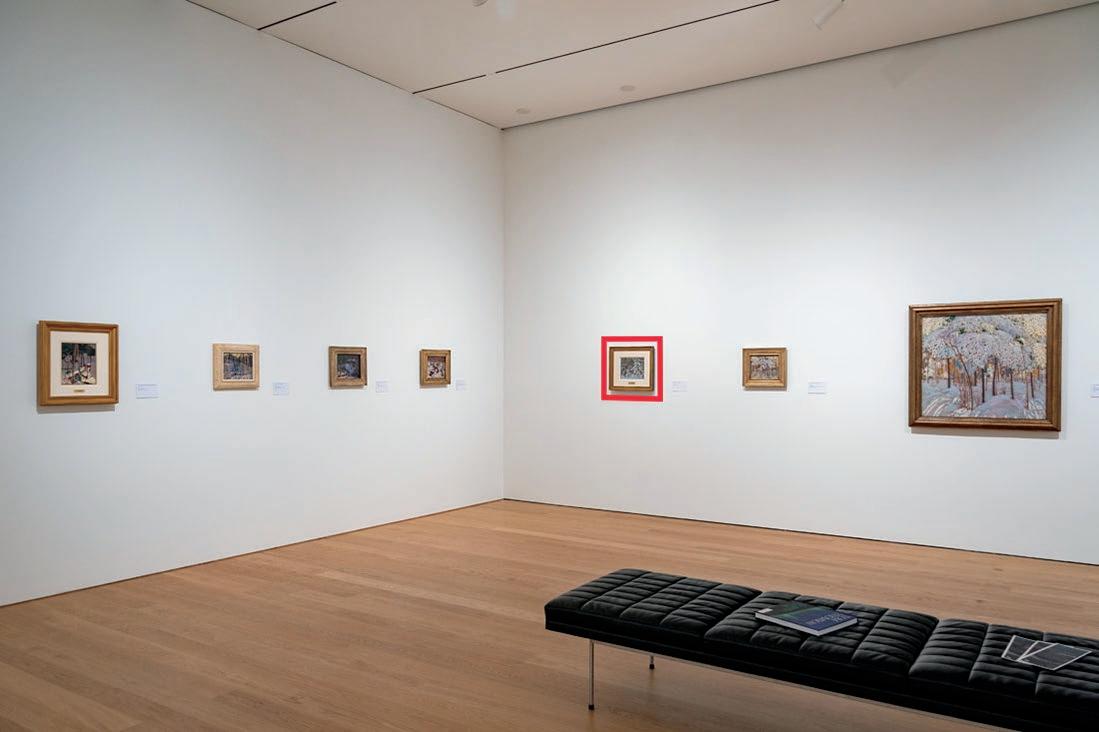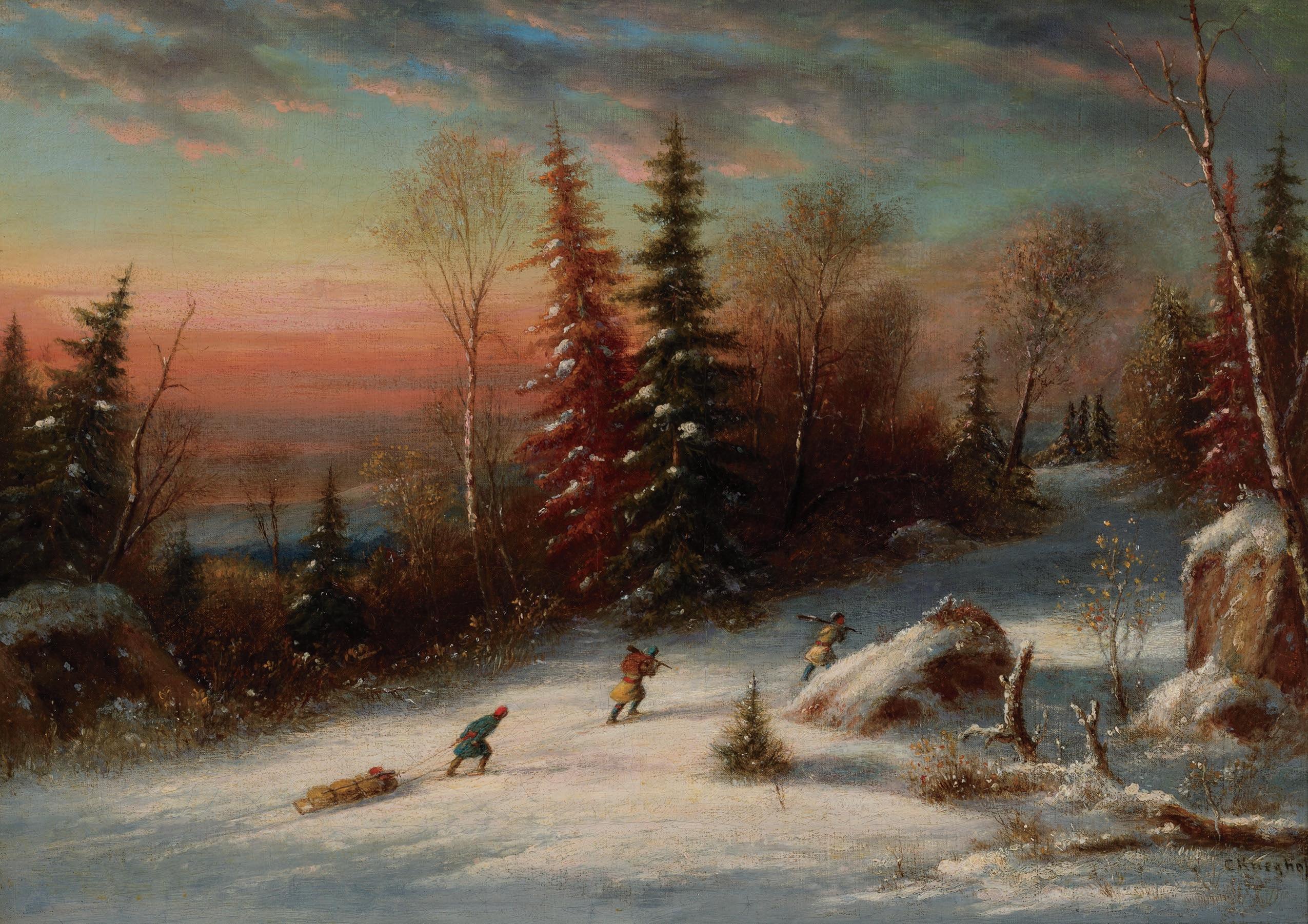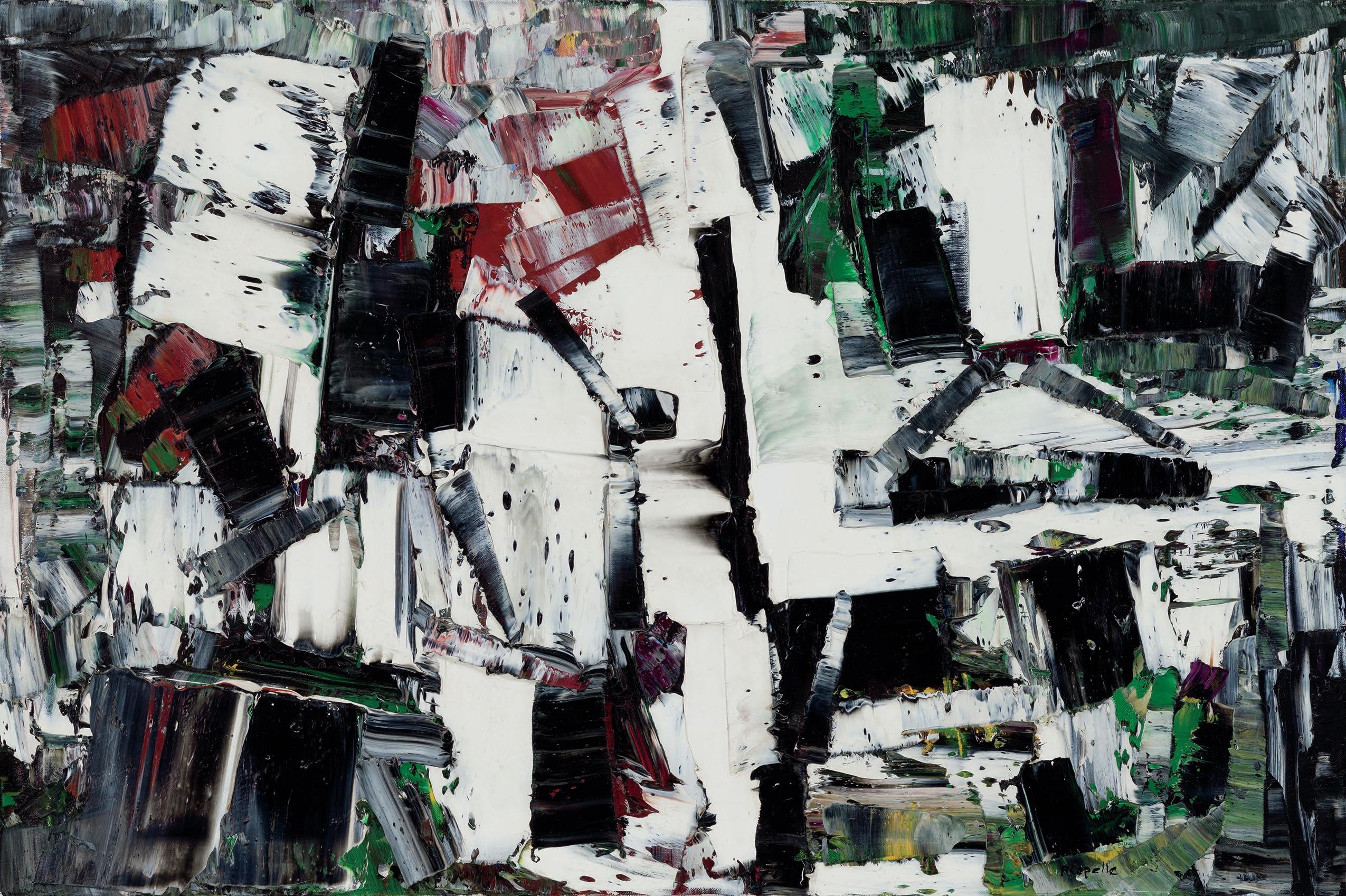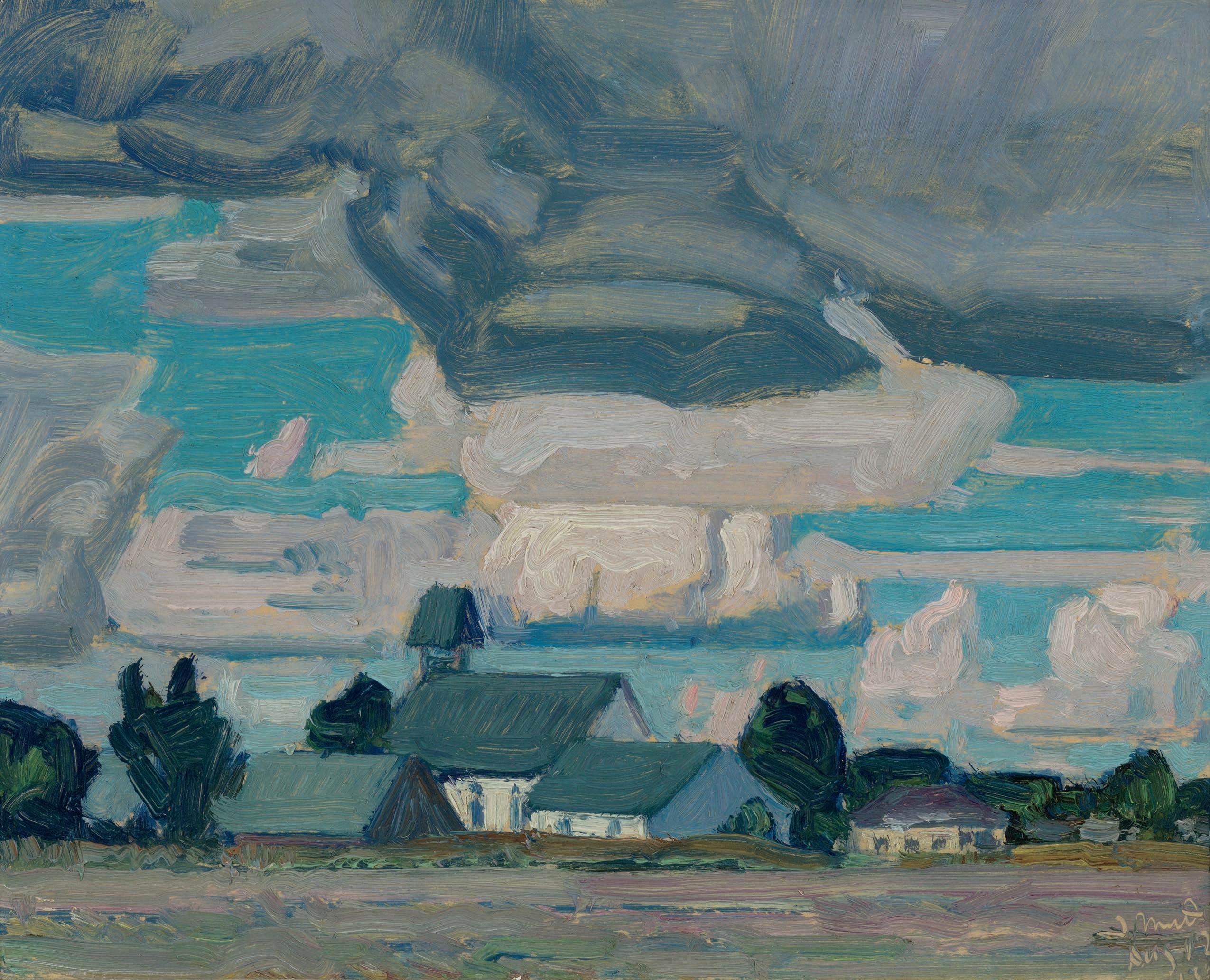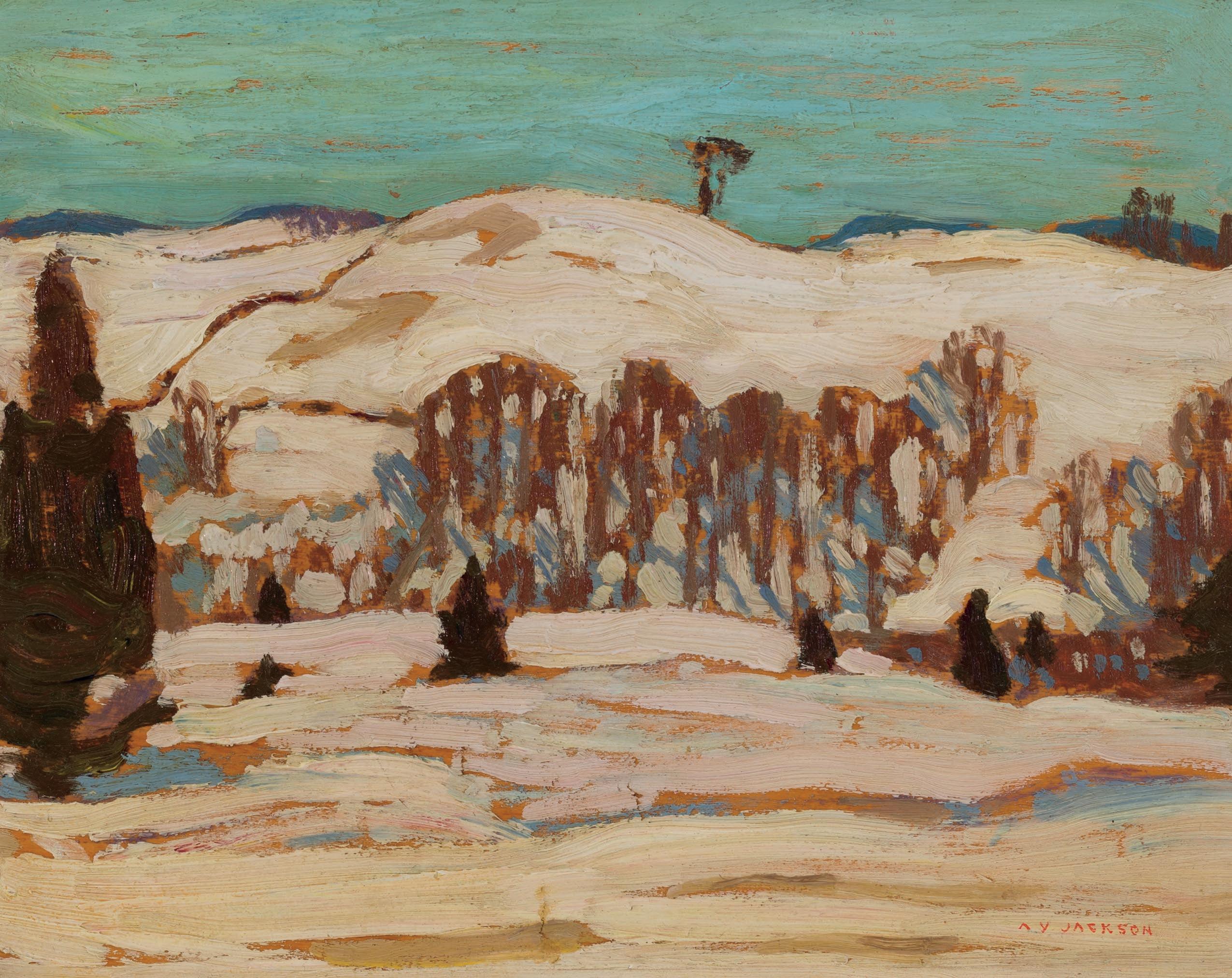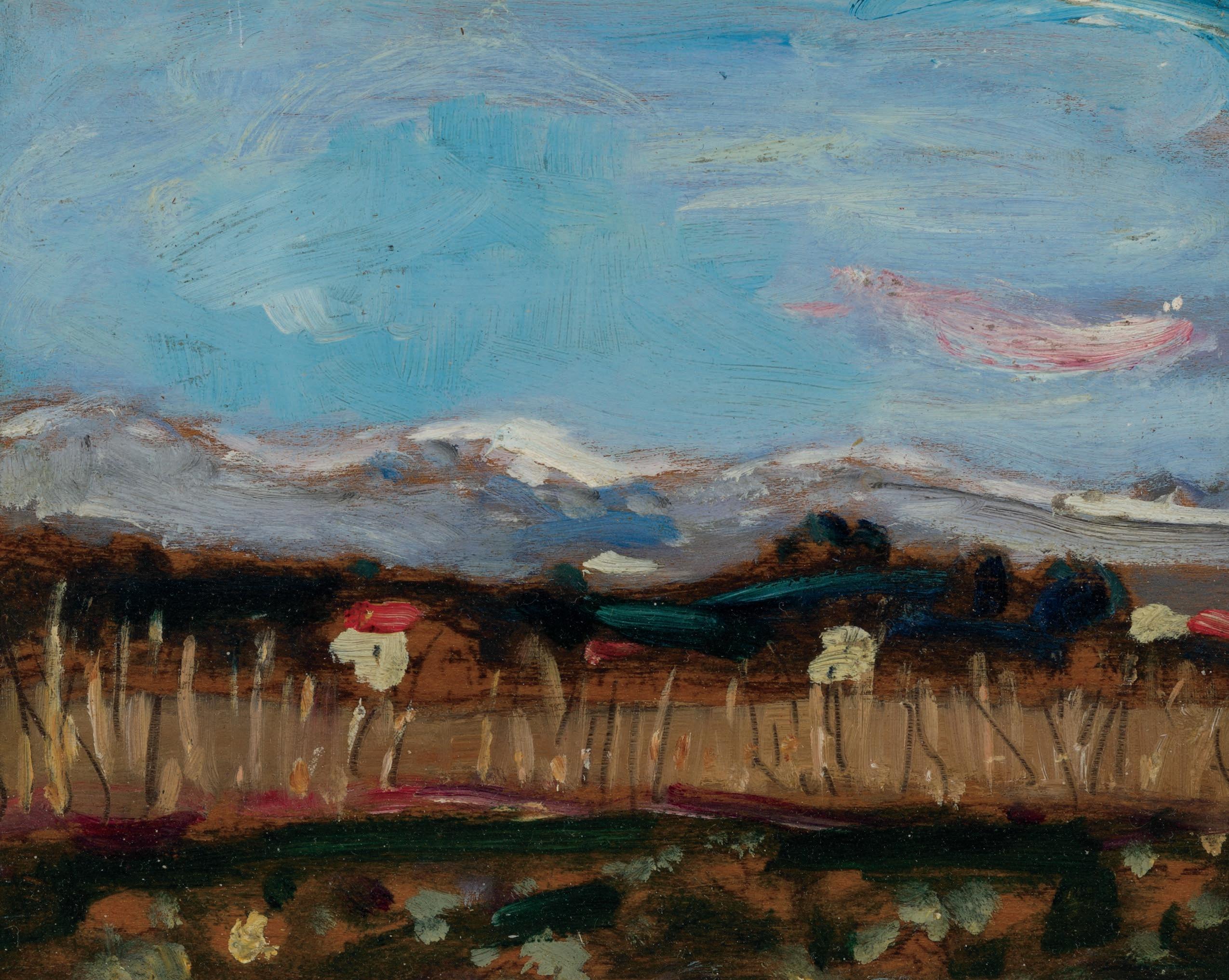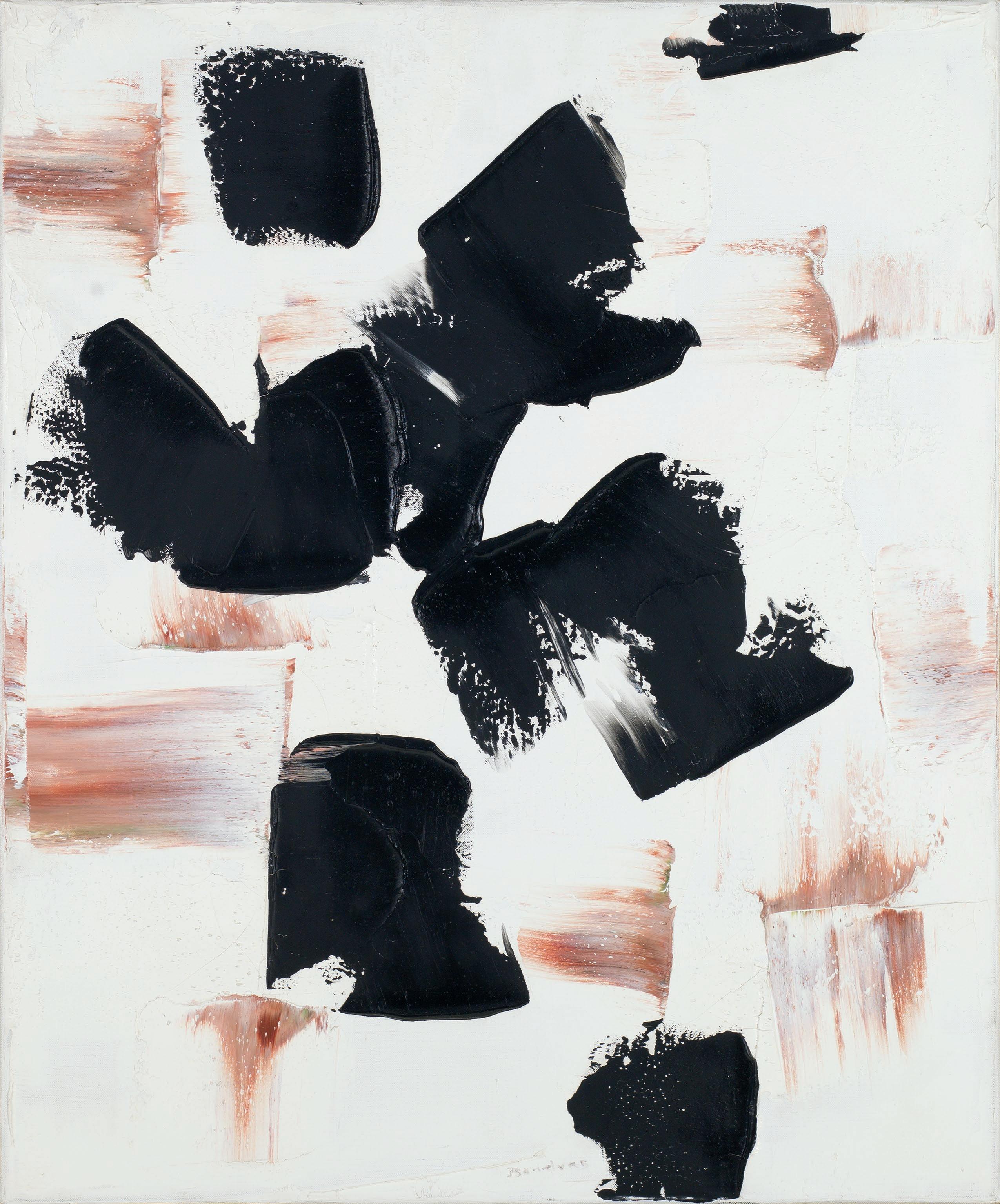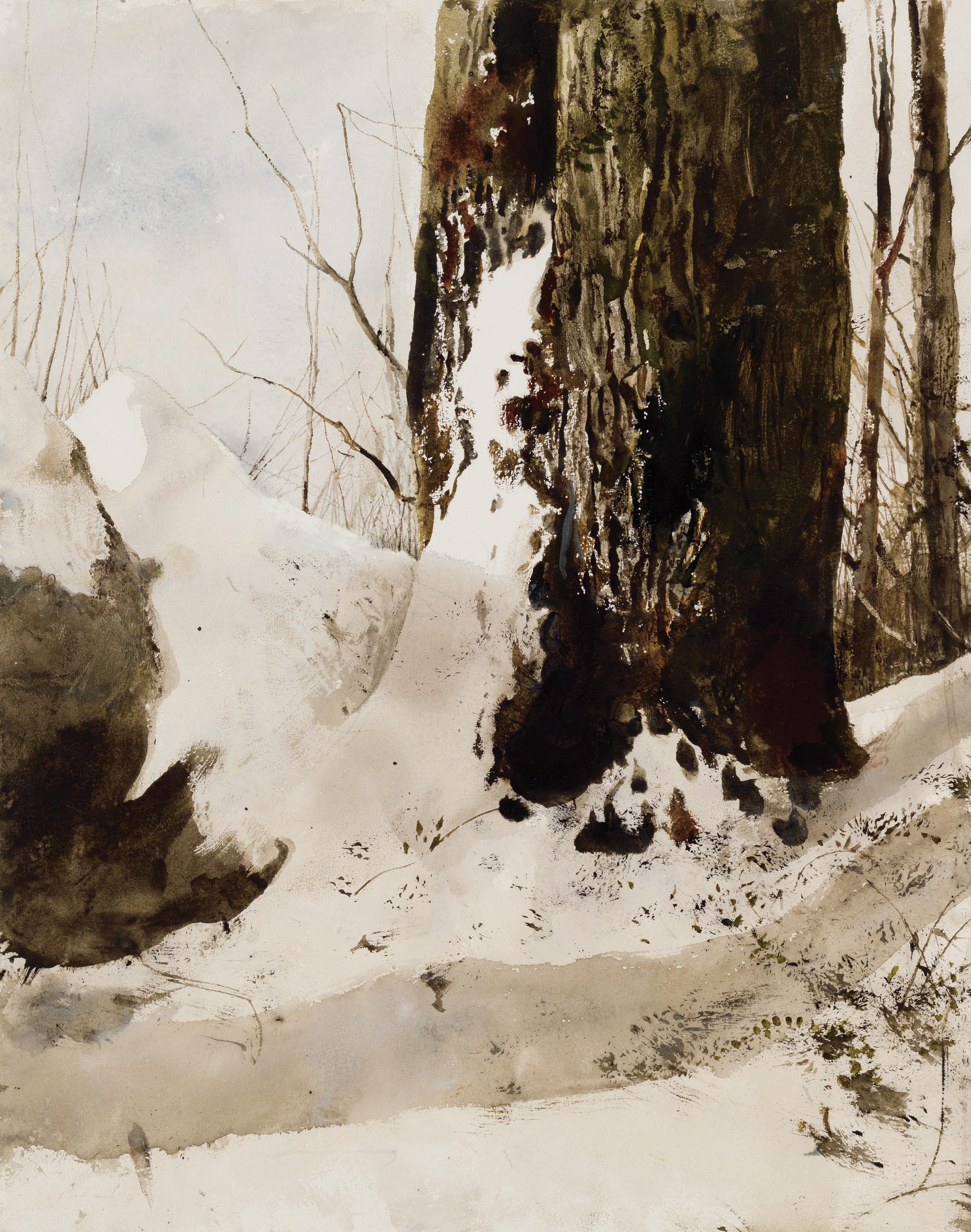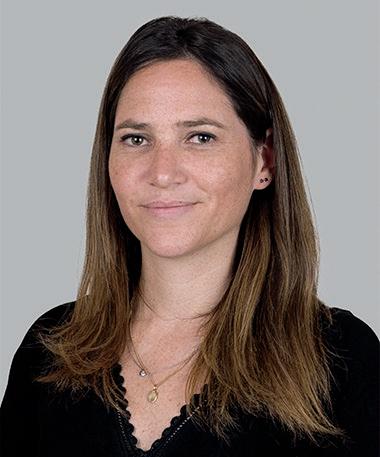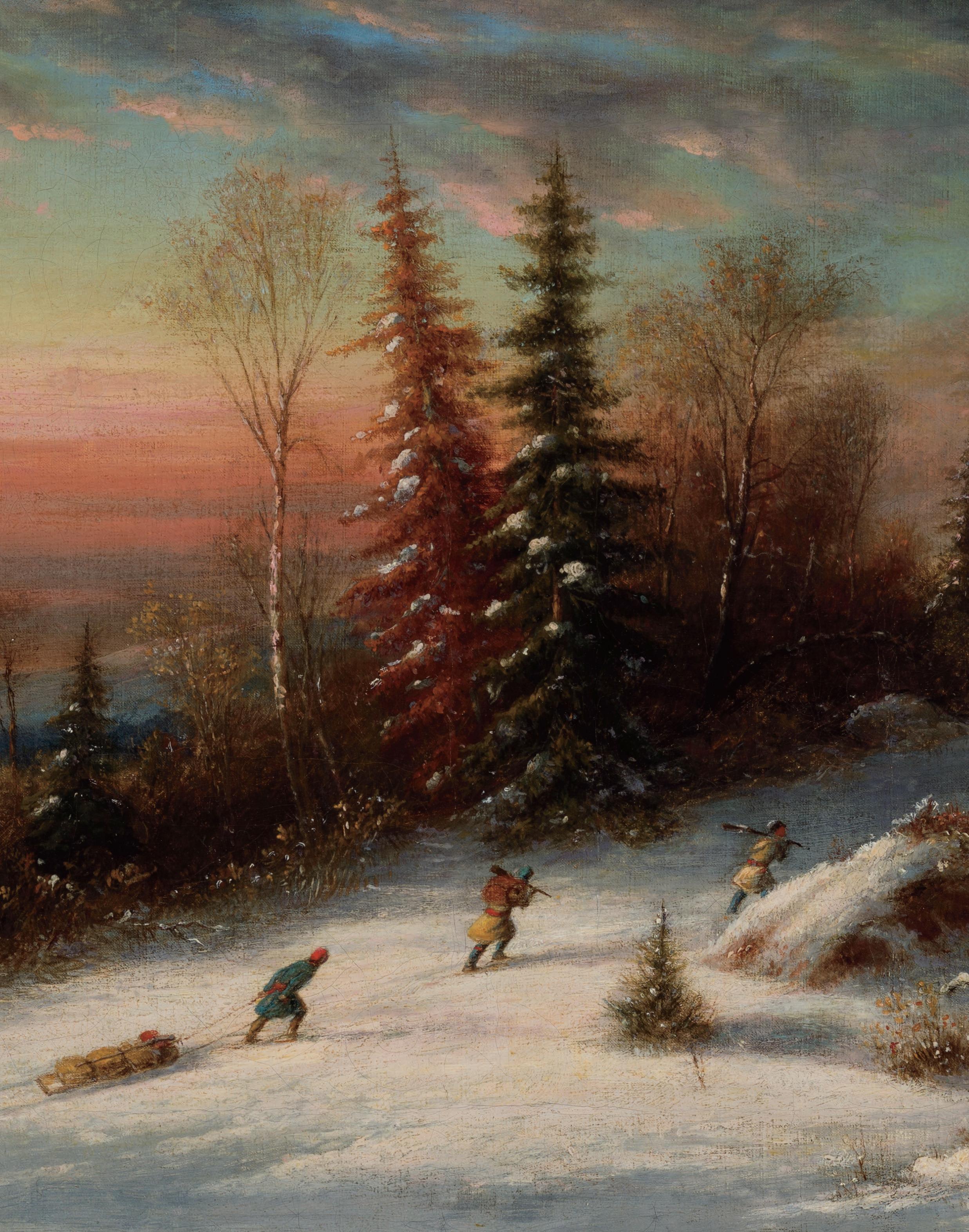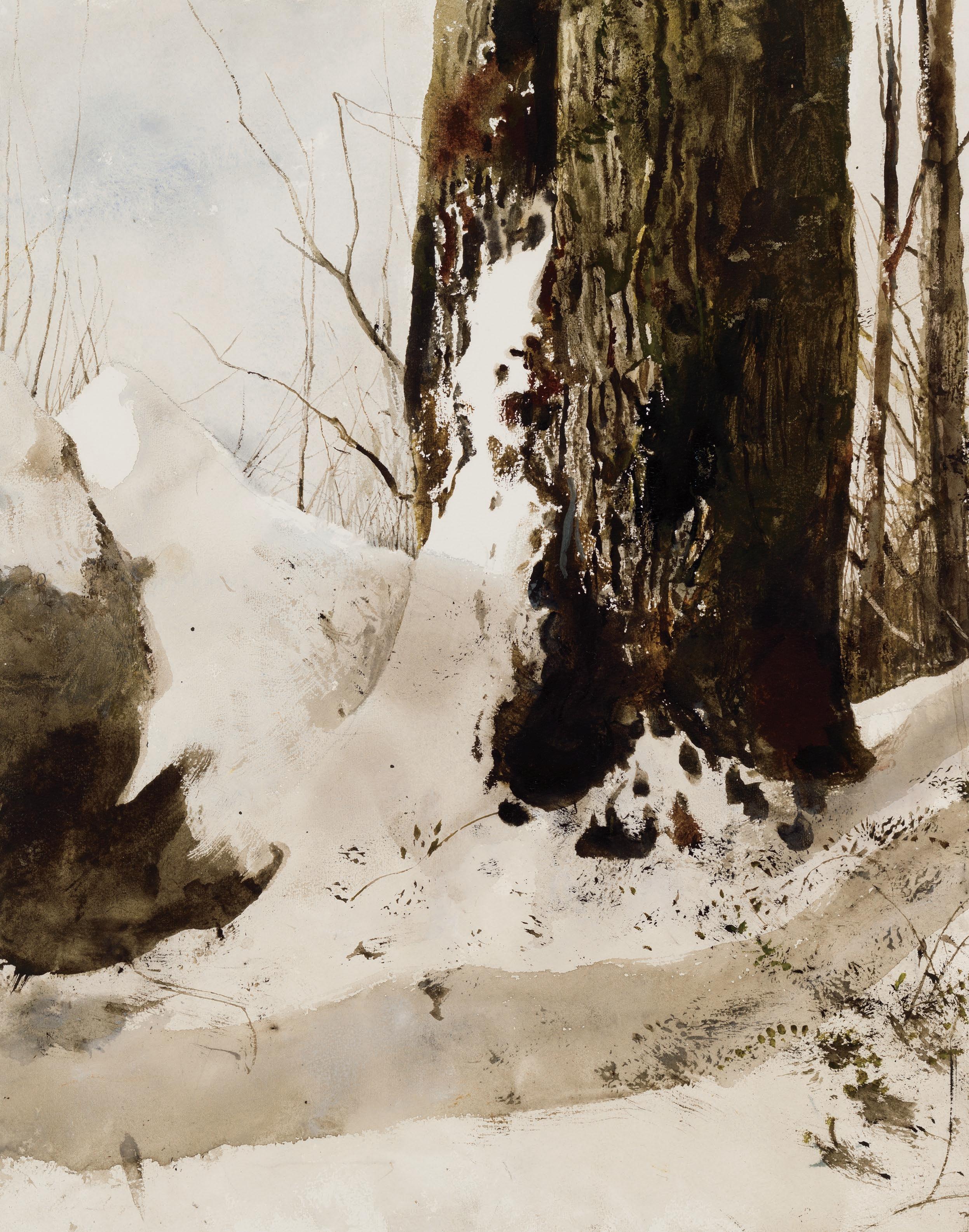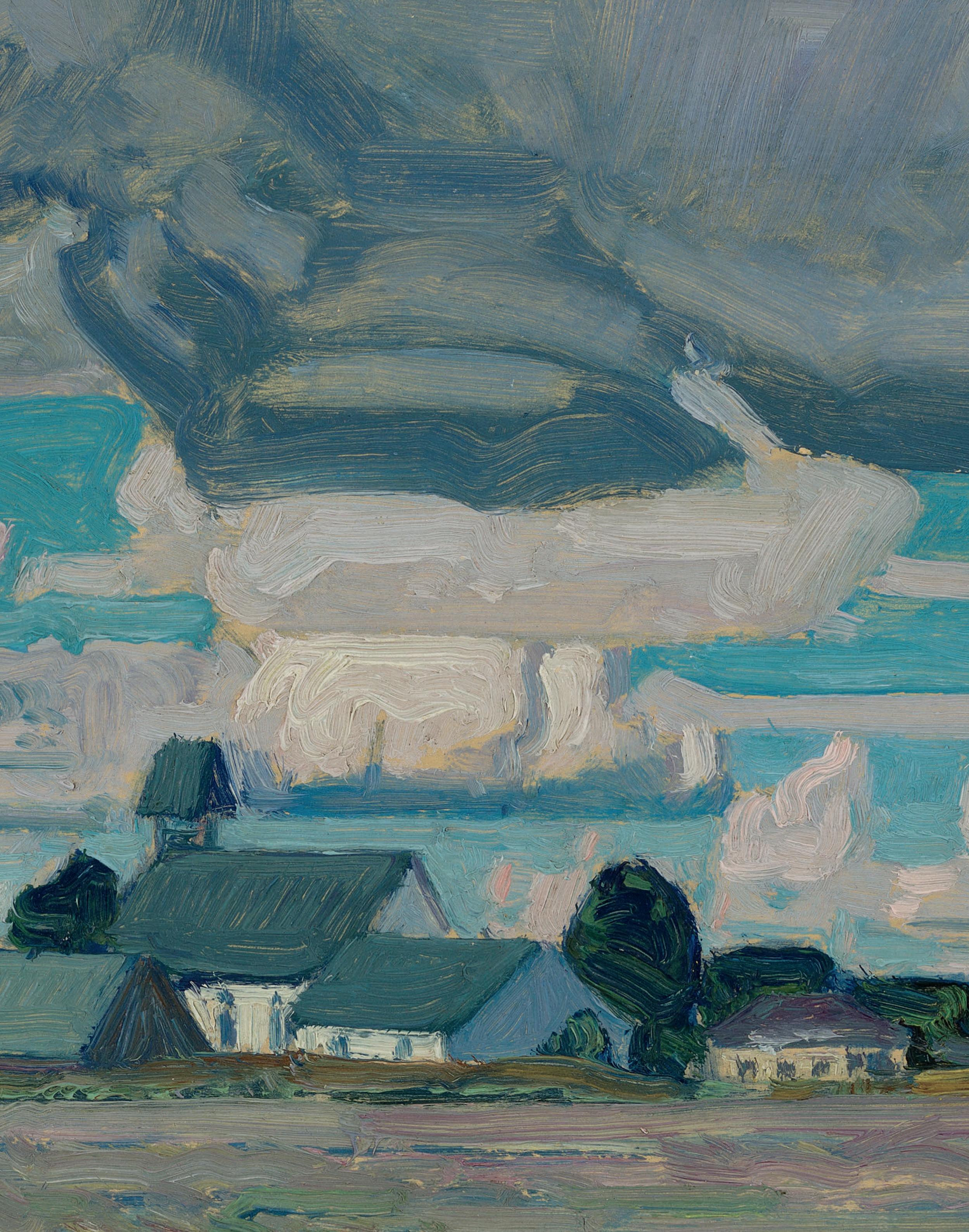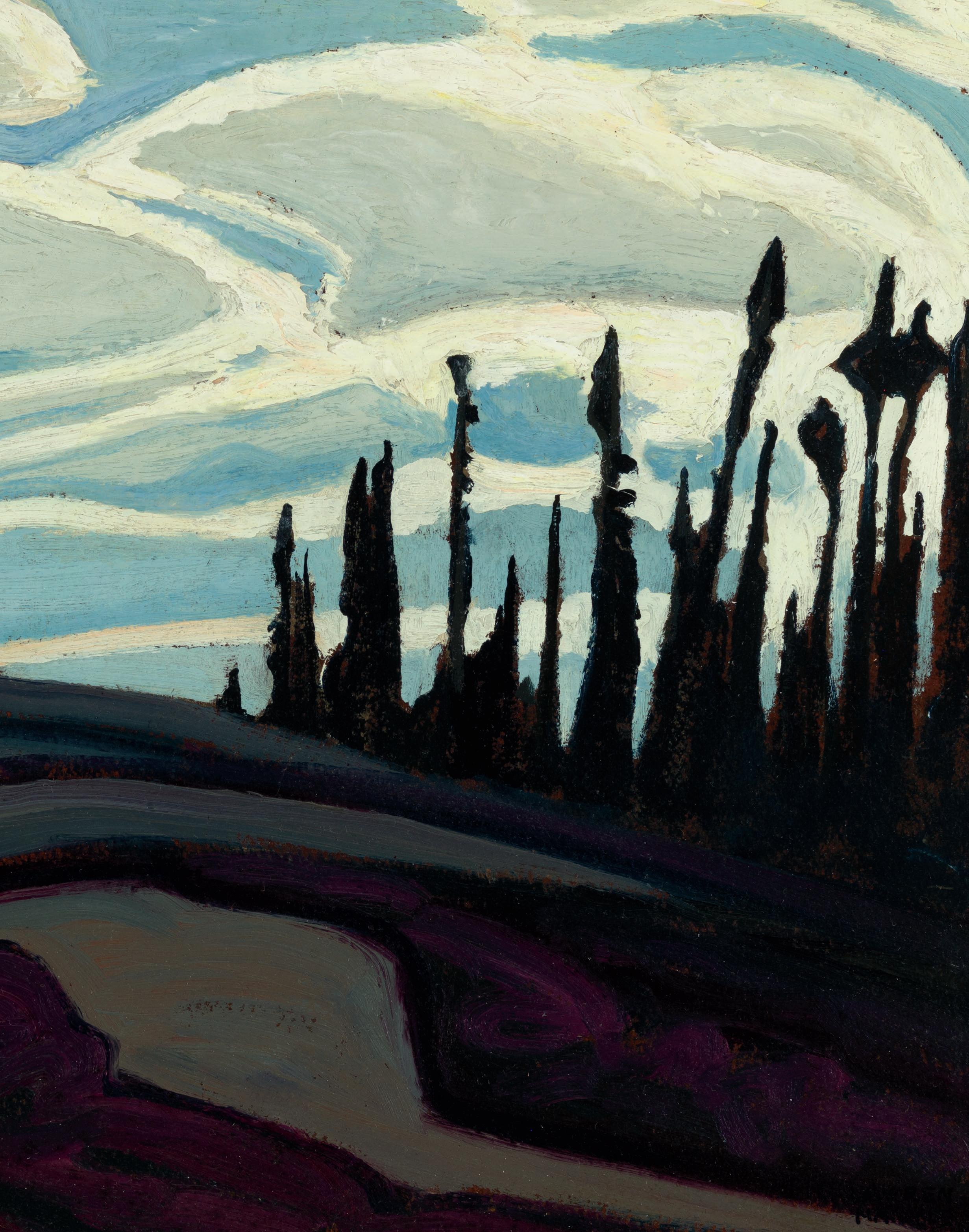i n m emori A m | t orben v . Kristi A nsen ( 1930 – 2023 )
Af TER HE HA d lived a life of fearless adventure, death came to close the eyes of my friend Torben V. Kristiansen at the age of 92.
TVK was how I knew him and how I referred to him since the day we met at his gallery, the Art Emporium, in Vancouver. He and I were fierce competitors in the art world but remained close friends for more than 40 years. His contribution to the Canadian art market was a tour de force that shaped the value of the artists he championed. My relationship with TVK , however, transcended the boundaries of the art world. It was a kinship founded on a shared passion for the arts, history and travel.
What I found unique to his personality was the valour with which he faced all the challenges that life and work brought to him. I witnessed his recovery from invasive surgeries, with a resolve to conquer the toll his body had undergone without a whisper of regret. It was an extension of the same resolve with which he conducted his business throughout his life, relishing his conquests and refusing to dwell on his losses. His confidence in both the pursuit of art and real estate had no rival.
TVK ’s zest for life was infectious, and his endeavours compelling. Of all the traits of his temperament, his sense of humour prevailed. It was this quality that drew me to his company in the many travels we undertook to destinations in Hawaii, California, Florida, New York and Europe. I witnessed an unknown side of his personality, his quest to pursue the finest in life—in food, wine, music and entertainment—everywhere we went. This was not merely a phase of his life, but rather a state of mind, a commitment to living life on his terms, unafraid to be misunderstood.
Undeterred by health challenges during the last two decades of his life, he remained active in both art and real estate enterprises with the same vigour he had exerted since his arrival in Canada as a young Danish immigrant over 65 years ago. He would reach out frequently to exchange views on art or issues of everyday life, always intersecting with a tale from his repertoire of humour, recounted with impeccable timing. In the autumn of his life, he built a home with Patricia, a kindred soul, who remained devoted to his care until the end.
With his passing, Canadian art lost one of its most ardent advocates, the last of a generation of art dealers who invested in the art they believed in and espoused for others. Dealers who were not only committed to purchasing and promoting art they supported but also took pleasure in enjoying it for themselves. Everyone’s life is a story. Each has an end. From romancing airplanes in the skies to climbing to the apex of the Canadian art market, the life of Torben V. Kristiansen was a remarkable journey, leaving a legacy that will persist for generations.
A.K. P RAKASH , CM , Toronto
TOP : Torben V. Kristiansen, 1972
Photo: Ray Allan, Vancouver Sun, a division of Postmedia Network Inc.
BOTTOM : Torben V. Kristiansen, Hawaii, circa 1965
Courtesy of the family of Torben V. Kristiansen
RIGHT : Lot 220, Sans titre by Paul-Émile Borduas
201 Bertram Charles (B.C.) Binning
BCSFA CGP CSGA OC RAIC RCA 1909 – 1976
Black Reflection
oil on canvas, signed and on verso titled and dated 1960 on the labels 26 × 35 in, 66 × 88.9 cm
Proven A nce
Jessie Binning, Vancouver
Estate of O.J. Firestone, Ottawa
Important Canadian Art, Sotheby’s Canada in association with Ritchie’s, May 26, 2008, lot 53
The Collection of Torben V. Kristiansen, Vancouver
B.C. Binning: A Retrospective, UBC Fine Arts Gallery, 1973, reproduced page 28 and listed page 35
e xhibited
UBC Fine Arts Gallery, Vancouver, B.C. Binning: A Retrospective, March 13 – 31, 1973, catalogue #51
I N THE l ATER 1950s, B.C. Binning began to move his work away from the more geometrical shapes that had dominated his painting during the previous decade. He devoted more time to drawing on the canvas and developed an interest in modulated surfaces that contain more than one colour. This newer interest is seen in the striking canvas Black Reflection, from 1960. Included in Binning’s first retrospective, the canvas relies on a more subtle handling of paint than what is often seen in the artist’s earlier works. Three areas employ mottled white and yellow, and a similar underlying texture is seen in the blue “sky.” This reading is contradicted by the large areas of flat colour—the expanse of yellow in the lower part of the composition and the two orange
sections, embraced by the slender black linear pattern that suggests the leading of a stained-glass window.
There are allusions to landscape: we see what appears to be a yellow sun in a dark blue sky, but the “landscape” below is more easily read as an abstract pattern. The black circle below the yellow sun may be the reflection alluded to in Binning’s title for the work. Clearly there are elements of landscape in this composition, but equally there are elements—the delicate linear pattern and the large flat colour areas—that are more easily read as abstraction. This very uncertainty displays Binning’s skills as a painter: he undoubtedly wants us to read the work as occupying a space between realism and abstraction. By doing so, the painting suggests and, at once, denies the third dimension.
Binning is distinctly aware of the power derived from this oscillation between suggestion and denial. The work has a strong decorative power but is firmly grounded in his appreciation of the natural world, which Binning both acknowledges and refutes in this image. Black Reflection reveals Binning’s understanding of nature and his admiration for the currents of abstraction, both of which this painting celebrates.
Binning was familiar with the history of modernist painting— his duties as a teacher made this knowledge essential for his work. At the same time, his deep affection for the outdoors (he was, for example, a keen sailor) has deeply inflected this work. The drama of the image is that it embraces both the natural world and abstraction.
We thank Ian M. Thom, Senior Curator—Historical at the Vancouver Art Gallery from 1988 to 2018, for contributing the above essay. Thom is the co-author of B.C. Binning, published in 2006.
e stim A te: $ 40,000 – 60,000
202 Bertram Charles (B.C.) Binning
BCSFA CGP CSGA OC RAIC RCA 1909 – 1976
Theme Painting oil on burlap, signed and dated 1953 and on verso signed, titled, dated and inscribed Vancouver— British Columbia—Canada
28 1/4 × 50 in, 71.8 × 127 cm
Proven A nce
Estate of O.J. Firestone, Ottawa
Important Canadian Art, Sotheby’s Canada in association with Ritchie’s, May 26, 2008, lot 64
The Collection of Torben V. Kristiansen, Vancouver
Liter A ture
B.C. Binning: A Retrospective, UBC Fine Arts Gallery, 1973, titled as Theme Painting, No. 3, reproduced page 29 and listed page 35
e xhibited
UBC Fine Arts Gallery, Vancouver, B.C. Binning: A Retrospective, March 13 – 31, 1973, catalogue #38
B ERTRAM C HAR l ES B INNING was one of the most important figures in the history of modernist painting in British Columbia. Born in Alberta in 1909, Binning moved to Vancouver, where he attended the Vancouver School of Decorative and Applied Arts (now Emily Carr University of Art + Design), graduating in 1932. After working as a teacher at his alma mater, Binning left to teach at the University of British Columbia in 1949. Initially he worked in the Department of Architecture and later, in 1955, helped to establish and headed the Department of Fine Arts (now the Department of Art History, Visual Art & Theory). By this time Binning’s work, although based in realism, was strongly abstracted. He painted images that emphasize both his sure sense of design and his command of colour, line and form.
Theme Painting is a fine example of Binning’s skills with design and colour. It also shows his ability to use the fairly intransigent surface of the unprimed burlap to his advantage. One of the most
striking elements of this image is Binning’s willingness to work in a way that seems to deny the precision of his geometric forms. The shifting pattern of his forms provides the whole surface of Theme Painting with a notable sense of animation. The visual vibrancy is seen in the various shapes that occur across the whole canvas.
The work contains only four paint colours—yellow, black, white, red. Binning also used the unprimed surface of the burlap itself as a secondary colour element. Despite this relative lack of colour, the composition, as a whole, has a lively and striking sense of rhythm. Take, for example, Binning’s use of black and white. He has used only these colours in three vertical columns spread across the composition: one slightly to the left of centre, one centrally in the right half of the composition, and a simpler column at the right edge of the work. A careful examination of these elements reveals that Binning never repeated himself—the circular forms within his black and white elements are never the same, and the lowest black forms are not even circular. In other words, the apparent symmetry of the composition is an illusion. It is this variety of shapes and the use of idiosyncratic line that give the whole composition visual vibrancy. The painting, despite the apparently static geometries, is never still. Like the surface of Binning’s beloved ocean, this composition always seems to be moving.
When Binning began to show his paintings in the late forties, he claimed an unusual territory in Canadian art. He produced paintings that are characterized by an exceptional sense of composition, a sure command of colour and a wonderful sense of visual delight.
Finally, it should be noted that the inscriptions on the stretcher are all by Binning himself.
We thank Ian M. Thom, Senior Curator—Historical at the Vancouver Art Gallery from 1988 to 2018, for contributing the above essay. Thom is the co-author of B.C. Binning, published in 2006.
e stim A te: $ 30,000 – 50,000
203 Jean Paul Riopelle
AUTO CAS OC QMG RCA SCA 1923 – 2002
Abstract Composition
oil on canvas, on verso titled and dated 1956 on the gallery labels, circa 1956
4 3/4 × 6 1/4 in, 12.1 × 15.9 cm
Proven A nce
Laing Galleries, Toronto
Private Collection
Canadian Art, Joyner Fine Art, November 20 – 21, 1990, lot 133
Kenneth R. Thomson, Toronto
A.K. Prakash & Associates Inc., Toronto
The Collection of Torben V. Kristiansen, Vancouver Liter A ture
Yseult Riopelle, Jean Paul Riopelle Catalogue Raisonné, Volume 2, 1954 – 1959, 2004, reproduced page 245, catalogue #1956.109 H V 1956
Jean Paul Riopelle Exhibition and Sale, Masters Gallery Ltd. in conjunction with The Art Emporium, 2016, reproduced page 23
e xhibited
Masters Gallery Ltd., Vancouver, Jean Paul Riopelle Exhibition and Sale, April 23 – May 7, 2016
E ’ S painterly style is often discussed in terms of expression, gesture, texture and colour palette. However, one lesser-mentioned aspect, and perhaps one of the most impressive, is his mastery of scale. Riopelle switches from larger to smaller scales with incredible ease, and without sacrificing his signature intensity, or the dynamism or complexity of his compositions. In fact, his more petite works are rather exquisite. Like jewellery boxes, they almost shimmer, thanks to the inherent glossiness of some of the pigments he used.
Handled with the same bravado as any larger canvas, Abstract Composition, dated circa 1956, packs an incredible punch. Tesserae-like touches of glossy black, ruby red, teal, chartreuse and luminous white paint are applied in a variety of directions and showcase the wide range of his visual vocabulary. The result is a remarkable choreography of texture, with colours densely packed within a discrete space. Each stroke of the palette knife is thoughtfully considered; we can feel the care with which he has executed this piece. Riopelle beckons us closer, drawing us in so we can truly and more intimately appreciate the scintillating and sensuous surface of Abstract Composition—an exceptional little gem.
The provenance of this painting is a sterling lineage of important figures in the Canadian art world—Blair Laing of Laing Galleries, Kenneth R. Thomson, A.K. Prakash and Torben V. Kristiansen.
e stim A te: $ 70,000 – 90,000
204 Gordon Appelbe Smith
BCSFA CGP CPE OC RCA 1919 – 2020
Untitled oil on canvas, signed twice, circa 1958
33 1/4 × 47 3/4 in, 84.5 × 121.3 cm
Proven A nce
Monica Bain, Vancouver and then Los Angeles Modern, Contemporary and Latin American Art, Bonhams & Butterfields, Los Angeles, November 17, 2009, lot 1052
The Collection of Torben V. Kristiansen, Vancouver
G OR d ON A PPE l BE S MITH , following his distinguished military service in the Second World War, enrolled in the Vancouver School of Art, from which he graduated in 1944. He then began a lengthy teaching career, initially at the Vancouver School of Art and later at the University of British Columbia. Smith’s career as an artist is marked by his long interest in both abstraction and the natural world. Indeed, some of his most distinguished work brings allusions to nature into compositions that are essentially abstract.
Untitled is a wonderful example of Smith’s ability to bring together natural allusions and a strong command of abstract form. The painting hints at Smith’s close observation of his environment—the black calligraphic forms suggest trees, but Smith has deliberately avoided specificity. Similarly, the central band of white pigment might be a patch of brightly lit ground, but equally acts as a formal element that divides the composition. What is clear is that the entire surface is animated by Smith’s sure brushwork, which activates the composition. The viewer’s eye is drawn to every part of the painting, and Smith’s vivid brushwork ensures that the viewer is never bored. Untitled vibrates with energy, with the black elements forming a staccato rhythm across the canvas. Smith’s use of colour has been equally acute—the bright patch of yellow and orange in the right foreground is brilliantly contrasted with the patches of purple and orange more centrally placed.
The work exudes an energetic vitality and suggests Smith’s strong affinity with the coastal landscape, while not clearly defining a subject. This deliberate ambiguity is part of Smith’s genius. While Smith never loses touch with the beauty of the natural world, which he deeply appreciated, he does not allow too great a specificity to impede our appreciation of his composition. Where some may see a highly abstracted landscape, the work can equally well be read as an entirely abstract composition.
The vitality of his brushwork means that the eye never rests in the work. The speed of our view across the canvas is controlled by the strong visual pattern of the black linear elements and the individual bursts of colour. In other words, Smith carefully guides our viewing of the canvas itself, speeding up the eye in some areas and slowing it down in others. While there is much activity on the surface of the canvas—look, for example, at the enormous variety of brush-strokes—the composition as a whole has a decisive unity.
Although we cannot precisely date this painting, it likely comes from the later fifties, a period when Smith and many of his colleagues were exploring abstraction. Of Smith’s work during this period, Group of Seven artist Lawren Harris wrote: “Here indeed is a true artist, whose work has the finest textural qualities, a restrained richness of colour values, the most satisfying paint qualities and the most forthright balance of all that goes to make a work of art satisfying and great.” 1 Harris’s words aptly describe Untitled
We thank Ian M. Thom, Senior Curator—Historical at the Vancouver Art Gallery from 1988 to 2018, for contributing the above essay. Thom is the author of Gordon Smith: The Act of Painting, published in 1997.
1. Lawren Harris, untitled note, November 1958, Gordon Smith files, Vancouver Art Gallery Library.
e stim A te: $ 30,000 – 50,000
205 Jean Paul Riopelle
AUTO CAS OC QMG RCA SCA 1923 – 2002
Sans titre
oil on canvas, signed and on verso signed, titled on a label, dated 1955 and inscribed #6203 on a label
28 1/2 × 36 in, 72.4 × 91.4 cm
Proven A nce
Pierre Matisse Gallery, New York Private Collection, Toronto
A.K. Prakash & Associates Inc., Toronto
The Collection of Torben V. Kristiansen, Vancouver
Liter A ture
Yseult Riopelle, Jean Paul Riopelle Catalogue Raisonné, Volume 2, 1954 – 1959, 2004, reproduced page 207, catalogue #1955.052 H .1955
Jean Paul Riopelle Exhibition and Sale, Masters Gallery Ltd. in conjunction with The Art Emporium, 2016, reproduced front cover (detail) and page 17
e xhibited
Masters Gallery Ltd., Vancouver, Jean Paul Riopelle Exhibition and Sale, April 23 – May 7, 2016
Ex ECUTE d IN 1955 , Sans titre is a prime example of Jean Paul Riopelle’s coveted mosaic period, so-called because the successive strokes of his palette knife, pressed down from above into layers of paint applied directly to the canvas, produced raised imprints resembling the tesserae of Byzantine mosaics. Riopelle’s canvases of this period are remarkable for their extraordinary energy and chromatic intensity, which he achieved by working rapidly, from pure instinct, relinquishing conscious control over the act of painting.
The results of his gestures were obscured from his field of vision, so his forms were always unstable and open, never planned or visible in advance. Each new application of paint evoked a new surprise and fresh inspiration. As Riopelle himself explained:
The painting must work itself out. It is a process. . . . I am not one of those artists seeking a wonderful green. . I never tell myself, that I have to paint like this or like that to get one effect or another. If I reach that point, I stop. It’s dangerous because then I am on the technical side of painting. There is always some solution to improve a painting that isn’t working. But this does not interest me. It loses its emotional unity.1
The present work is characterized by a swirling movement that bifurcates the canvas along the diagonal. Despite the abstracted arrangement of colour, form begins to cohere around the sombre earth tones punctuated by ribbons of bright scarlet and vivid green sweeping from left to right, and the enigmatic suggestion of a bird’s head in deep blue at upper left. We could be witnessing the bird about to take flight, sensing the movement of the air as it unfurls and beats its powerful wings, or perhaps the need to give pictorial form to clusters of sensations is a trick of the imagination. Certainly, even Riopelle’s most abstract works always bear ephemeral allusions to nature. As the French art historian Bernard Dorival suggests: “When we look at certain works by this artist, it is hard to resist saying that there is an unmistakable impression of forest, while others conjure up long-buried memories of fields and meadows.2
While Riopelle developed a unique and instantly recognizable style that was his own, his work contains the traces of his artistic forebears, for instance the pulsating whirls of van Gogh, the “constructive stroke” of Cézanne, which represented visual effects, and perhaps most importantly, the showers of pure colour that become increasingly abstract in late Monet. In the words of Jean-Louis Prat, “They are fragments of nature, these paintings of Riopelle, just as the Water Lilies painted by Claude Monet towards the end of his life are fragments of landscape, of water and of endless flowers, with neither landmark nor real boundary.”3
Today, Riopelle’s oeuvre is regarded by some art historians as among the most important of the second half of the twentieth century, far surpassing that of his contemporaries in Paris in the 1950s.4 Over the course of his career, he garnered multiple prestigious accolades including the UNESCO prize at the Venice Biennale in 1962, followed by the Order of Canada in 1969. His work is held in important collections internationally, including the National Gallery of Canada, the Tate in London, the Art Institute of Chicago and the Peggy Guggenheim Collection in Venice.
1. Quoted in Yseult Riopelle, Jean Paul Riopelle Catalogue Raisonné, vol. 1, 1939 – 1953 (Montreal: Hibou Éditeurs, 1999), 51.
2. Quoted in Jean Paul Riopelle and Denise L. Bissonnette, Jean Paul Riopelle (Montreal: Montreal Museum of Fine Arts, 1991), exhibition catalogue, 81.
3. Ibid., 12.
4. Riopelle, special issue of Connaissance des Arts, no. 179 (Montreal Museum of Fine Arts & Connaissance des Arts, 2002), exhibition catalogue, 5.
e stim A te: $ 300,000 – 400,000
206 Arthur Lismer
AAM CGP CSGA CSPWC G7 OSA RCA 1885 – 1969
Morning in the Forest, B.C.
oil on canvas board, signed and on verso signed, titled The Forest, B.C. and inscribed variously, circa 1952
20 × 16 in, 50.8 × 40.6 cm
Proven A nce
Walter Klinkhoff Gallery, Montreal, 1973
The Collection of Torben V. Kristiansen, Vancouver
Liter A ture
Dennis Reid, Canadian Jungle: The Later Work of Arthur Lismer, Art Gallery of Ontario, 1985, page 50 and reproduced page 88
e xhibited
Art Association of Montreal, Spring Exhibition, May 9 – June 18, 1952, catalogue #27
National Gallery of Canada, Ottawa, Arthur Lismer, 1954 – 1955, Western Art Circuit, traveling exhibition, catalogue #11
Art Gallery of Ontario, Toronto, Canadian Jungle: The Later Work of Arthur Lismer, September 28 – November 24, 1985, catalogue #61
Vancouver Art Gallery, date unknown
Morning in T he Fore ST, B.C is a classic example of Arthur Lismer’s work during his time in British Columbia, where he spent 16 summers. When sketching on site, Lismer would often flip his sketch box sideways so as to capture the verticality of the towering old-growth trees found on the very west coast of the country. Here, he successfully transfers the dramatic scale of the lofty trees but also the vibrant, lush growth of the forest bed onto his canvas board. Morning in the Forest, B.C. has been exhibited in museums across the country since its creation and was included in Dennis Reid’s important 1985 Art Gallery of Ontario exhibition Canadian Jungle: The Later Work of Arthur Lismer, which focused on works from this fruitful period. As described by Reid, “The dark trunks of trees—but with an occasional glimmering shard of sky—form a swag-curtain background to the tumbling jewel-like plants of the forest floor.” Morning in the Forest, B.C. is a dynamic work, alive with colour and vitality, the jungle-like environment of the coastal forest skilfully captured by Lismer’s expert hand.
e stim A te: $ 20,000 – 30,000
207 Arthur Lismer
AAM CGP CSGA CSPWC G7 OSA RCA 1885 – 1969
Temagami Shore
oil on board, on verso signed, titled, dated 1944 and inscribed with the Dominion Gallery inventory #E 240 on the gallery label and with the Art Emporium inventory #ST 960 and variously 11 3/4 × 15 3/4 in, 29.8 × 40 cm
Proven A nce
Dominion Gallery, Montreal
The Collection of Torben V. Kristiansen, Vancouver
A RTHUR lISMER’ S BRIGHT and colourful depictions of the Canadian North are brilliant reminders of the charm and vitality of the Ontario summer. Capturing both quiet moments and grand scenes alike, his sketches of the lakes and forests were often done while on holiday, which, according to his daughter, “meant physically transposing his family and studio to the great outdoors.” 1
Painted in August 1944, on the artist’s second trip to the region, Temagami Shore captures the intimacies of a warm, late-summer scene, filled with the colours and textures with which the artist had become so well acquainted. The work places the viewer directly into the tranquility of the shoreline setting, right on the rocks in the shallows and next to a tangle of branches and a partially submerged silver-white stump.
Lismer’s summer sketching trips would provide abundant material for him to work up onto canvases in the studio during the rest of the year. Temagami Shore was a work that clearly caught the artist’s eye, and in May 1945, he painted a 20 × 24-inch canvas based on it, entitled Temagami Backwater (sold by Heffel May 27, 2015, lot 113).
1. Marjorie Lismer Bridges, A Border of Beauty: Arthur Lismer’s Pen and Pencil (Toronto: Red Rock, 1977), front flap.
e stim A te: $ 20,000 – 30,000
208 Thomas John (Tom) Thomson
OSA 1877 – 1917
Tamarack Swamp
oil on panel, stamped with the estate stamp and on verso inscribed 1st class in Lawren Harris’s hand, Sketch #5 ,
Property of Harkness (crossed out) and variously and stamped with the estate stamp, fall 1915
8 1/2 × 10 1/2 in, 21.6 × 26.7 cm
Proven A nce
Estate of the Artist
Elizabeth Thomson Harkness, sister of the Artist, Owen Sound
Mellors Fine Arts, Toronto
Acquired from the above by a Private Collection, Ontario, 1939
Fine Canadian Art, Heffel Fine Art Auction House, May 22, 2008, lot 45
The Collection of Torben V. Kristiansen, Vancouver
Liter A ture
Harold Town and David P. Silcox, Tom Thomson: The Silence and the Storm, 1977, titled as Tamarack, reproduced page 167 and listed page 231
David Silcox, The Group of Seven and Tom Thomson, 2003, reproduced page 281 and listed page 421
Joan Murray, A Treasury of Tom Thomson, 2011, discussed page 74, reproduced pages 14 (detail) and 75
Ian A.C. Dejardin and Sarah Milroy, editors, Tom Thomson: North Star, McMichael Canadian Art Collection, 2023, reproduced page 109, listed page 266
e xhibited
Mellors Fine Arts, Toronto, Exhibition of the Work of Tom Thomson and J.E.H. MacDonald, February 1 – 18, 1939, catalogue #44
Galerie Eric Klinkhoff, Montreal, Tom Thomson: Annual Loan Exhibition, November 5 – 19, 2022, catalogue #22
McMichael Canadian Art Collection, Kleinburg, Tom Thomson: North Star, June 24, 2023 – January 14, 2024, traveling in 2024 to the Art Gallery of Alberta, Edmonton, and the Audain Art Museum, Whistler
T OM T HOMSON ’ S G l OWING Tamarack Swamp beguiles the viewer with its unassuming majesty. Its blue sky overcast with swirling grey and white clouds, dark hillside and swathe of golden tamarack growing on boggy land make it one of those works by Thomson that ignited his peers and delight Thomson lovers today. Observed with characteristic fidelity, it inspires as well as instructs. Lawren Harris inscribed his approbation on the back: “1st class,” he wrote. G. Blair Laing, the “Mr. Big” among Thomson’s early dealers, put it in a keynote show in 1939, and enthusiasts reproduced it in their books from the 1970s on; David Silcox dedicated a full page in colour to the work in his important monograph The Group of Seven and Tom Thomson in 2003. In 2023, the McMichael Canadian Art Collection, supported by Heffel, exhibited it in a major traveling show, Tom Thomson: North Star, and reproduced it in a handsome publication.
The scene in the work is set off by touches of red in the foreground and the brilliant golden colour of the tamaracks. Like all of Thomson’s work, the image carries not only conviction but
verso of lot 208
Tom Thomson, Algonquin Park, circa 1915
also certainty. As Harris said of the artist in the 1944 N f B documentary West Wind: “Tom Thomson had many of the qualities of genius as a painter a concentrated directness that went right to the heart of whatever he was painting and an easy and deft yet inspired skill in applying paint which drew from colour its maximum intensity.” 1 His words well describe the Thomson who painted this confident sketch.
In 1915, Thomson, if asked, might have replied that this confidence came from a conviction about the way his life was going. His paintings were in several important shows, he had artist friends, a girlfriend. The National Gallery of Canada had bought a major painting, Northern River. The sale provided him with funds to buy a new canoe, tent and camping supplies—and to take a camping trip.
That summer he canoed up the Magnetawan River to South River, and then went back again. He mentioned in a letter that there were stretches of country on the return journey “mostly Burnt over.” 2 Perhaps he got the idea for Tamarack Swamp on this return trip—tamaracks are a common pioneer among trees that grow immediately after a fire. He would have painted this sketch after he got back to his base camp in Mowat around Labour Day.
Among the inscriptions on the back of the work is “Sketch #5.” It possibly refers to a list drawn up by Blair Laing and his father of the first group of over 30 sketches they purchased from Thomson’s estate for Mellors Fine Arts Ltd. in Toronto (later the gallery was renamed Mellors-Laing and then Laing Galleries). These purchases occurred after the gallery’s comprehensive loan exhibition of the work of Tom Thomson in 1937, celebrating the diamond jubilee of Thomson’s birth.3 Only three paintings and one watercolour were for sale in the show of 90 works.4 After the show, recognizing Thomson’s importance, the two men began to buy his work in volume. In the end, they handled and sold for the Thomson family every one of the pictures in Thomson’s estate, recalled Blair Laing.5
Tamarack Swamp was one such work. It was acquired by Mellors and shown in the Exhibition of the Work of Tom Thomson and J.E.H. MacDonald at the gallery in February 1939. A collector in Ontario acquired it from the Mellors show, and he and his family kept it until 2008, when Heffel sold it to the canny dealer Torben V. Kristiansen, owner of the Art Emporium in Vancouver.
The Art Emporium sold many works by Thomson, notably Moonlight, Fall (1915, private collection), but Kristiansen could not bring himself to part with Tamarack Swamp. He counted it among his many treasures, probably fascinated by its directness and liveliness, so characteristic of Kristiansen himself.
We thank Joan Murray, former curator of Canadian art and chief curator (1972) at the Art Gallery of Ontario, for contributing the above essay. Murray helped to bring the paintings of Tom Thomson to world attention through a series of exhibitions and seven books, including a biography (the most recent is A Treasury of Tom Thomson). Murray is the author of the Tom Thomson Catalogue Raisonné.
This work is included in the Tom Thomson catalogue raisonné, researched and written by Murray, as catalogue #1915.106: https://www.tomthomsoncatalogue.org/catalogue/entry. php?id=385.
1. Quoted in West Wind, directed by Graham McInnes, Canadian Artist Series No. 2, National Film Board of Canada, 1944.
2. Tom Thomson to Dr. J.M. MacCallum, September 9, 1915, MacCallum Papers, National Gallery of Canada Archives, Ottawa.
3. Loan Exhibition of Works by Tom Thomson, Mellors Galleries, Toronto, March 13 – 31, 1937. See also G. Blair Laing, Memoirs of an Art Dealer, vol. 1 (Toronto: McClelland & Stewart, 1979), 72.
4. Laing, Memoirs, 72.
5. Ibid., 74.
e stim A te: $ 1,200,000 – 1,600,000
Installation views of Tom Thomson: North Star, Audain Art Museum, Whistler, BC , 2024, with Tamarack Swamp indicated
209 Frederick Horsman Varley
ARCA G7 OSA 1881 – 1969
Clouds and a Tree oil on board, signed faintly and on verso signed twice, titled, inscribed End of Autumn c. 1940 by Peter Varley and Varley v.3 on a label and stamped Varley Inventory no. 720 11 7/8 × 15 in, 30.2 × 38.1 cm
Proven A nce
Edgar and Dorothy Davidson, Montreal and then Ottawa Fine Canadian Art, Heffel Fine Art Auction House, May 17, 2011, lot 121
The Collection of Torben V. Kristiansen, Vancouver
e xhibited
Art Association of Montreal, Contemporary Art Society, Art of Our Day in Canada, November 22 – December 15, 1940
W HEN fRE d ERICK VAR l E y moved to Vancouver in 1926, the richness of the atmosphere there—the lush, humid climate, the rich greenery and the ocean at his door—inspired his sense of colour. It was there that his palette took on new hues: beautiful blends of blue and green, purple and gold. This sensual use of colour would remain a key part of his work from that time on, and Clouds and a Tree is a perfect example of this, being concerned purely with colour. Varley had returned to Ottawa by 1936, and Clouds and a Tree was likely painted in Trenton, Ontario. The painting shows us Varley’s practice of blending colour directly on the surface of his work; the gradated hues of red and purple in the rock to which the tree clings and in the distant hills are bold experiments.
This painting has been held in two successive important Canadian collections. It was first in the historic collection of Edgar and Dorothy Davidson, who lived in Montreal and then Ottawa. The Davidsons started to build their important collection in the 1940s, and they were early champions of Canadian creativity and artistic expression. Heffel was honoured to bring their collection to market in 2011, when this work was acquired by the legendary and astute Torben V. Kristiansen.
e stim A te: $ 25,000 – 35,000
210 Thomas John (Tom) Thomson
OSA 1877 – 1917
Winter Morning
oil on panel, stamped with the estate stamp and on verso signed, titled, dated Spring 1915 in Dr. J.M. MacCallum’s hand, inscribed
Not for sale in Lawren Harris’s hand, No. 152, Mrs. Harkness and variously and stamped with the estate stamp, spring 1915
8 7/16 × 10 1/2 in, 21.4 × 26.7 cm
Proven A nce
Estate of the Artist
Elizabeth Thomson Harkness, sister of the Artist, Owen Sound
R.A. Laidlaw, Toronto
Libby’s Art Gallery, Toronto
Private Collection, Toronto
Canadian Art, Joyner / Waddington’s, November 24, 2009, lot 75
The Collection of Torben V. Kristiansen, Vancouver
Liter A ture
Joan Murray, A Treasury of Tom Thomson (limited edition of 15), 2011, reproduced front cover
Joan Murray, A Treasury of Tom Thomson, 2011, discussed page 40, reproduced page 28 (also verso of work) and page 41
Ian A.C. Dejardin and Sarah Milroy, editors, Tom Thomson: North Star, McMichael Canadian Art Collection, 2023, reproduced page 222 and listed page 267
e xhibited
Art Gallery of Toronto, Sketches on Exhibition at the Art Gallery of Toronto, October – November 1949, catalogue #42
Canadian National Exhibition, Toronto, Private Collectors’ Choice in Canadian Art, sponsored by the Canadian Cancer Society, August 1959
Galerie Eric Klinkhoff, Montreal, Collectors’ Treasures: Annual Loan Exhibition, October 19 – November 2, 2019, catalogue #50
McMichael Canadian Art Collection, Kleinburg, Tom Thomson: North Star, June 24, 2023 – January 14, 2024, traveling in 2024 to the Art Gallery of Alberta, Edmonton, and the Audain Art Museum, Whistler
Installation views of Tom Thomson: North Star, Audain Art Museum, Whistler, BC , 2024, with Winter Morning indicated
T OM T HOMSON ’ S Win T er Morning is a remarkable evocation of a wintry world. Heavy snow lies on the ground and trees. It is early morning, as indicated by the touches of yellow in the patches of visible sky and the very slight yellow on some of the tree branches. In the work, Thomson used blues, greys and whites picked out by deeper blue to create a sense of quietude and enchantment. The viewer feels instinctively that the scene must have been almost entirely silent.
Thomson’s love of colour served as his inspiration. By reflecting light, snow offers rich and changing possibilities of hue, like a prism. He probably had been encouraged by Lawren Harris in painting snow. Harris, together with J.E.H. MacDonald, head of the design section, Thomson’s section, at Grip Ltd., had seen an exhibition titled Contemporary Scandinavian Art in 1913 at the Albright Art Gallery (now the Buffalo AKG Art Museum). Paintings of snow by Gustaf Fjaestad and others featured in the show.1 Harris and MacDonald would have shared their excitement over their discoveries with Thomson.
For Thomson and others, snow was already a theme that spoke of the nation. Canada was often called at the time “Our Lady of the Snows.” The phrase was derived from an 1897 poem by Rudyard Kipling, one of the poets Thomson loved and liked to read.
Thomson arrived in Algonquin Park in mid-March 1915 when snow was deep on the ground. On April 28, he guided a fishing party and had to stop painting for a time. The sketch would have been done between these two dates, though likely in March when the snow was still heavy. Winter Morning makes it clear that he loved the subject of snow and the colours it takes on in the light. He returned to the subject in the fall of 1916 to paint several sketches and a major canvas, Snow in October (collection of the National Gallery of Canada, accession #4722).
Thomson knew this sketch was good. Although he did not sign his sketches as a rule, he signed and titled this one on the back. Dr. J.M. MacCallum, friend and patron of Thomson and the Group of Seven, dated it. Harris, ever watchful over Thomson’s work, endorsed it by adding on the back “Not for sale.” He underlined the words and added “Laidlaw,” meaning that the sketch had been reserved for friends, the brothers Walter and Robert A. Laidlaw, wealthy businessmen and sons of the founder of the R. Laidlaw Lumber Company.
The brothers loved the painting as they loved all of Thomson’s sketches, and although they sometimes owned Thomson’s sketches jointly, Robert loved it so much that he bought it. He became in time one of the most generous donors of Thomson works, making gifts of sketches to the McMichael Canadian Art Collection in Kleinburg, the Art Gallery of Alberta, and Upper Canada College in Toronto. Culture, health care and education were his major concerns as a philanthropist, and in 1949, he and his family founded the Laidlaw Foundation, which continues his good work.
Torben V. Kristiansen bought Winter Morning at auction in 2009. It became one of the favourites in his collection, so much so that he arranged for it to be used as a cover for a special edition of a book titled A Treasury of Tom Thomson (2011). Only 15 copies of this edition were printed, reserved for Kristiansen’s closest friends among his clients, but as in the regular edition of the book, the writer discussed the sketch and reproduced the inscriptions on the back. Today, Winter Morning appears again in
the monumental Thomson show and catalogue by the McMichael Canadian Art Collection, Tom Thomson: North Star, which pays tribute to Thomson’s art in the oil sketch format (always a favourite).
That catalogue reproduces Thomson’s many sketches of snow in 1915 and 1916. The later works are perhaps more clearly structured than Winter Morning, but there is something exuberant about this sketch that speaks well of Thomson’s excitement over the subject. He wrote his father in April 1917 from Algonquin Park that he expected to get a lot more winter sketches before the ice and snow were gone.2 Sadly enough, he never saw another winter. He died in the summer of 1917.
We thank Joan Murray, former curator of Canadian art and chief curator (1972) at the Art Gallery of Ontario, for contributing the above essay. Murray helped to bring the paintings of Tom Thomson to world attention through a series of exhibitions and seven books, including a biography (the most recent is A Treasury of Tom Thomson). Murray is the author of the Tom Thomson Catalogue Raisonné.
This work is included in the Tom Thomson catalogue raisonné, researched and written by Murray, as catalogue #1915.05: https:// www.tomthomsoncatalogue.org/catalogue/entry.php?id=284.
1. A photocopy of J.E.H. MacDonald’s marked copy of the catalogue is in the Edward P. Taylor Library & Archives, Art Gallery of Ontario, Toronto.
2. Tom Thomson to his father, April 16, 1917, Tom Thomson Papers, MG 30 d 284, Library and Archives Canada, Ottawa.
Quoted in Joan Murray, “Tom Thomson’s Letters,” in Tom Thomson, ed. Dennis Reid and Charles C. Hill (Vancouver: Douglas & McIntyre, 2002), 303.
e stim A te: $ 1,000,000 – 1,500,000
211 Cornelius David Krieghoff
1815 – 1872
Indian Hunters in a Winter Landscape oil on canvas, signed and on verso titled on a partial Roberts Gallery label 13 × 18 in, 33 × 45.7 cm
Proven A nce
Roberts Gallery, Toronto Canadian Art, Joyner / Waddingtons, November 28, 2006, lot 63
The Collection of Torben V. Kristiansen, Vancouver
Liter A ture
Hugues de Jouvancourt, Cornelius Krieghoff, 1971, titled as Indian Hunters, reproduced page 10
C ORNE l IUS K RIEGHO ff’ S COMPOSITION clearly shows three Indigenous hunters traversing a winter landscape. All the figures wear a colourful woven ceinture fléchée at their waists and travel on snowshoes. The two leading figures each carry rifles on their shoulders. The third man’s rifle rests on the sled that he pulls. The men are wrapped warmly against the cold, and care has been taken to precisely illustrate their costumes and weapons.
The three figures appear in the centre of the image, which Krieghoff has flooded with light. These Indigenous hunters are not, however, the main subjects of the painting. Krieghoff’s real interest, as he works in his studio, is the majesty of nature rather than the doings of man. One cannot help but be struck by how small these hunters are within the expanse of the landscape. The attention Krieghoff has paid to the rocks and bare trees at the right side is notable, and he seems to have devoted as much attention to painting the small evergreen in the centre of the composition as he has to the three figures.
The pattern of sunlight and shadow on the snow is more compelling than the details of the Indigenous men’s clothing. The complexities of light in this image are striking—brilliant sunshine and the bright orange sky, which intimates the sun setting. The clouds, touched by sunlight, scud across the sky, suggesting more movement than the walking figures. Again, while Krieghoff has been careful to ensure that the figures are highlighted within the sunlit landscape, the drama lies not with them but in the natural world. Look at the variety of trees, both deciduous and coniferous, the drama of the sky, and the remarkable array of trees and rocks in the right foreground. Krieghoff obviously appreciates the richness and variety of the natural world and has been eager to

represent it in this work. The fact that he had to create or recall this natural world in his studio rather than painting it directly makes this image that much more interesting. It is the natural world, but the world as conjured by Krieghoff in his studio. That his images have so deeply defined our understanding of nineteenth-century Canada is a mark of his importance in the history of painting in Canada.
e stim A te: $ 50,000 – 70,000
detail of lot 211
212 Jean Paul Riopelle
AUTO CAS OC QMG RCA SCA 1923 – 2002
Nuit laiteuse
oil on canvas, signed and on verso titled, dated 1960 and inscribed with the Pierre Matisse inventory #St. 4290 on the gallery label, STB 253 / 16262 / 62 (twice) and variously 24 × 36 in, 61 × 91.4 cm
Proven A nce
Pierre Matisse Gallery, New York Laing Galleries, Toronto
The Collection of Torben V. Kristiansen, Vancouver
Yseult Riopelle, Jean Paul Riopelle Catalogue Raisonné, Volume 3, 1960 – 1965, 2009, reproduced page 76, catalogue #1960.005 H .1960
Guy Robert, Riopelle, Chasseur d’image, 1981, reproduced page 98
e xhibited
Glenbow Museum, Calgary, Variations: 50 Years of Canadian Art, March 18 – June 4, 2006
Masters Gallery Ltd., Vancouver, Jean Paul Riopelle Exhibition and Sale, April 23 – May 7, 2016
Galerie Eric Klinkhoff, Montreal, Collectors’ Treasures: Annual Loan Exhibition, October 19 – November 2, 2019, catalogue #44
J EAN PAU l R IOPE ll E ’ S Nuit laiteuse is an evocative expression of a night landscape that highlights the tension between abstraction and figuration at the heart of his practice in the early 1960s. Nuit laiteuse, or Milky Night, initially presents as a masterful work of abstraction, with broad, gestural swathes of impasto applied with the palette knife forming interlocking structures of stark black and white. A vivid white architecture dominates the composition, its vertical and horizontal axes colliding at dead centre of the canvas. While white traditionally suggests absence or empty space, here it takes on weight and density through the thick application of paint, becoming three-dimensional and playing with the viewer’s perception of spatial depth.
Riopelle experimented with white throughout the late 1950s, using it to structure, to draw and to define space. In the words of art historian Pierre Schneider: “Black and white: these pre-eminent tools of drawing, he employs as a painter. When he works the surface with a knife, as is his habit, their shades are infinite, their potential is boundless. . .” 1 In Nuit laiteuse, Riopelle deploys diagonal shards of greyscale to break up the composition, like fractured rays of light. These create movement and give the painting a vital, kinetic quality, propelling the eye around the canvas in multiple directions.
At the same time, as its title suggests, Nuit laiteuse vividly evokes the sensation of entering a moonlit northern landscape in winter: its starkness and chill, the oppressive density of the forest, the open expanses of snow illuminated by the moon and stars. White and black become shades of snow, ice and the night sky. Flashes of colour—saturated greens and earth tones—echo throughout the work like glimpses of towering firs and cedars or the richness of the forest floor. Scattered jewel-toned highlights punctuate the otherwise restrained palette with glints of sapphire and amethyst, while along the upper-left edge of the canvas, hemmed in by the encroaching darkness, shimmering striations of pastel colours appear, like a fading sunset or an aurora borealis.
The result is not a physical representation of the forest by night but rather a fleeting impression or a feeling. Jean-Louis Prat, director of the Fondation Maeght, recalls Riopelle’s “remote but penetrating gaze, quick to capture an instant out of a mass of movement where nothing seemed distinguishable. An amazing show put on by nature at nightfall, in a boundless space where the painter appeared to register the smallest fluttering.” 2
By 1960, Riopelle had already reached the pinnacle of success with his mosaic paintings. However, never one to repeat himself with formulaic approaches, he continued to innovate, setting himself new visual challenges and experimenting with painterly techniques. Nuit laiteuse is illustrative of Riopelle’s evolution during this period: the kaleidoscopic palette of the mosaic paintings has been stripped back, allowing the artist to explore the possibilities of black and white. Likewise, the dense webs of tesserae that were the hallmark of the 1950s have opened out, creating space. Now, thick paint is scraped across the canvas with virtuoso strokes of the palette knife in an elemental display of life force. The resulting ridges and textures of the impasto in Nuit laiteuse create a sculptural topography in conversation with the winter scene of its subject.
Nuit laiteuse was originally sold by the venerable Pierre Matisse Gallery in New York, a distinguished provenance that enhances the work’s desirability. The youngest son of the great modernist painter Henri Matisse, Pierre Matisse made his name by introducing the work of European modern and post-war artists to the wealthy American elite for over six decades. Matisse was an indefatigable champion and supporter of Riopelle’s work in the United States from the mid-1950s until his death in 1989.
1. Quoted in Jean Paul Riopelle and Denise L. Bissonnette, Jean Paul Riopelle (Montreal: Montreal Museum of Fine Arts, 1991), exhibition catalogue, 141.
2. Ibid., 11.
e stim A te: $ 200,000 – 300,000
213 Lawren Stewart Harris
ALC BCSFA CGP FCA G7 OSA TPG 1885 – 1970
Near Lake Superior—Rock, Spruce and Clouds oil on board, signed and on verso signed, titled and titled Lake Superior Sketch on a label, inscribed 25 Severn St. and with the Doris Mills inventory #4/50, circa 1925 – 1928 11 3/4 × 14 5/8 in, 29.8 × 37.1 cm
Proven A nce
Private Collection, Calgary
Mayberry Fine Art, Winnipeg
The Collection of Torben V. Kristiansen, Vancouver
Liter A ture
Doris Mills, L.S. Harris Inventory, 1936, Lake Superior Sketches, Group 4, catalogue #50, with a drawing by Hans Jensen, location noted as the Studio Building
lAWREN H ARRIS ’ S fASCINATION with Lake Superior’s north shore brought him back to the region repeatedly in the 1920s, resulting in a broad range of works that trace his artistic evolution and document his diversity of subjects. On these trips, Harris was accompanied by various fellow members of the Group of Seven. The paintings that resulted are essential contributions to Canada’s artistic history and still resonate as celebrations of the country’s cultural identity. Harris felt that spending time in the landscape was essential in his quest to capture the spirit of the country, writing:
This land is different in its air, moods, and spirit from Europe and the Old Country. It invokes a response which throws aside all preconceived ideas and rule-of-thumb reactions. It has to be seen, lived with, and painted with complete devotion to its own life and spirit before it yields its secrets.1
When sketching in Algoma, Harris and his fellow artists had utilized cabins and a converted railway boxcar as accommodation in the bush, allowing some comfort from which to explore the surrounding environment. On Superior’s north shore, the same such opportunities were not available, which necessitated camping instead. Fellow artist A.J. Casson, who joined Harris, Frank Carmichael and A.Y. Jackson on their 1928 trip, described the excitement that was involved in such an endeavour:
It was the first time I had ever seen such rugged, majestic scenery and I was overwhelmed by it. We camped for two
weeks near Port Coldwell, which was nothing more than a tiny fishing community of five homes and an ice-house. Getting to Port Coldwell was an adventure in itself. The problem was that, heading west, the train could not stop in Port Coldwell because there was a steep grade at that point. This, however, did not deter Lawren Harris. He negotiated with the conductor, some money changed hands, and the train slowed down to twenty-five miles an hour at a spot Lawren had picked out. Our equipment and supplies were thrown out of the baggage car and, at the appropriate moment, we jumped after them. . . .
A master of planning, Lawren had arranged for some section hands with a jigger to meet us there. We loaded our equipment onto the jigger and were transported four miles further west. We then proceeded about a third of a mile into the bush and set up camp. We chose a spot with a large number of spruce trees to act as a windbreak.2
In the area that is now Neys Provincial Park, the artists spent their days hiking and exploring, turning their attention to both inland subjects and the broad expanses out over the lake. Given the few details in this sketch, determining the specific location is a challenge, but the composition and position of the trees bear a strong resemblance to another, currently unlocated, oil sketch of the campsite, in which Harris includes the large canvas tent that was their temporary home. Whether Near Lake Superior—Rock, Spruce and Clouds depicts that same exact spot or another nearby location, it captures the essence of what attracted Harris to this region: the austere essentialism of the rocks of the Precambrian shield, exposing the underlying foundations of the land, and the inspiring tenacity of the spruce trees that manage to survive in harsh conditions, all under dramatic and ever-changing skies that provide rhythm and dynamics to such a timeless scene.
We thank Alec Blair, Director/Lead Researcher, Lawren S. Harris Inventory Project, for contributing the above essay.
1. Quoted in Bess Harris and R.G.P. Colgrove, eds., Lawren Harris (Toronto: Macmillan, 1969), 48.
2. A.J. Casson, My Favourite Watercolours, 1919 to 1957 (Toronto: Cerebrus/Prentice Hall, 1982), 46.
e stim A te: $ 200,000 – 300,000
214
ALC CGP G7 OSA RCA 1873 – 1932
Cloudy Sky, Thornhill Church
oil on board, signed and dated August 12, 1931 and on verso signed, titled, dated, inscribed a top quality sketch T.M. and certified by Thoreau MacDonald 8 1/2 × 10 1/2 in, 21.6 × 26.7 cm
Proven A nce
Roberts Gallery, Toronto, 1965
Private Collection, Victoria Fine Canadian Art, Heffel Fine Art Auction House, May 17, 2011, lot 167
The Collection of Torben V. Kristiansen, Vancouver
I N THIS l IVE ly painting of J.E.H. MacDonald’s beloved Thornhill area, we see a tranquil view of a church set in a meadow
amongst billowing trees under a cloud-filled sky. MacDonald had purchased a property in Thornhill in 1912. He was very fond of it and named it Four Elms as homage to the stately trees that grew there. MacDonald sketched and painted his property as well as the areas nearby regularly, and he opened his home to fellow artists and hosted parties there. At one point, when his finances were low, he was pressed into renting the property for income; the only stipulation was that it would be let to these same fellow painters. As a result, Thornhill is a place name attached to many sketches and tranquil vistas painted by members of the Group of Seven. By 1931, the year this work was executed, MacDonald had been living back at Thornhill steadily since 1925. On the verso of our painting, MacDonald’s son, Thoreau, notes that it is “a top quality sketch.” Torben V. Kristiansen was an astute collector of MacDonald’s work and pursuer of such top-quality works.
e stim A te: $ 40,000 – 60,000
James Edward Hervey (J.E.H.) MacDonald
215 Alexander Young (A.Y.) Jackson
ALC CGP G7 OSA RCA RSA 1882 – 1974
Hill Country, Hatley, Quebec
oil on board, signed and on verso signed, titled, dated Feb. 1922 and inscribed Studio Bldg, Severn St., Toronto and with the Art Emporium inventory #ST B 699 and variously 8 1/2 × 10 1/2 in, 21.6 × 26.7 cm
Proven A nce
Private Collection
Fine Jewellery and Important Canadian Art, Sotheby’s Canada, October 30, 1985, lot 483
The Collection of Torben V. Kristiansen, Vancouver
A.y. J ACKSON GREW up in Quebec, and the landscape of the province remained a vital source of inspiration to him throughout his career. Even after he moved to Ontario, in the late winter and early spring of each year he would spend time painting in the Québécois countryside. Hill Country, Hatley, Quebec was executed
outdoors in February of 1922. Like his Group of Seven colleagues, Jackson embraced the idea of sketching en plein air in all seasons. What is striking about this work is that Jackson has made a richly varied image from a landscape that most non-painters would pass by without notice. What is equally striking is that the image contains no evidence of the town itself. For Jackson the details of the snowbound countryside—leafless deciduous trees, evergreens, the hilly landscape and a vivid blue sky—provided all the visual interest he needed. The artist closely observed the trees and placed the evergreens to enable a recession into the space. The flat silhouettes of the deciduous trees provide a convincing definition of the composition’s middle ground. At the top of the painting, trees are boldly depicted against the bright blue sky, and beyond the snowy background ridge are hints of larger hills. In Jackson’s skilled hands, this peaceful rural landscape pulses with a pleasing richness and variety.
e stim A te: $ 30,000 – 50,000
216 Lawren Stewart Harris
ALC BCSFA CGP FCA G7 OSA TPG 1885 – 1970
Houses, Winter, Houses Group No. XXI oil on board, signed and on verso signed, titled and signed on the artist’s label, and inscribed with the Doris Mills inventory #3/21, 80-2 H and with the Art Emporium inventory ST #A 616, circa 1920 10 1/2 × 13 3/4 in, 26.7 × 34.9 cm
Proven A nce
The Art Emporium, Vancouver, 1976 Private Collection, Toronto By descent to a Private Collection, Toronto Fine Canadian Art, Heffel Fine Art Auction House, May 24, 2007, lot 150 Private Collection, California
A.K. Prakash & Associates Inc., Toronto
The Collection of Torben V. Kristiansen, Vancouver
Liter A ture
Doris Mills, L.S. Harris Inventory, 1936, Houses, Group 3, catalogue #21, location noted as the Studio Building
I N THIS EVOCATIVE painting, Lawren Harris has captured the quiet atmospherics at play as daylight fades in winter, with low light casting soft pastels across snow behind a row of colourful houses in one of southern Ontario’s rapidly growing residential areas. Painted around 1920, when the Group of Seven formed and Harris was at a pinnacle of artistic creativity, Houses, Winter, Houses Group No. XXi showcases Harris’s evolving style. It hints at a shifting focus towards the effects of light and exploration of depth and space that would come to full realization in his Lake Superior works during the twenties.
Harris’s interest in painting urban areas set him apart from his companions in the Group of Seven, and in this period he exhibited more of these works than any other subject. Five of the seven canvases in the 1919 Ontario Society of Artists show depicted urban scenes, as well as five of the 11 canvases in the inaugural Group of Seven show in May of 1920. This interest in the urban subject can be traced to his art education in Germany, where he studied between 1904 and 1907. According to his daughter Peggie Knox, Harris
returned from three and a half years in the old world, thrilled with the spirit of “young” Canada. It all looked fresh, new and vital to him after the centuries-old cities of Europe
and Asia. He was filled with enthusiasm, seeing Canada for the first time through a painter’s eyes. He began sketching houses on the streets of downtown Toronto, continuing the kind of subjects he had been doing in Germany—but with what a difference. These houses were not the ancient timbered European dwellings, these were alive. They had an aura you could feel, each had its own special character.1
While his explorations began downtown in areas like St. John’s Ward, Harris soon ranged farther afield, also painting scenes from the developing outskirts of the city. In particular, this included the neighbourhoods of Earlscourt and Lambton, likely contenders for the subject of this panel. Like the Ward, these suburbs were significantly different from the more privileged neighbourhoods in which Harris had grown up and lived. His attention to them speaks to a persistent fascination he had with capturing a broader human experience, and an element of social consciousness that manifested in a desire to document and celebrate a range of urban contexts.
In contrast to the immediacy and constrained depth of many of Harris’s depictions of downtown subjects, Houses, Winter is spacious, allowing for a more expansive vision of the city. The composition provides ample distance for the viewer to enter and explore the scene, and this breathing room helps the work radiate a sense of calm, giving an opportunity to observe the serenity of the subject from a peaceful distance. This tranquility is amplified by the assuredness in the painting’s execution, both in its direct and refined structure, and in the limited but harmonious colour palette. The mirroring of the sky and the foreground snow, with their almost otherworldly glow, works to elevate the scene from the commonplace into the ethereal. Here, Harris reveals the beauty in the world around us and fosters an appreciation for the fact that the spectacular can be found within the mundane, and that through the exploration of the specific and everyday, an artist can convey elements of the universal and eternal.
We thank Alec Blair, Director/Lead Researcher, Lawren S. Harris Inventory Project, for contributing the above essay.
1. Peggie Harris Knox, “Personal Reminiscences,” released alongside The Beginning of Vision: The Drawings of Lawren S. Harris, by Joan Murray and Robert Fulford (Toronto: Mira Godard Gallery, in assoc. with Douglas & McIntyre, 1982).
e stim A te: $ 150,000 – 250,000
217 Franklin Carmichael
CSPWC G7 OSA RCA 1890 – 1945
Frood Lake watercolour on paper, signed and dated 1929 and on verso titled on the gallery label 10 1/2 × 13 in, 26.7 × 33 cm
Proven A nce
Richardson Bros. Gallery, Winnipeg Private Collection, Winnipeg Private Collection, Ontario International Fine Arts, Walker’s, June 1, 2011, lot 127, reproduced front cover The Collection of Torben V. Kristiansen, Vancouver
Liter A ture
Megan Bice, Light & Shadow: The Work of Franklin Carmichael, McMichael Canadian Art Collection, 1990, a similar 1939 oil titled Frood Lake discussed pages 64 and 66, listed page 117, and reproduced front cover
fRANK l IN C ARMICHAE l AN d his friend and colleague A.J. Casson provided an important addition to exhibitions of the Group of Seven. Although most members of the Group produced watercolours, for Carmichael and his younger colleague Casson, watercolour was an area of special interest, and both artists exhibited watercolours in Group exhibitions. Carmichael was particularly skilled in building up his watercolours using broad expanses of colour, usually applied in successive layers, allowing the earlier colours to dry. He began works such as Frood Lake with a rough armature of drawn line—note the strong linear pattern that defines the rocks, trees and lake. Carmichael used this linear architecture to organize his use of vivid pigments to depict the landscape itself and the progression into the distance.
Frood Lake is in the heart of the La Cloche region of Ontario. Surrounded by mountains, the lake provided Carmichael with a vivid and compelling subject. We view the scene from a high vantage point and the foreground is only lightly delineated. Carmichael, through his placement of the trees and the distant landforms, draws the viewer’s eye into a compelling and vast distance. The expertly rendered trees in the mid-foreground provide a visual bridge to the majestic landscape beyond.
e stim A te: $ 50,000 – 70,000
CAC RCA 1865 – 1924
Environs of Tangiers
oil on panel, on verso titled, dated circa 1913 – 1914 on the gallery label, inscribed Miss McDugall and variously and stamped Studio Morrice
5 1/2 × 7 in, 14 × 17.8 cm
Proven A nce
Scott & Sons, Montreal
Galerie Walter Klinkhoff Inc., Montreal
The Collection of Torben V. Kristiansen, Vancouver
A T THE BEGINNING of the 1900s, Tangiers, Morocco was becoming an increasingly popular destination for Europe’s painters, attracted to the city’s bright, sun-dappled colours and vibrant urbanity. James Wilson Morrice was drawn there twice, in the spring of 1912 and the following winter, and he spent much of his non-working time in the company of the French Impressionist
Henri Matisse. Although the artists likely did not paint next to each
other, Matisse’s influence on Morrice at this time is unmistakable, and can be felt in the strengthening of his tones and the vibrancy and looseness of his atmospheres.
Whereas many of the artists who came to Tangiers to paint took inspiration from the city’s medina neighbourhood—filled with dense alleyways and colourful markets—Morrice was more interested in the open spaces: the squares, gates and terraces within the city, and the beaches, harbours and rolling hills that surround it. Environs of Tangiers, a pochade sketch painted during Morrice’s second trip to the city, is an evocative example of the artist’s landscapes during this period. Here, a warmly arid ground rolls away under a clear swirl of sky, while a scrub of sun-flecked cloud dashes over a steely ridge of far mountains. A fence trots across the foreground, and white-walled, red-roofed buildings nestle across the field. Using soft, loose brush-strokes, Morrice captures the nuanced characteristics of light and atmosphere of a North African winter with economical clarity.
e stim A te: $ 25,000 – 35,000
218 James Wilson Morrice
219 James Wilson Morrice
CAC RCA 1865 – 1924
Vista en Bretagne
oil on board, on verso titled Bretagne, Paysage on the gallery label and inscribed From J.W. Morrice's studio / Guaranteed by W. Scott & Sons / M 74 / 73 9 × 12 1/4 in, 22.9 × 31.1 cm
Proven A nce
Continental Galleries of Fine Art, Montreal
Private Collection
Important Paintings, Drawings, Watercolours and Two Bronzes by Canadian Artists, Christie, Manson & Woods (Canada) Ltd., Montreal, April 27, 1972, lot 85
The Collection of Torben V. Kristiansen, Vancouver
Liter A ture
Nicole Cloutier, James Wilson Morrice, 1865 – 1924, Montreal Museum of Fine Arts, 1985, page 75
J AMES W I l SON M ORRICE was as a pre-eminent figure within the Impressionist movement, in both Europe and Canada. Arriving in France around 1890, Morrice quickly established himself
among the ranks of leading painters, his work admired for its luminous portrayal of rural landscapes and urban scenes. As he journeyed through the French countryside, his gaze frequently turned towards orchards, and he painted these with a poetic sensitivity, often in the spring and summer months in Normandy and Brittany.
Vista en Bretagne is a lively example of Morrice’s orchard compositions, marked by the complete absence of figures or buildings, which allows nature to command the scene. Thick grass and dense foliage dominate the foreground, creating a natural screen that frames a distant view of mountains and blue sky. Here, the artist transports the viewer to a warm summer day in the heart of the French countryside, where light and atmosphere combine to create a serene yet dynamic landscape. As Nicole Cloutier observed, “Morrice sometimes employed rich vegetation in a similar manner to architecture, allowing it to dominate the entire composition.” In this painting, Morrice’s distinctive touch is evident in his ability to capture the ephemeral beauty of the natural world.
On verso is an unfinished sketch.
e stim A te: $ 25,000 – 35,000
220 Paul-Émile Borduas
AUTO CAS QMG RCA 1905 – 1960
Sans titre
oil on canvas, signed and on verso signed and inscribed
Laing on the Arthur Lenars & Cie., Paris shipping label, 1958
28 3/4 × 23 5/8 in, 73 × 60 cm
Proven A nce
Acquired directly from the Artist by Laing Galleries, Toronto, circa 1959
Ben and Yael Dunkelman, Toronto, May 12, 1960
Private Collection, Toronto
The Collection of Torben V. Kristiansen, Vancouver
Liter A ture
Borduas Online Catalogue Raisonné, Concordia University Fine Arts, catalogue #2005-1350, https://borduas.concordia.ca/ catalog
e xhibited
Galerie Eric Klinkhoff, Montreal, Collectors’ Treasures: Annual Loan Exhibition, October 19 – November 2, 2019, catalogue #2
T HREE MONTHS A f TER his arrival in Paris, Paul-Émile Borduas met the gallery owner Gilbert Blair Laing of Toronto. One day in January 1956, Laing knocked on the door of the painter’s studio on rue Rousselet and, against all odds during this first meeting, he acquired six paintings. Immediately seduced by the remarkable quality of Borduas’s non-figurative works, which he had discovered the previous year while visiting a few galleries in New York, Laing was satisfied with the particularly advantageous terms of sale offered to him that day by the artist.
These recent canvases, still wet, were so fragile that a month was necessary to ensure their safe transport to Canada. From that time until the painter’s death in February 1960, the agreement between the two men was to their great benefit, and Laing remained loyal to the painter in exile, making major purchases in his studio, thus helping to ensure the financial stability necessary for Borduas’s work.
“I believe that we bought more of his paintings during the last three or four years of his life than all other buyers combined,” Laing would say in his Memoirs 1 Although he preferred the more lyrical abstract paintings executed by the artist in New York, Laing did not hesitate to also acquire a large body of blackand-white works, which were more demanding of the viewer. In this regard, he later confided: “By late 1959, his earlier works were still selling better, the later ones, more and more severe in form and less and less colourful, remained in advance of buyers’ tastes.” 2 Sans titre belongs to that series of more “severe” works that would earn Borduas great notoriety, only posthumously. Probably purchased by Laing in April 1959, Sans titre was acquired the following year by a Toronto collector.3
When he created this painting, Borduas, who aspired to create a “cosmic” space, had already been pursuing for two years the “simplifying leap” that had led him to eliminate surface accidents for an “objective” painting; this new organization of the pictorial layer, which thus makes background and surface coincide, is based on a different way of apprehending the idea of limitless depth. On December 24, 1957, Borduas warned his friend Claude Gauvreau that his visual perception of the world had been radically transformed: “What will be the possibilities of this painting ‘in space’? A troubling question.” He clarified his thoughts to the Montreal poet, who remained attached to the Automatist gestures, saying that he was looking for “values dynamic enough to become impersonal on a scale that corresponds to our perception of the cosmos.” 4
The construction of Sans titre is similar to several other paintings from the same period. Playing with the weight of their mass and their energetic power, arranged on a vertical axis, anthracite-coloured spots pierce the white surface; but unlike the black masses with sharp edges and strongly partitioned contours that characterize his earlier paintings, the edges of some of the spots here are starting to fray. To the extreme simplicity that had characterized several of his recent paintings, to the reversibility of the black-and-white planes, the painter also added the unusual presence on the periphery of light touches of colour that magnificently modulate the composition.
On February 18, 1959, Borduas reported this decisive transformation to his friend the musician Philip Corner: “A new phase is beginning in my painting, in which colour claims its rights.” 5 Sans titre marks this important change in its own way and foreshadows the large-format monochrome canvases that Borduas painted towards the end of 1959, following his meeting with the Parisian artist Yves Klein.
We thank Gilles Lapointe, associate professor in the Department of Art History at the Université du Québec à Montréal and author of several books on Paul-Émile Borduas and the Automatist movement, for contributing the above essay, translated from the French.
1. Gilbert Blair Laing, Memoirs of an Art Dealer (Toronto: McClelland & Stewart, 1979), 213.
2. Ibid.
3. The dimensions of the painting (73 × 60 cm) correspond to Figure 20 F, the system then used by Borduas. See the notice of shipping from Borduas to G. Blair Laing on April 21, 1959, in André-G. Bourassa and Gilles Lapointe, eds., Écrits ii, vol. 2, 1954–1960 (Montréal: Les Presses de l’Université de Montréal, 1997), 1063.
4. “Letter from Paul-Émile Borduas to Claude Gauvreau of 24 December 19[57],” in ibid., 955.
5. “Letter from Paul-Émile Borduas to Philip Corner of 18 February 1959,” in ibid., 1050.
e stim A te: $ 400,000 – 600,000
221 Andrew Wyeth
1917 – 2009 American Blizzard watercolour and gouache on paper, signed, 1966
19 × 27 3/4 in, 48.3 × 70.5 cm
Proven A nce
M. Knoedler & Company, New York Private Collection, Oregon, 1968
The Collection of Torben V. Kristiansen, Vancouver
Liter A ture
The Wonder of Andrew Wyeth: Temperas, Watercolors, Dry Brush, Drawings, 1939 – 1966, Oklahoma Museum of Art, 1967, reproduced page 18
e xhibited
Oklahoma Museum of Art, The Wonder of Andrew Wyeth: Temperas, Watercolors, Dry Brush, Drawings, 1939 – 1966, December 3 – 24, 1967, catalogue #13
Heather James Fine Art, Palm Desert, Art of the Wyeth Family, January 30 – June 15, 2017, traveling to Jackson Hole, Wyoming, July 1 – September 30, 2017
B ETS y Wy ETH PER f ORME d many roles in Andrew Wyeth’s life. She was his wife, the mother of his two sons, his muse, his business manager, his promoter, his protector. She introduced him to frequent model Christina Olson and tolerated his secret life with Helga Testorf. She was also the architect of his environments, in Pennsylvania and in Maine. Betsy scouted, bought, and preserved the homes and islands they owned. Then she filled those homes with antiques and artifacts and sculpted their environments, paying attention to small details and the largest, grandest of her visions.
Evidence of her influence on the twentieth-century master presents itself in the watercolour Blizzard, from 1966. The centrepiece of the painting is a large, snow-covered wooden state seal of Pennsylvania carved by the regional itinerant folk artist Wilhelm Schimmel, who specialized in eagles. A unique piece by a beloved local artist, the seal once hung on a courthouse in Harrisburg. Betsy bought it in the Lancaster county borough of Lititz, likely to protect it. The Wyeths mounted the seal on the end of the Millhouse, part of a historic grist mill in Chadds Ford that they preserved and where they lived. The seal was later restored and given to the Brandywine Museum of Art.
Using a winter palette of grey, brown, black and white, Wyeth renders Blizzard harsh and cold, lifeless. Framed between two upper windows of the Millhouse, the seal cradles pockets of snow as the wind whips a blizzard of sideway squalls. The pitched roof holds dense layers of snow, and leafless tree branches bend beyond the roofline, bleeding into the border of the paper.
But with Wyeth, nothing is ever as it seems. His paintings are layered with meaning, hidden metaphors, and autobiography that includes nostalgia and loss. This is especially true of his winter paintings, where he often reflected on and anguished over his father’s death (Winter 1946, 1946, North Carolina Museum of Art, and Snow Flurries, 1953) or visited ghosts and characters from his past and present (Snow Hill, 1989). In Blizzard, he may be reflecting on his admiration of a dedicated local artist who was true to his calling, on the cultural and natural legacy of the Brandywine Valley, or, more likely, his complicated and enduring appreciation for the love of his life, Betsy, about whom he told his biographer Richard Meryman, “She made me see more clearly what I wanted.” 1
That clarity of vision was vital to Wyeth when he made this painting in 1966. It was then that he faced some of his harshest criticism for holding firm to realistic interpretations of familiar places as his peers bounded towards abstraction. But critics often misinterpreted his paintings, and Wyeth contended in an interview with Life magazine that the subjects of his work possessed “an excitement that’s definitely abstract. My God, when you really begin to peer into something, a simple object, and realize the profound meaning of it—if you have an emotion about it, there’s no end.” 2 In that context, Blizzard can be interpreted as yet another portrait of Betsy.
Rarely on public view, Blizzard was exhibited for the first time in 1967 at the Oklahoma Museum of Art. It went on view again 50 years later in the traveling exhibition Art of the Wyeth Family at Heather James Fine Art in Palm Desert, California, and Jackson Hole, Wyoming.
It has been in private hands since 1968, most recently those of Canadian collector and gallerist Torben V. Kristiansen (1930 –2023). He formed a friendship with Wyeth, who was one of the few American artists whose work Kristiansen collected. He owned two Wyeth winter watercolours; Under Snow (lot 222), a companion piece from Chadds Ford, is also available in this sale.
We thank Bob Keyes, writer and art historian with a specialization in American visual arts, for contributing the above essay. Keyes has spent more than 20 years writing about arts and culture for Colby College, the Portland Press Herald and Maine Sunday Telegram and has written extensively on the Wyeth family.
1. Richard Meryman, Andrew Wyeth: A Secret Life (New York: HarperCollins, 1996), 161.
2. Richard Meryman, “Andrew Wyeth: An Interview,” Life, May 14, 1965.
The Andrew & Betsy Wyeth Study Center of the Brandywine Museum of Art confirms that this object is recorded in Betsy James Wyeth’s files.
e stim A te: $ 60,000 – 80,000
222 Andrew Wyeth
1917 – 2009 American
Under Snow watercolour on paper, signed faintly and on verso titled and dated 1977 on the Heather James label 23 1/2 × 18 1/2 in, 59.7 × 47 cm
Proven A nce
The Collection of Torben V. Kristiansen, Vancouver
e xhibited
The Art Emporium, Vancouver, Andrew Wyeth: Recent Works, October 4 – 18, 1977
Heather James Fine Art, Palm Desert, Art of the Wyeth Family, January 30 – June 15, 2017, traveling to Jackson Hole, Wyoming, July 1 – September 30, 2017
A N d REW Wy ETH WAS a master of winter. Snow delighted the American realist painter. He was excited to play in it and he loved the challenge of painting it. Snow, and all it represented in his recurring narrative around life and death, was among his enduring themes, and one unique to his paintings from his home in Chadds Ford, Pennsylvania.
The state of Maine, where Wyeth also lived, had plenty of snow to tempt him. But as a mostly seasonal resident, Wyeth only occasionally experienced winter in Maine. One of those times was the winter of 1968, when Wyeth returned to the community of Cushing for the funeral of Christina Olson, who appeared in his seminal egg tempera painting Christina’s World in 1948 and remained a subject for 20 years.
Wyeth responded to the heightened emotions inspired by fresh snow by throwing himself into solving the riddle of how to paint it. With watercolours, that involved quickly finding ways to contrast a predominantly white subject against a light surface. In the watercolour Under Snow from 1977, the focus of the image is a drift of snow packed among the trunk of a stout tree, the surface of the earth, and a large rock. Ferns emerge from beneath the snow in the foreground and there is a hint of lightness in the heavy sky, suggesting a tilt towards spring.
For Wyeth, it was a galvanizing experience to lighten dark bark by layering snow. He painted outdoors in the snow all his life. As he got older, he overcame the challenges of navigating the environment on foot by driving his SUV to his location and painting from inside the vehicle. The artist famously once said, “I prefer winter and fall, when you feel the bone structure of the landscape—the loneliness of it, the dead feeling of winter.
Something waits beneath it, the whole story doesn’t show.” Perhaps no Wyeth painting illustrates that idea better than Under Snow. At its core, it embodies “the dead feeling of winter.”
The painting may be metaphoric about being stalwart, persevering, and surviving myriad challenges—the long winter, a tenacious family, unforgiving critics. But anyone accustomed to straddling the line between late winter and early spring knows well that what emerges from under snow today may soon be buried again tomorrow.
Wyeth made this painting in the steep woods behind his father’s studio on Rocky Hill in Chadds Ford. Thirty-seven years before he painted Under Snow, he made another winter watercolour in this general vicinity, My Father’s Studio. In that work, he featured his father’s apple trees.
Wyeth grew up here, as a boy played Robin Hood here, and for much of his life began his favourite daily walk among these trees and boulders. He knew these woods as well as he knew any in the world. It was here he took his wife, Betsy, during her first visit to Chadds Ford, when she was just 18. He later painted her portrait among these trees, and he painted his final portrait of frequent muse Helga here too.
A tree was never just a tree. It was a tree with a history, a legacy and a story. Many artists want to see the world. Wyeth did not. Whether in Pennsylvania or in Maine, he never wandered far from the woods of home or drifted too far from shore. Wyeth was interested in getting to know his small world better. He only painted what he knew best. Richard Meryman, Wyeth’s biographer, called this phenomenon his “geographic self-confinement.” Under Snow is an outstanding example of that intimacy of place, exquisitely and mysteriously rendered.
Privately owned in Canada since its creation, the painting has been exhibited twice—in 1977 at the Art Emporium in Vancouver and in a 2017 traveling exhibition at Heather James Fine Art in Palm Desert and Jackson Hole.
We thank Bob Keyes, writer and art historian with a specialization in American visual arts, for contributing the above essay. Keyes has spent more than 20 years writing about arts and culture for Colby College, the Portland Press Herald and Maine Sunday Telegram and has written extensively on the Wyeth family.
The Andrew & Betsy Wyeth Study Center of the Brandywine Museum of Art confirms that this object is recorded in Betsy James Wyeth’s files.
e stim A te: $ 60,000 – 80,000
f ine Art sP eci AL ists
Director of Marketing, Consignment Specialist
an D rew g I bbs Director of Ottawa Office, Consignment Specialist
Patsy K I m Heffel Corporate Director l auren Kratzer National Director of Consignments, Co-Director of Vancouver Office
Jare
D ouglas watt Art Handler
m ere DI t H longr ID ge Senior Finance Manager
Clara w ong Director of Operations, Consignment Specialist
s
Jos H Heffel Numismatics Client Services
v A ncouver
a I nsley H effel Director of Appraisals, Western Division, Consignment Specialist
s et H m en D oza Art Handler
Cynt HI a ta I Client Services
ryan H effel Art Handler
b ran D on Pr I n C e Digital Imaging, Art Handler
Just I n
Art Handler
T HESE TerMS and Condi T ion S o F Bu S ine SS represent the terms upon which the Auction House contracts with the Consignor and, acting in its capacity as agent on behalf of the Consignor, contracts with the Buyer. These Terms and Conditions of Business shall apply to the sale of the Lot by the Auction House to the Buyer on behalf of the Consignor, and shall supersede and take precedence over any previously agreed Terms and Conditions of Business. These Terms and Conditions of Business and the Heffel Privacy Policy are hereby incorporated into and form part of the Consignment Agreement entered into by the Auction House and the Consignor.
A . d efined t erms
1. Auction House
The Auction House is Heffel Gallery Limited, or an affiliated entity;
2. Consignor
The Consignor is the person or entity named in the Consignment Agreement as the source from which the Property or Lot has been received for auction;
3. Seller’s Commission
The Seller’s Commission is the amount paid by the Consignor to the Auction House on the sale of a Lot, which is calculated on the Hammer Price, at the rates specified in writing by the Consignor and the Auction House on the Consignment Agreement Form, plus applicable Sales Tax and Expenses;
4. Property
The Property is any Property delivered by the Consignor to the Auction House to be placed in the auction sale held by the Auction House on its premises, online or elsewhere and, specifically, that Property described by Lot number in the Auction House catalogue for the auction sale. The Auction House will have the authority to partition the Property into Lots (the “Lots” or “Lot”);
5. Reserve
The Reserve is a confidential minimum price for the sale of the Lot, agreed to between the Consignor and the Auction House. The Reserve will not exceed the low estimate;
6. Knocked Down
Knocked Down means the conclusion of the sale of the Lot being auctioned by the Auctioneer;
7. Expenses
Expenses shall include all costs incurred, directly or indirectly, in relation to the consignment and sale of the Lot;
8. Hammer Price
The Hammer Price is the price at which the Auctioneer has Knocked Down the Lot to the Buyer;
9. Buyer
The Buyer is the person, corporation or other entity or such entity’s agent who bids successfully on the Lot at the auction sale;
10. Purchase Price
The Purchase Price is the Hammer Price and the Buyer’s Premium, applicable Sales Tax and additional charges and Expenses, including expenses due from a defaulting Buyer;
11. Buyer’s Premium
The Buyer’s Premium is the amount paid by the Buyer to the Auction House on the purchase of a Lot, which is calculated on the Hammer Price as follows: a rate of twenty-five percent (25%) of the Hammer Price of the Lot up to and including $ 25,000; plus twenty percent (20%) on the part of the Hammer Price over $ 25,000 and up to and including $ 5,000,000; plus fifteen percent (15%) on the part of the Hammer Price over $ 5,000,000, plus applicable Sales Tax;
12. Sales Tax
Sales Tax means Federal and Provincial sales, excise and other taxes applicable to the sale of the Lot, applied using place of supply rules required by Canadian taxation authorities. QST will be levied on all purchases collected in Quebec or shipped to Quebec;
13. Registered Bidder
A Registered Bidder is a bidder who has fully completed the registration process, provided the required information to the Auction House and has been assigned a unique paddle number for the purpose of bidding on Lots in the auction;
14. Proceeds of Sale
The Proceeds of Sale are the net amount due to the Consignor from the Auction House, which shall be the Hammer Price less Seller’s Commission at the Published Rates, Expenses, Sales Tax and any other amounts due to the Auction House or associated companies;
15. Live and Online Auctions
These Terms and Conditions of Business apply to all live and online auction sales conducted by the Auction House. For the purposes of online auctions, all references to the Auctioneer shall mean the Auction House and Knocked Down is a literal reference defining the close of the auction sale.
b t he b uyer
1. The Auction House
The Auction House acts solely as agent for the Consignor, except as otherwise provided herein.
2. The Buyer
a) The Buyer is the highest Registered Bidder acknowledged by the Auctioneer as the highest bidder at the time the Lot is Knocked Down;
b) The Auctioneer has the right, at their sole discretion, to reopen a Lot if they have inadvertently missed a Bid, or if a Registered Bidder, immediately at the close of a Lot, notifies the Auctioneer of their intent to Bid;
c) The Auctioneer shall have the right to regulate and control the bidding and to advance the bids in whatever intervals they consider appropriate for the Lot in question;
d) The Auction House shall have absolute discretion in settling any dispute in determining the successful bidder;
e) The Buyer acknowledges that invoices generated during the sale or shortly after may not be error free, and therefore are subject to review;
f) Every Registered Bidder shall be deemed to act as principal unless the Auction House has acknowledged in writing at least two (2) business days prior to the date of the auction that the Registered Bidder is acting as an agent on behalf of a disclosed principal and such agency relationship is acceptable to the Auction House;
g) In order to become a Registered Bidder, the registration process shall be completed in full, and the required information shall be provided to the Auction House. Every Registered Bidder will be assigned a unique paddle number (the “Paddle”) for the purpose of bidding on Lots in the auction. Those interested in bidding in the live auction via telephone bid, absentee bid or through the Digital Saleroom shall register at least two (2) business days in advance of the auction. For online auctions, a password will be created for use only in current and future online auctions. This online registration procedure does not allow for participation in the live auction and may require up to two (2) business days to complete;
h) Every Registered Bidder acknowledges that once a bid is made with their Paddle, or Paddle and password, as the case may be, it may not be withdrawn without the consent of the Auctioneer, who, in their sole discretion, may refuse such consent; and
i) Every Registered Bidder agrees that if a Lot is Knocked Down on their bid, they are bound to purchase the Lot for the Purchase Price.
3. Buyer’s Price
The Buyer shall pay the Purchase Price (inclusive of the Buyer’s Premium) and applicable Sales Tax to the Auction House. The Buyer acknowledges and agrees that the Auction House may also receive a Seller’s Commission.
4. Sales Tax Exemption
All or part of the Sales Tax may be exempt in certain circumstances if the Lot is delivered outside of the jurisdiction of sale of the Lot. It is the Buyer’s obligation to demonstrate, to the satisfaction of the Auction House, that such delivery or removal results in an exemption from the relevant Sales Tax legislation. Shipments out of the jurisdiction of sale of the Lot(s) shall only be eligible for exemption from Sales Tax if shipped directly from the Auction House with shipping contracted by the Auction House. All claims for Sales Tax exemption must be made prior to or at the time of payment of the Purchase Price. Sales Tax will not be refunded once the Auction House has released the Lot. The Buyer agrees and shall fully indemnify the Auction House for any amount
claimed by any taxing authority due as Sales Tax upon the sale of the Lot, including any related costs, legal fees, interest and penalties.
5. Payment of the Purchase Price
a) The Buyer shall:
(i) unless they have already done so, provide the Auction House with their name, address and banking or other suitable references as may be required by the Auction House; and
(ii) make payment by 4:30 p.m. on the seventh (7th) day following the auction by: a) Bank Wire direct to the Auction House’s account, b) Certified Cheque or Bank Draft, c) Personal or Corporate Cheque, d) Debit Card and Credit Card only by Visa, Mastercard or Union Pay or e) Interac e-Transfer. Bank Wire payments should be made to the Royal Bank of Canada as per the account transit details provided on the invoice. All Certified Cheques, Bank Drafts and Personal or Corporate Cheques must be verified and cleared by the Auction House’s bank prior to all purchases being released. Credit Card payments are subject to our acceptance and approval and to a maximum of $ 5,000 if the Buyer is providing their Credit Card details by fax or to a maximum of $ 25,000 per Lot purchased if paying online or if the Credit Card is presented in person with valid identification. The Buyer is limited to two e-Transfers per Lot and up to a maximum of $ 10,000 per e-Transfer as per the instructions provided on the invoice. In all circumstances, the Auction House prefers payment by Bank Wire.
b) Title shall pass, and release and/or delivery of the Lot shall occur, only upon payment of the Purchase Price by the Buyer and receipt of cleared funds by the Auction House.
6. Descriptions of Lot
a) All representations or statements made by the Auction House, or in the Consignment Agreement, or in the catalogue or other publication or report as to the authorship, origin, date, age, size, medium, attribution, genuineness, provenance, condition or estimated selling price of the Lot are statements of opinion only. The Buyer agrees that the Auction House shall not be liable for any errors or omissions in the catalogue or any supplementary material produced by the Auction House;
b) All photographic representations and other illustrations presented in the catalogue are solely for guidance and are not to be relied upon in terms of tone or colour or necessarily to reveal any imperfections in the Lot;
c) Many Lots are of an age or nature which precludes them from being in pristine condition. Some descriptions in the catalogue or given by way of condition report make reference to damage and/or restoration. Such information is given for guidance only and the absence of such a reference does not imply that a Lot is free from defects, nor does any reference to particular defects imply the absence of others;
d) The prospective Buyer must satisfy themselves as to all matters referred to in a), b) and c) of this paragraph by inspection, other investigation or otherwise prior to the sale of the Lot. The Buyer acknowledges that the Buyer has not relied on the Auction House, its statements or descriptions in regard to determining whether or not to purchase a Lot. The Buyer understands it is incumbent upon the Buyer to inspect the Lot
and hire any necessary experts to make the determination as to the nature, authenticity, quality and condition of any Lot. If the prospective Buyer is unable to personally view any Lot, the Auction House may, upon request, e-mail or fax a condition report describing the Lot to the prospective Buyer. Although the Auction House takes great care in executing such condition reports in both written and verbal format, condition reports are only matters of opinion, are non-exhaustive, and the Buyer agrees that the Auction House shall not be held responsible for any errors or omissions contained within. The Buyer shall be responsible for ascertaining the condition of the Lot; and
e) The Auction House makes no representations or warranties to the Buyer that the Buyer of a Lot will acquire any copyright or other reproduction right in any purchased Lot.
7. Purchased Lot
a) The Buyer shall collect the Lot from the Auction House by 4:30 p.m. on the seventh (7th) day following the date of the auction sale, after which date the Buyer shall be responsible for all Expenses until the date the Lot is removed from the offices of the Auction House;
b) All packing, handling and shipping of any Lot by the Auction House is undertaken solely as a courtesy service to the Buyer, and will only be undertaken at the discretion of the Auction House and at the Buyer’s risk. Prior to all packing and shipping, the Auction House must receive a fully completed and signed Shipping Authorization Form for Property and payment in full of all purchases; and
c) The Auction House shall not be liable for any damage to glass or frames of the Lot and shall not be liable for any errors or omissions or damage caused by packers and shippers, whether or not such agent was recommended by the Auction House.
8. Risk
a) The purchased Lot shall be at the Consignor’s risk in all respects for seven (7) days after the auction sale, after which the Lot will be at the Buyer’s risk. The Buyer may arrange insurance coverage through the Auction House at the then prevailing rates and subject to the then existing policy; and
b) Neither the Auction House nor its employees nor its agents shall be liable for any loss or damage of any kind to the Lot, whether caused by negligence or otherwise, while any Lot is in or under the custody or control of the Auction House. Proceeds received from the insurance shall be the extent of the Auction House’s liability for any loss, damage or diminution in value.
9. Non-payment and Failure to Collect Lot(s)
If the Buyer fails either to pay for or to take away any Lot by 4:30 p.m. on the seventh (7th) day following the date of the auction sale, the Auction House may in its absolute discretion be entitled to one or more of the following remedies without providing further notice to the Buyer and without prejudice to any other rights or remedies that the Auction House or the Consignor may have:
a) To issue judicial proceedings against the Buyer for damages for breach of contract together with the costs of such proceedings on a full indemnity basis;
b) To rescind the sale of that or any other Lot(s) sold to the Buyer;
c) To resell the Lot or cause it to be resold by public or private sale, or by way of live or online auction, with any deficiency to be claimed from the Buyer and any surplus, after Expenses, to be delivered to the Buyer;
d) To store the Lot on the premises of the Auction House or third-party storage facilities with Expenses accruing to the account of the Buyer, and to release the Lot to the Buyer only after payment of the Purchase Price and Expenses to the Auction House;
e) To charge interest on the Purchase Price at the rate of five percent (5%) per month above the Royal Bank of Canada base rate at the time of the auction sale and adjusted month to month thereafter;
f) To retain that or any other Lot sold to or consigned by the Buyer at the same or any other auction and release the same only after payment of the aggregate outstanding Purchase Price;
g) To apply any Proceeds of Sale of any Lot then due or at any time thereafter becoming due to the Buyer towards settlement of the Purchase Price, and the Auction House shall be entitled to a lien on any other property of the Buyer that is in the Auction House’s possession for any purpose;
h) To apply any payments made by the Buyer to the Auction House towards any sums owing from the Buyer to the Auction House without regard to any directions received from the Buyer or their agent, whether express or implied;
i) In the absolute discretion of the Auction House, to refuse or revoke the Buyer’s registration in any future auctions held by the Auction House; and
j) All the above rights and remedies granted to the Auction House may be assigned to the Consignor at the Auction House’s discretion. Further, the Auction House may disclose to the Consignor the Buyer’s identity, contact information and other such information as the Consignor may need in order to maintain a claim against the Buyer for non-payment.
10. No Warranty
The Auction House, its employees and agents shall not be responsible for the correctness of any statement as to the authorship, origin, date, age, size, medium, attribution, genuineness or provenance of any Lot or for any other errors of description or for any faults or defects in any Lot, and no warranty whatsoever is given by the Auction House, its employees or agents in respect of any Lot, and any express or implied conditions or warranties are hereby excluded.
11. Attendance by Buyer
a) Prospective Buyers are advised to inspect the Lot(s) before the sale, and to satisfy themselves as to the description, attribution and condition of each Lot. The Auction House will arrange suitable viewing conditions during the preview preceding the sale, or by private appointment;
b) If prospective Buyers are unable to personally attend the live auction, telephone bid, or bid in the Digital Saleroom, the Auction House will execute bids on their behalf subject to completion of the proper Absentee Bid Form, duly signed and delivered to the Auction House two (2) business days before the start of the auction sale. The Auction House shall not
be responsible or liable in the making of any such bid by its employees or agents;
c) In the event that the Auction House has received more than one Absentee Bid Form on a Lot for an identical amount and at auction those absentee bids are the highest bids for that Lot, the Lot shall be Knocked Down to the person whose Absentee Bid Form was received first; and
d) At the discretion of the Auction House, the Auction House may execute bids in the live auction, if appropriately instructed by telephone or through Heffel’s Digital Saleroom, on behalf of the prospective Buyer, and the prospective Buyer hereby agrees that neither the Auction House nor its employees nor agents shall be liable to either the Buyer or the Consignor for any neglect or default in making such a bid.
12. Export Permits
Without limitation, the Buyer acknowledges that certain property of Canadian cultural importance sold by the Auction House may be subject to the provisions of the Cultural Property Export and Import Act (Canada), and that compliance with the provisions of the said act is the sole responsibility of the Buyer. Failure by the Buyer to obtain any necessary export license shall not affect the finality of the sale of the Lot or the obligations of the Buyer.
c . the consignor
1. The Auction House
a) The Auction House shall have absolute discretion as to whether the Lot is suitable for sale, the particular auction sale for the Lot, the date of the auction sale, the manner in which the auction sale is conducted, the catalogue descriptions of the Lot, and any other matters related to the sale of the Lot at the auction sale;
b) The Auction House reserves the right to withdraw any Lot at any time prior to the auction sale if, in the sole discretion of the Auction House:
(i) there is doubt as to its authenticity;
(ii) there is doubt as to the accuracy of any of the Consignor’s representations or warranties;
(iii) the Consignor has breached or is about to breach any provisions of the Consignment Agreement; or
(iv) any other just cause exists.
c) In the event of a withdrawal pursuant to Conditions C.1.b (ii) or (iii), the Consignor shall pay a charge to the Auction House, as provided in Condition C.8.
2. Warranties and Indemnities
a) The Consignor warrants to the Auction House and to the Buyer that the Consignor has and shall be able to deliver unencumbered title to the Lot, free and clear of all claims. You, as the Consignor, are the owner of the Lot or a joint owner of the Lot acting with the express permission of all of the other co-owners, or, if you are not the owner of the Lot:
(i) You have the permission of the owners to sell the property under the terms of this Agreement and the Buyer’s Agreement;
(ii) You will disclose to the owner(s) all material facts in relation to the sale of the Lot;
(iii) You are irrevocably authorized to receive the proceeds of sale on behalf of the owner(s) of the Lot;
(iv) You have or will obtain the consent of the owner(s) before you deduct any commission, costs or other amounts from the proceeds of sale you receive from the Auction House;
(v) You have conducted appropriate customer due diligence on the owner(s) of the Lot in accordance with any and all applicable anti– money laundering and sanctions laws, consent to us relying on this due diligence and will retain for a period of not less than five (5) years the documentation and records evidencing the due diligence;
(vi) You will make such documentation and records (including originals, if available) evidencing your due diligence promptly available for immediate inspection by an independent thirdparty auditor upon our written request to do so. The Auction House will not disclose such documentation and records to any third parties unless (1) it is already in the public domain, (2) it is required to be disclosed by law, or (3) it is in accordance with anti–money laundering laws; and
(vii) You and your principal (if any) are not aware of, nor are you knowingly engaged in any activity designed to facilitate tax evasion or tax fraud.
b) At the time of handing over the Property to us, you have met all import and export requirements of all applicable law. You are not aware that anyone else has failed to meet these requirements;
c) The Property and any proceeds of sale paid to you pursuant to this Agreement will not be used for any unlawful purpose and are not connected with any unlawful activity;
d) The Consignor shall indemnify the Auction House, its employees and agents and the Buyer for breach of its representations, warranties and obligations set forth herein and against all claims made or proceedings brought by persons entitled or purporting to be entitled to the Lot;
e) The Consignor shall indemnify the Auction House, its employees and agents and the Buyer against all claims made or proceedings brought due to any default of the Consignor in complying with any applicable legislation, regulations and these Terms and Conditions of Business; and
f) The Consignor shall reimburse the Auction House in full and on demand for all costs, Expenses, judgment, award, settlement, or any other loss or damage whatsoever made, including reasonable legal fees incurred or suffered as a result of any breach or alleged breach by the Consignor of Conditions or its obligations as set forth in this Agreement.
3. Reserves
The Auction House is authorized by the Consignor to Knock Down a Lot at less than the Reserve, provided that, for the purposes of calculating the Proceeds of Sale due to the Consignor, the Hammer Price shall be deemed to be the full amount of the agreed Reserve established by the Auction House and the Consignor.
4. Commission and Expenses
a) The Consignor authorizes the Auction House to deduct the Seller’s Commission and Expenses from the Hammer Price
and, notwithstanding that the Auction House is the Consignor’s agent, acknowledges that the Auction House shall charge and retain the Buyer’s Premium;
b) The Consignor shall pay and authorizes the Auction House to deduct all Expenses incurred on behalf of the Consignor, together with any Sales Tax thereon including but not limited to:
(i) the costs of packing the Lot and transporting it to the Auction House, including any customs, export or import duties and charges;
(ii) if the Lot is unsold, the costs of packing it and returning it to the Consignor, including any customs, export or import duties and charges;
(iii) the costs of any restoration to the Lot that has been agreed by the Consignor in advance;
(iv) the costs of any framing and/or unframing, and any mounting, unmounting and/or remounting, if applicable for the Lot;
(v) the costs of any third-party expert opinions or certificates that the Auction House believes are appropriate for the Lot;
(vi) the costs of any physically non-invasive tests or analyses that the Auction House believes need to be carried out to decide the quality of the Lot, its artist or that it is authentic; and
(vii) the costs of photographing the Lots for use in the catalogue and/or promoting the sale of the Lot or auction.
c) The Auction House retains all rights to photographic and printing material and the right of reproduction of such photographs.
5. Insurance
a) Lots are only covered by insurance under the Fine Arts Insurance Policy of the Auction House if the Consignor so authorizes;
b) The rate of insurance premium payable by the Consignor is $ 15 per $ 1,000 (1.5%) of the greater value of the high estimate value of the Lot or the realized Hammer Price or for the alternative amount as specified in the Consignment Receipt;
c) If the Consignor instructs the Auction House not to insure a Lot, THE AUCTION HOUSE SHAll HAVE NO lIABIlIT y Of ANy KINd fOR ANy lOSS, THEf T, dAMAGE, dIMINISHEd VAlUE TO THE lOT WHIlE IN ITS CARE, CUSTOdy OR CONTROl, and the Lot shall at all times remain at the risk of the Consignor, who hereby undertakes to:
(i) indemnify the Auction House against all claims made or proceedings brought against the Auction House in respect of loss or damage to the Lot of whatever nature, howsoever and wheresoever occurred, and in any circumstances even where negligence is alleged or proven;
(ii) reimburse the Auction House for all Expenses incurred by the Auction House. Any payment which the Auction House shall make in respect of such loss or damage or Expenses shall be binding upon the Consignor and shall be accepted by the Consignor as conclusive evidence that the Auction House was liable to make such payment; and
(iii) notify any insurer of the existence of the indemnity contained in these Terms and Conditions of Business.
d) The Auction House does not accept responsibility for Lots damaged by changes in atmospheric conditions and the Auction House shall not be liable for such damage nor for any other damage to picture frames or to glass in picture frames; and
e) The value for which a Lot is insured under the Fine Arts Insurance Policy of the Auction House in accordance with Condition C.5.b above shall be the total amount due to the Consignor in the event of a successful claim being made against the Auction House. The actual proceeds received from the Auction House’s insurance shall be and shall represent the sole liability of the Auction House for any damages, loss, theft or diminished value of the Lot. Under no circumstances shall the Auction House be liable for any special, consequential, incidental or indirect damages of any kind or lost profits or potential lost profits.
6. Payment of Proceeds of Sale
a) The Auction House shall pay the Proceeds of Sale to the Consignor thirty-five (35) days after the date of sale, if the Auction House has been paid the Purchase Price in full by the Buyer;
b) If the Auction House has not received the Purchase Price from the Buyer within the time period specified, then the Auction House will pay the Proceeds of Sale within seven (7) working days following receipt of the Purchase Price from the Buyer; and
c) If before the Purchase Price is paid in full by the Buyer, the Auction House pays the Consignor an amount equal to the Proceeds of Sale, title to the property in the Lot shall pass to the Auction House.
7. Collection of the Purchase Price
If the Buyer fails to pay to the Auction House the Purchase Price within thirty (30) days after the date of sale, the Auction House will endeavour to take the Consignor’s instructions as to the appropriate course of action to be taken and, so far as in the Auction House’s opinion such instructions are practicable, will assist the Consignor in recovering the Purchase Price from the Buyer, save that the Auction House shall not be obligated to issue judicial proceedings against the Buyer in its own name. Notwithstanding the foregoing, the Auction House reserves the right and is hereby authorized at the Consignor’s expense, and in each case at the absolute discretion of the Auction House, to agree to special terms for payment of the Purchase Price, to remove, store and insure the Lot sold, to settle claims made by or against the Buyer on such terms as the Auction House shall think fit, to take such steps as are necessary to collect monies from the Buyer to the Consignor and, if appropriate, to set aside the sale and refund money to the Buyer.
8. Charges for Withdrawn Lots
The Consignor may not withdraw a Lot prior to the auction sale without the consent of the Auction House. In the event that such consent is given, or in the event of a withdrawal pursuant to Condition C.1.b (ii) or (iii), a charge of twenty-five percent (25%) of the high presale estimate, together with any applicable Sales Tax and Expenses, is immediately payable to the Auction House, prior to any release of the Property.
9. Unsold Lots
a) Unsold Lots must be collected at the Consignor’s expense within the period of ninety (90) days after receipt by the Consignor of notice from the Auction House that the Lots
are to be collected (the “Collection Notice”). Should the Consignor fail to collect the Lot from the Auction House within ninety (90) days from the receipt of the Collection Notice, the Auction House shall have the right to place such Lots in the Auction House’s storage facilities or third-party storage facilities, with Expenses accruing to the account of the Consignor. The Auction House shall also have the right to sell such Lots by public or private sale and on such terms as the Auction House shall alone determine, and shall deduct from the Proceeds of Sale any sum owing to the Auction House or to any associated company of the Auction House including Expenses, before remitting the balance to the Consignor. If the incurred Expenses by the Auction House exceed the sums received from the sale of the Lot, the Buyer shall be liable for the difference between the sums received and the Expenses. If the Consignor cannot be traced, the Auction House shall place the funds in a bank account in the name of the Auction House for the Consignor. In this condition the expression “Proceeds of Sale” shall have the same meaning in relation to a private sale as it has in relation to a sale by auction;
b) Lots returned at the Consignor’s request shall be returned at the Consignor’s risk and expense and will not be insured in transit unless the Auction House is otherwise instructed by the Consignor at the Consignor’s expense; and
c) If any Lot is unsold by auction, the Auction House is authorized as the exclusive agent for the Consignor for a period of ninety (90) days following the auction to sell such Lot by private sale or auction sale for a price that will result in a payment to the Consignor of not less than the net amount (i.e., after deduction of the Seller’s Commission and Expenses) to which the Consignor would have been entitled had the Lot been sold at a price equal to the agreed Reserve, or for such lesser amount as the Auction House and the Consignor shall agree. In such event, the Consignor’s obligations to the Auction House hereunder with respect to such a Lot are the same as if it had been sold at auction. The Auction House shall continue to have the exclusive right to sell any unsold Lots after the said period of ninety (90) days, until such time as the Auction House is notified in writing by the Consignor that such right is terminated.
10. Consignor’s Sales Tax Status
The Consignor shall give to the Auction House all relevant information as to their Sales Tax status with regard to the Lot to be sold, which the Consignor warrants is and will be correct and upon which the Auction House shall be entitled to rely.
11. Photographs and Illustrations
In consideration of the Auction House’s services to the Consignor, the Consignor hereby warrants and represents to the Auction House that the Consignor has the right to grant to the Auction House, and the Consignor does hereby grant to the Auction House, a non-exclusive, perpetual, fully paid up, royalty-free and non-revocable right and permission to:
a) reproduce (by illustration, photograph, electronic reproduction, or any other form or medium whether presently known or hereinafter devised) any work within any Lot given to the Auction House for sale by the Consignor; and
b) use and publish such illustration, photograph or other reproduction in connection with the public exhibition, promotion and sale of the Lot in question and otherwise in connection with the operation of the Auction House’s business, including without limitation by including the illustration, photograph or other reproduction in promotional catalogues, compilations, the Auction House’s Art Index, and other publications and materials distributed to the public, and by communicating the illustration, photograph or other reproduction to the public by telecommunication via an Internet website operated by or affiliated with the Auction House (“Permission”). Moreover, the Consignor makes the same warranty and representation and grants the same Permission to the Auction House in respect of any illustrations, photographs or other reproductions of any work provided to the Auction House by the Consignor. The Consignor agrees to fully indemnify the Auction House and hold it harmless from any damages caused to the Auction House by reason of any breach by the Consignor of this warranty and representation.
d . gener AL conditions
1. The Auction House as agent for the Consignor is not responsible for any act, omission or default by the Consignor or the Buyer.
2. The Auction House shall have the right at its absolute discretion to refuse admission to its premises or attendance at its auctions by any person.
3. The Auction House has the right at its absolute discretion to refuse any bid, to advance the bidding as it may decide, to withdraw or divide any Lot, to combine any two or more Lots and, in the case of dispute, to put up any Lot for auction again. At no time shall a Registered Bidder retract or withdraw their bid.
4. The Auctioneer may open the bidding on any Lot below the Reserve by placing a bid on behalf of the Auction House. The Auctioneer, on behalf of the Auction House, may continue to bid up to the amount of the Reserve, either by placing consecutive bids or by placing bids in response to other bidders.
5. For advertising and promotional purposes, the Consignor acknowledges and agrees that the Auction House shall, in relation to any sale of the Lot, make reference to the aggregate Purchase Price of the Lot, inclusive of the Buyer’s Premium, notwithstanding that the Seller’s Commission is calculated on the Hammer Price.
6. Any indemnity hereunder shall extend to all actions, proceedings, costs, claims and demands whatsoever incurred or suffered by the person for whose benefit the indemnity is given, and the Auction House shall hold any indemnity on trust for its employees and agents where it is expressed to be for their benefit.
7. Any notice given hereunder shall be in writing and if given by post shall be deemed to have been duly received by the addressee within three (3) business days delivered by a recognized overnight delivery service with a signature required.
8. The copyright for all illustrations and written matter relating to the Lots shall be and will remain at all times the absolute property of the Auction House and shall not, without the prior written consent of the Auction House, be used by any other person.
9. The Auction House will not accept any liability for any failure or errors that may occur in the operation of any online, telephonic, video or digital representations produced and/or broadcasted during an auction sale.
10. This Agreement shall be governed by and construed in accordance with British Columbia Law and the laws of Canada applicable therein. Any dispute, controversy or claim arising out of, relating to, or in connection with this Agreement, or the breach, termination, or validity thereof (“Dispute”), shall be submitted for mediation in Vancouver, British Columbia, Canada. If the Dispute is not settled by mediation within sixty (60) days from the date when mediation is initiated, then the Dispute shall be submitted for final and binding arbitration to the British Columbia International Commercial Arbitration Centre, with such Dispute to be resolved pursuant to its Rules and procedure. The arbitration shall be conducted by one arbitrator, who shall be appointed within thirty (30) days after the initiation of the arbitration. The language used in the arbitration proceedings will be English. The arbitration shall be confidential, except to the extent necessary to enforce a judgment or where disclosure is required by law. The arbitration award shall be final and binding on all parties involved. Judgment upon the award may be entered by any court having jurisdiction thereof or having jurisdiction over the relevant party or its assets.
11. Unless otherwise provided for herein, all monetary amounts referred to herein shall refer to the lawful money of Canada.
12. All words importing the singular number shall include the plural and vice versa, and words importing the use of any gender shall include the masculine, feminine and neuter genders and the word “person” shall include an individual, a trust, a partnership, a body corporate, an association or other incorporated or unincorporated organization or entity.
13. If any provision of this Agreement or the application thereof to any circumstances shall be held to be invalid or unenforceable, the remaining provisions of this Agreement, or the application thereof to other circumstances, shall not be affected thereby and shall be held valid to the full extent permitted by law.
14. In the event of any discrepancy or conflict between the English and French versions of these Terms and Conditions of Business, the English version will prevail.
The Buyer and the Consignor are hereby advised to read fully the Agreement which sets out and establishes the rights and obligations of the Auction House, the Buyer and the Consignor and the terms by which the Auction House shall conduct the sale and handle other related matters.
H E ff E l G A ll ER y lIMITE d maintains a strict Property Collection Notice policy that governs the Property collection terms between the Auction House and the Consignor, Buyer and Clients being provided professional services from the Auction House. The Collection Notice is pursuant to the Auction House’s published Terms and Conditions of Business with specific reference to Conditions B.7, B.9, B.12, C.5, C.9 and D.6.
A . P ro P erty co LL ection re Q uirement
1. Buyer
a) Sold Property must be collected or have a completed and signed Shipping Authorization Form for Property submitted to the Auction House within seven (7) days post auction sale date and a shipping dispatch date not greater than thirty (30) days post auction sale date;
2. Consignor
a) Unsold Property must be collected by the Consignor within ninety (90) days post auction sale date;
3. Client being provided additional professional services
a) Property delivered and deposited with the Auction House by the Client for the purpose of appraisal, assessment, research, consultancy, photography, framing, conservation or for other purpose must be collected within thirty (30) days after delivery receipt of the Property to the Auction House.
b tre Atment of P ro P erty co LL ection notice defA u Lt A nd of unc LA imed P ro P erty
1. All Property in default to the Property Collection Notice, as defined in Condition A, will be resolved as follows:
a) Property in default of the Property Collection Notice will require a completed and signed Auction House or third party Storage Agreement for Property submitted to the Auction House within seven (7) days of default;
b) Property listed in the signed and completed Storage Agreement for Property may be moved off-site from the Auction House offices or preview galleries to warehouse storage at the Property Owner’s expense;
c) Remaining unclaimed Property will be subject to the Unclaimed Property Act (British Columbia) [SBC 1999] 199948-19 to 32 and consequential amendments and repeal.
These Property Collection Notice terms shall supersede and take precedence over any previously agreed terms.
AAM Art Association of Montreal founded in 1860
AAN f M Association des artistes non-figuratifs de Montréal
AAP Association des arts plastiques
ACM Arts Club of Montreal
AGA Art Guild America
AGQ Association des graveurs du Québec
AHSA Art, Historical and Scientific Association of Vancouver
A l C Arts and Letters Club
AOCA Associate Ontario College of Art
ARCA Associate Member Royal Canadian Academy of Arts
ASA Alberta Society of Artists
ASPWC American Society of Painters in Water Colors
ASQ Association des sculpteurs du Québec
AUTO Les Automatistes
AWCS American Watercolor Society
BCSA British Columbia Society of Artists
BCS fA British Columbia Society of Fine Arts founded in 1909
BHG Beaver Hall Group, Montreal 1920 – 1922
CAC Canadian Art Club
CAS Contemporary Arts Society
CC Companion of the Order of Canada
CGP Canadian Group of Painters 1933 – 1969
CH Companion of Honour Commonwealth
CM Member of the Order of Canada
CPE Canadian Painters–Etchers’ Society
CSAA Canadian Society of Applied Art
CSGA Canadian Society of Graphic Artists founded in 1905
CSMA Canadian Society of Marine Artists
CSPWC Canadian Society of Painters in Water Colour founded in 1925
EGP Eastern Group of Painters
f BA Federation of British Artists
f CA Federation of Canadian Artists
f RSA Fellow of the Royal Society of Arts
G 7 Group of Seven 1920 – 1933
IA f Institut des arts figuratifs
IWCA Institute of Western Canadian Artists
l P Les Plasticiens
MSA Montreal Society of Arts
NA d National Academy of Design
NEAC New English Art Club
NSSA Nova Scotia Society of Artists
OC Officer of the Order of Canada
OIP Ontario Institute of Painters
OM Order of Merit British
OSA Ontario Society of Artists founded in 1872
P 11 Painters Eleven 1953 – 1960
P d CC Print and Drawing Council of Canada
PNIAI Professional Native Indian Artists Incorporation
POSA President Ontario Society of Artists
PPCM Pen and Pencil Club, Montreal
PRCA President Royal Canadian Academy of Arts
PSA Pastel Society of America
PSC Pastel Society of Canada
P y Prisme d’yeux
QMG
Quebec Modern Group
R 5 Regina Five 1961 – 1964
RA Royal Academy
RAAV Regroupement des artistes en arts visuels du Québec
RAIC Royal Architects Institute of Canada
RBA Royal Society of British Artists
RCA Royal Canadian Academy of Arts founded in 1880
RI Royal Institute of Painters in Watercolour
RMS Royal Miniature Society
ROI Royal Institute of Oil Painters
RPS Royal Photographic Society
RSA Royal Scottish Academy
RSC Royal Society of Canada
RSMA Royal Society of Marine Artists
RSPP Royal Society of Portrait Painters
RWS Royal Watercolour Society
SAA Society of American Artists
SAAVQ Société des artistes en arts visuels du Québec
SAP Société des arts plastiques
SAPQ Société des artistes professionnels du Québec
SC The Studio Club
SCA Society of Canadian Artists 1867 – 1872
SCPEE Society of Canadian Painters, Etchers and Engravers
SSC Sculptors’ Society of Canada
SWAA Saskatchewan Women Artists’ Association
TCC Toronto Camera Club
TPG Transcendental Painting Group 1938 – 1942
WAAC Women’s Art Association of Canada
WIAC Women’s International Art Club
WS Woodlands School
y R Young Romantics
w Denotes that additional information on this lot can be found on our website at www.heffel.com
ϕ Indicates that Heffel owns an equity interest in the Lot or may have funded all or part of our interest with the help of a third party. Additionally Heffel may have entered into arrangements to provide a Consignor a guaranteed Reserve bid. A guaranteed Reserve bid may have funded all or part with a third-party guarantor.
These catalogue terms are provided for your guidance:
c orne L ius dA vid Krieghoff
In our best judgment, a work by the artist.
Attributed to c orne L ius dA vid Krieghoff
In our best judgment, a work possibly executed in whole or in part by the named artist.
s tudio of c orne L ius dA vid Krieghoff
In our best judgment, a work by an unknown hand in the studio of the artist, possibly executed under the supervision of the named artist.
c irc L e of c orne L ius dA vid Krieghoff
In our best judgment, a work of the period of the artist, closely related to the style of the named artist.
mA nner of c orne L ius dA vid Krieghoff
In our best judgment, a work in the style of the named artist and of a later date.
After c orne L ius dA vid Krieghoff
In our best judgment, a copy of a known work of the named artist.
nA tion AL ity
Unless otherwise noted, all artists are Canadian.
s igned / t it L ed / dA ted
In our best judgment, the work has been signed/titled/dated by the artist. If we state “dated 1856” then the artist has inscribed the date when the work was produced. If the artist has not inscribed the date and we state “1856”, then it is known the work was produced in 1856, based on independent research. If the artist has not inscribed the date and there is no independent date reference, then the use of “circa” approximates the date based on style and period.
b e A rs s ign A ture / b e A rs dA te
In our best judgment, the signature/date is by a hand other than that of the artist.
d imensions
Measurements are given height before width in both inches and centimetres.
Proven A nce
Is intended to indicate previous collections or owners.
c ertific A tes / Liter A ture / e xhibited
Any reference to certificates, literature or exhibition history represents the best judgment of the authority or authors named. Literature citations may be to references cited in our Lot essay. These references may also pertain to generic statements and may not be direct literary references to the Lot being sold.
e stim A te
Our Estimates are intended as a statement of our best judgment only, and represent a conservative appraisal of the expected Hammer Price.
h effe L ’s c ode of b usiness c onduct, e thics A nd Pr A ctices
H E ff E l TAKES GREAT pride in being the leader in the Canadian fine art auction industry and has an unparalleled track record. We are proud to have been the dominant auction house in the Canadian art market from 2004 to the present. Our firm’s growth and success has been built on hard work and innovation, our commitment to our Clients and our deep respect for the fine art we offer. At Heffel we treat our consignments with great care and respect, and consider it an honour to have them pass through our hands. We are fully cognizant of the historical value of the works we handle and their place in art history.
Heffel, to further define its distinction in the Canadian art auction industry, has taken the following initiative. David and Robert Heffel, second-generation art dealers of the Company’s founding Heffel family, have personally crafted the foundation documents (as published on our website www.heffel.com): Heffel’s Corporate Constitutional Values and Heffel’s Code of Business Conduct, Ethics and Practices. We believe the values and ethics set out in these documents will lay in stone our moral compass. Heffel has flourished through more than four decades of change, since 1978, proof that our hard work, commitment, philosophy, honour and ethics in all that we do serve our Clients well.
Heffel’s Employees and Shareholders are committed to Heffel’s Code of Business Conduct, Ethics and Practices, together with Heffel’s Corporate Constitutional Values, our Terms and Conditions of Business and related corporate policies, all as amended from time to time, with respect to our Clients, and look forward to continued shared success in this auction season and ongoing.
h effe L gALL ery Limited
David K.J. Heffel President, Director and Shareholder (through Heffel
Investments Ltd.)
Robert C S Heffel
Vice-President,
Director and Shareholder (through R.C.S.H. Investments Ltd.)
Please complete this Annual Subscription Form to receive our twice-yearly Auction Catalogues. By submitting this form, I am indicating that I understand and acknowledge the Terms and Conditions of Business printed in the Heffel catalogue.
To order, return a copy of this form with a cheque payable to:
Heffel Gallery Limited 2247 Granville Street Vancouver, BC , Canada V 6 H 3 G 1 Tel 604-732-6505 · Toll free 1-888-818-6505 mail@heffel.com · www.heffel.com
Catalogue Subscriptions tax included
d e L ivered within cA n A d A
■ One Year (four catalogues) Post-War & Contemporary Art / Canadian, Impressionist & Modern Art
■ Two Years (eight catalogues) Post-War & Contemporary Art / Canadian, Impressionist & Modern Art
d e L ivered to the u nited s t A tes A nd o verse A s
■ One Year (four catalogues) Post-War & Contemporary Art / Canadian, Impressionist & Modern Art $ 90
■ Two Years (eight catalogues) Post-War & Contemporary Art / Canadian, Impressionist & Modern Art
Billing Information
Please complete this Collector Profile Form to assist us in offering you our finest service.
Heffel recommends submitting your Absentee Bid Form via e-mail to bids@heffel.com for expedited service. Should you wish to participate in French, please complete the French version of this form.
If you are bidding as a corporation (and not as an individual), please provide the Registered Business Name and Address of the corporation.
billing naME or rEgisTErEd businEss naME (as aPPlicablE)
daTE of birTh (if bidding as an individual)
addrEss or rEgisTErEd businEss addrEss (as aPPlicablE)
ciTy ProvincE/sTaTE, counTry
PosTal codE E-Mail addrEss
cEllular PhonE hoME PhonE
officE PhonE fax
I request Heffel Gallery Limited (“Heffel”) to enter bids on my behalf for the following Lots, up to the maximum Hammer Price I have indicated for each Lot. I understand that if my bid is successful, the purchase price shall be the Hammer Price plus the Buyer’s Premium calculated at a rate of twenty-five percent (25%) of the Hammer Price of the Lot up to and including $ 25,000; plus twenty percent (20%) on the part of the Hammer Price over $ 25,000 and up to and including $ 5,000,000; plus fifteen percent (15%) on the part of the Hammer Price over $ 5,000,000, plus applicable Sales Tax. I understand that Heffel executes Absentee Bids as a convenience for its clients and is not responsible for inadvertently failing to execute bids or for errors relating to their execution of my bids. On my behalf, Heffel will try to purchase these Lots for the lowest possible price, taking into account the Reserve and other bids. If identical Absentee Bids are received, Heffel will give precedence to the Absentee Bid Form received first. I understand and acknowledge all successful bids are subject to the Terms and Conditions of Business printed in the Heffel catalogue.
signaTurE daTE
daTE rEcEivEd (for officE usE only)
confirMEd (for officE usE only)
d igit AL c ommunic A tion c onsent
The Client agrees to receive e-mails and SMS notifications from Heffel.
Please view our General Bidding Increments as published by Heffel.
To be sure that bids will be accepted and delivery of the Lot(s) is/are not delayed, bidders not yet known to Heffel must supply a bank reference letter at least two (2) business days before the time of the auction. All Absentee Bidders must supply a valid Visa, Mastercard or UnionPay number, expiry date and CVV number.
E-Mail addrEss of accounT officEr
crEdiT card nuMbEr
ExPiry daTE cvv nuMbEr
I authorize the above financial institution to release information to Heffel and to discuss with them particulars of my financial condition and typical transactions conducted.
signaTurE daTE
To allow time for processing, Absentee Bids should be received at least two (2) business days before the sale begins. Heffel will confirm by telephone or e-mail all bids received. If you have not received our confirmation within two (2) business days, please re-submit your bids or contact us at:
h effe L gALL ery Limited 13 Hazelton Avenue Toronto, ON , Canada M 5 R 2 E 1 Tel 416-961-6505 · Fax 416-961-4245 bids@heffel.com · www.heffel.com
salE daTE
naME of bank branch locaTion
naME of accounT officEr TElEPhonE
Heffel recommends submitting your Telephone Bid Form via e-mail to bids@heffel.com for expedited service. Should you wish to participate in French, please complete the French version of this form.
If you are bidding as a corporation (and not as an individual), please provide the Registered Business Name and Address of the corporation.
salE daTE
billing naME or rEgisTErEd businEss naME (as aPPlicablE)
daTE of birTh (if bidding as an individual)
addrEss or rEgisTErEd businEss addrEss (as aPPlicablE)
ciTy ProvincE/sTaTE, counTry
PosTal codE E-Mail addrEss
TElEPhonE no. To call
back-uP TElEPhonE no.
I request Heffel Gallery Limited (“Heffel”) to enter bids on my behalf for the following Lots, up to the maximum Hammer Price I have indicated for each Lot. I understand that if my bid is successful, the purchase price shall be the Hammer Price plus the Buyer’s Premium calculated at a rate of twenty-five percent (25%) of the Hammer Price of the Lot up to and including $ 25,000; plus twenty percent (20%) on the part of the Hammer Price over $ 25,000 and up to and including $ 5,000,000; plus fifteen percent (15%) on the part of the Hammer Price over $ 5,000,000, plus applicable Sales Tax. I understand that Heffel executes Telephone/Absentee Bids as a convenience for its clients and is not responsible for inadvertently failing to execute bids or for errors relating to their execution of my bids. On my behalf, Heffel will try to purchase these Lots for the lowest possible price, taking into account the Reserve and other bids. I am aware that all telephone bid lines may be recorded. I understand and acknowledge all successful bids are subject to the Terms and Conditions of Business printed in the Heffel catalogue.
Please view our General Bidding Increments as published by Heffel.
daTE rEcEivEd (for officE usE only)
confirMEd (for officE usE only)
d igit AL c ommunic A tion c onsent
The Client agrees to receive e-mails and SMS notifications from Heffel.
To be sure that bids will be accepted and delivery of the Lot(s) is/are not delayed, bidders not yet known to Heffel must supply a bank reference letter at least two (2) business days before the time of the auction. All Telephone Bidders must supply a valid Visa, Mastercard or UnionPay number, expiry date and CVV number.
naME of bank branch locaTion
naME of accounT officEr TElEPhonE
E-Mail addrEss of accounT officEr
crEdiT card nuMbEr
ExPiry daTE cvv nuMbEr
I authorize the above financial institution to release information to Heffel and to discuss with them particulars of my financial condition and typical transactions conducted.
signaTurE daTE
To allow time for processing, Telephone/Absentee Bids should be received at least two (2) business days before the sale begins. Heffel will confirm by telephone or e-mail all bids received. If you have not received our confirmation within two (2) business days, please re-submit your bids or contact us at:
h effe L gALL ery Limited 13 Hazelton Avenue Toronto, ON , Canada M 5 R 2 E 1 Tel 416-961-6505 · Fax 416-961-4245 bids@heffel.com · www.heffel.com
d igit AL sAL eroom r egistr A tion f orm
Heffel recommends submitting your Digital Saleroom Registration Form via e-mail to bids@heffel.com for expedited service. This form should be received at least two (2) business days before the sale begins. Should you wish to participate in French, please complete the French version of this form. If you are bidding as a corporation (and not as an individual), please provide the Registered Business Name and Address of the corporation.
Live Auction Paddle # (for office use only)
s al E daTE
cliEnT billing naME or rEgisTErEd businEss naME
PlEasE PrinT
addrEss or rEgisTErEd businEss addrEss (rEgisTErEd businEss billing naME & addrEss should MaTch ThE Provincial salEs Tax ExEMPTion cErTificaTE)
ciTy
cEllular PhonE
E-Mail addrEss
■ e xisting h effe L .com u sers
ExisTing onlinE PaddlE nuMbEr
ProvincE/sTaTE, counTry
hoME PhonE
PosTal codE
officE PhonE
onTario Tax nuMbEr (if aPPlicablE) daTE of birTh (aPPlicablE whEn bidding as an individual)
Once approved, those who have previously bid in Heffel’s online auctions will log on to Heffel.com with their existing online paddle number and password in order to access the digital saleroom for the live auction.
■ n ew h effe L .com r egistr A nts
dEsirEd Password (MiniMuM of 8 characTErs and a coMbinaTion of nuMbErs, uPPErcasE, lowErcasE and sPEcial characTErs)
onlinE PaddlE nuMbEr (To bE suPPliEd by hEffEl uPon aPProval)
If my bid is successful, the purchase price shall be the Hammer Price plus a Buyer’s Premium of twenty-five percent (25%) of the Hammer Price of the Lot up to and including $ 25,000; plus twenty percent (20%) on the part of the Hammer Price over $ 25,000 and up to and including $ 5,000,000; plus fifteen percent (15%) on the part of the Hammer Price over $ 5,000,000, plus applicable Sales Tax. I understand and acknowledge that all successful bids are subject to the Terms and Conditions of Business as printed in the Heffel catalogues.
cliEnT signaTurE daTE
visa, MasTErcard or unionPay #
drivEr’s licEncE nuMbEr
ExPiry daTE and cvv nuMbEr
ExPiry daTE
To be sure that bids will be accepted and delivery of Lot(s) not delayed, bidders not yet known to Heffel should supply a bank reference at least two (2) business days before the time of the auction.
naME of bank branch
naME of accounT officEr TElEPhonE
addrEss of bank
E-Mail addrEss of accounT officEr
■ I authorize the above financial institution to release information to Heffel and to discuss with them particulars of my financial condition and typical transactions conducted.
d igitAL c ommunic Ation c onsent The Client agrees to receive e-mails and SMS notifications from Heffel.
s hi PP ing Authoriz A tion f orm for Pro P erty
Heffel recommends submitting shipping authorization and payment by logging in at heffel.com for expedited service. Alternatively, please sign and return this form via e-mail to shipping@heffel.com. Please contact the Shipping Department at 1-888-818-6505 for questions.
s hi PP ing m ethod ( c hoose oP tion A , b or c )
Option A
Consolidated ground shipment (when available) to destination Heffel Gallery:
■ Heffel Vancouver ■ Heffel Calgary ■ Heffel Montreal ■ Heffel Toronto
P A c K ing m ethod
■ Soft packed (Cardboard) ■ Hard packed (Custom crate)
Pro P erty i nform Ation
Option B
Direct shipment to address below via Heffel approved third-party carrier:
rEciPiEnT’s naME
addrEss
ciTy ProvincE/sTaTE, counTry
PosTal codE E-Mail addrEss
cEllular PhonE hoME PhonE officE PhonE Tax
P A c K ing m ethod
■ Soft packed (Cardboard) ■ Hard packed (Custom crate)
Heffel’s insurance does not cover Fedex shipments with glass. Framed works will be shipped without glass.
Option C
I do not require packing/shipping services provided by Heffel. I have reviewed Section B.4 of Heffel’s Terms and Conditions of Business and accept all consumer tax liabilities. I authorize for my Property to be retrieved on my behalf by:
auThorizEd Third ParTy’s full naME
Your Property will be insured under Heffel’s insurance policy at a rate of 1.5% of the value. Heffel does not insure ceramics, frames or glass. Please review Section 3 of Heffel’s Terms and Conditions for Shipping for further information regarding insurance coverage.
■ Please DO NOT insure my Property while in transit. I accept full responsibility for any loss or damage to my Property while in transit.
PAyment i nform Ation
crEdiT card nuMbEr (visa, MasTErcard or union Pay)
ExPiry daTE cvv nuMbEr
Shipping costs will be provided for approval prior to shipment unless authorized below to proceed.
■ No shipping quotation necessary, please forward my Property as indicated above
s ign Ature
Signed with agreement to the above, Heffel’s Terms and Conditions of Business and Heffel’s Terms and Conditions for Shipping
ProPErTy ownEr’s naME
signaTurE daTE
h effe L gALL ery Limited 13 Hazelton Avenue Toronto, ON , Canada M 5 R 2 E 1 Tel 416-961-6505 · Fax 416-961-4245 shipping@heffel.com · www.heffel.com
Heffel Gallery Limited (“Heffel” or “Auction House”) provides professional guidance and assistance to have Property packed, insured and forwarded at the Property Owner’s expense and risk pursuant to Heffel’s Terms and Conditions of Business and Property Collection Notice, as published in the auction sale catalogue and online. The Property Owner is aware and accepts that Heffel does not operate a full-service fine art packing business and shall provide such assistance for the convenience only of the Property Owner.
Heffel agrees to ship your Property (the “Property”), as described by sale and Lot number or such other designation on the front side of this Shipping Authorization Form for Property, subject to the following terms and conditions:
1. If the Property has been purchased at an auction or private sale conducted by Heffel, Heffel will not pack and ship, or release the Property, until payment in full of the purchase price for the Property, including the Buyer’s Premium and any applicable sales tax has been received in funds cleared by Heffel.
2. All packing and shipping services offered by Heffel must be preceded by a completed and signed Shipping Authorization Form for Property which releases Heffel from any liability that may result from damage sustained by the Property during packing and shipping.
3. The Property Owner agrees that Heffel’s liability for any loss or damage to the Property shall be limited according to the following terms:
a) Lots are only covered by insurance under the Terms and Conditions of the Fine Arts Insurance Policy provided to Heffel if the Property Owner so authorizes;
b) The rate of the insurance premium payable by the Property Owner is $ 15 per $ 1,000 (1.5% of the value). The value of insurance is determined by the High Estimate value, or Purchase Price, or Appraised Value or for the alternative amount as listed and defined under Insured Value while in transit as specified in the Shipping Authorization Form for Property. Heffel will charge a flat rate fee of $ 40 should the value be less than $ 2,500;
c) The value for which a Lot is insured under the Fine Arts Insurance Policy provided to Heffel in accordance with Condition 3.b above shall be the total amount due to the Property Owner in the event of a successful claim being made against the Auction House;
d) With regard to loss or damage, however caused, not covered by Heffel’s Insurance Underwriters, the Property Owner hereby releases Heffel, its employees, agents and contractors with respect to such damage;
e) Heffel does not accept responsibility for Lots damaged by changes in atmospheric conditions and Heffel shall not be liable for such damage nor for any other damage to picture frames or to glass in picture frames;
f) In no event will Heffel be liable for damage to glass, frames or ceramics;
g) If your Property is damaged in transit, please contact the Shipping Department promptly and provide photographs of the damage, retain the shipping box and materials and gather all relevant information;
h) If the Property Owner instructs Heffel not to insure a Lot, it shall at all times remain at the risk of the Property Owner, who hereby undertakes to:
(i) Indemnify Heffel against all claims made or proceedings brought against Heffel in respect of loss or damage to the Lot of whatever nature, howsoever and wheresoever occurred, and in any circumstances even where negligence is alleged or proven;
(ii) Reimburse Heffel for all Expenses incurred by Heffel. Any payment which Heffel shall make in respect of such loss or damage or Expenses shall be binding upon the Property Owner and shall be accepted by the Property Owner as conclusive evidence that Heffel was liable to make such payment; and
(iii) Notify any insurer of the existence of the indemnity contained in these Terms and Conditions for Shipping.
4. All such works are packed at the Property Owner’s risk and then must be transported by a Heffel approved third-party carrier. Prior to export, works may be subject to the Cultural Property Export and Import Act (Canada), and compliance with the provisions of the said act is the sole responsibility of the Property Owner.
5. Heffel shall have the right to subcontract other parties in order to fulfill its obligation under these Terms and Conditions for Shipping.
6. As per section B.4 of Heffel’s Terms and Conditions of Business, all or part of the Sales Tax may be exempt in certain circumstances if the Lot is delivered outside of the jurisdiction of sale of the Lot. Shipments out of the jurisdiction of sale of the Lot(s) shall only be eligible for exemption from Sales Tax if shipped directly from the Auction House with shipping contracted by the Auction House. All claims for Sales Tax exemption must be made prior to or at the time of payment of the Purchase Price. Sales Tax will not be refunded once the Auction House has released the Lot. The Buyer agrees and shall fully indemnify the Auction House for any amount claimed by any taxing authority due as Sales Tax upon the sale of the Lot, including any related costs, legal fees, interest and penalties.
P A c K ing oP tions
Soft packed
Works will be glass taped, plastic wrapped, cardboard wrapped and labeled. All fees are exclusive of applicable taxes.
• Works up to 40 united inches (height + width + depth = united inches) — $30 per work
• Works 41 to 75 united inches — $ 50 per work
• Works 76 to 150 united inches — $ 100 per work
• Works 151 to 250 united inches — minimum $ 150 per work
Hard packed (Custom Crate)
Custom crates are available when required or upon request. Works will be glass taped, plastic wrapped, cardboard wrapped, or divided foam packed in a custom wooden crate and labeled. All fees are exclusive of applicable taxes.
• Works up to 40 united inches (height + width + depth = united inches) — $150 per crate
• Works 41 to 75 united inches — $ 300 – $ 500 per crate
• Works 76 to 150 united inches — $ 500 – $ 750 per crate
• Works 151 to 250 united inches — minimum $ 750 per crate
International shipments as per international wooden packing restrictions may require ISPM 15 rules certified crating material to be used. Additional minimum $200 per crate.
s hi PP ing t r A ns P ort A tion cA rrier oP tions
Heffel may periodically offer consolidated ground shipments between Heffel’s offices in Vancouver, Calgary, Toronto and Montreal.
Consolidated rates, in addition to the Packing Options outlined above, between our offices are as follows. All fees are exclusive of applicable taxes.
Regional (maximum range of two provinces)
• Works up to 40 united inches (height + width + depth = united inches) — $35 per work
• Works 41 to 75 united inches — $50 per work
• Works 76 to 150 united inches — $ 100 per work
• Works 151 to 250 united inches — minimum $ 150 per work
National
• Works up to 40 united inches (height + width + depth = united inches) — $35 per work
• Works 41 to 75 united inches — $ 75 per work
• Works 76 to 150 united inches — $ 150 per work
• Works 151 to 250 united inches — minimum $ 250 per work
A – G
Binning, Bertram Charles (B.C.) 201, 202 Borduas, Paul-Émile 220 Carmichael, Franklin 217
H – J
Harris, Lawren Stewart 213, 216 Jackson, Alexander Young (A.Y.) 215
K – L
Krieghoff, Cornelius David 211 Lismer, Arthur 206, 207
M – R
MacDonald, James Edward Hervey (J.E.H.) 214 Morrice, James Wilson 218, 219 Riopelle, Jean Paul 203, 205, 212
S – Z
Smith, Gordon Appelbe 204 Thomson, Thomas John (Tom) 208, 210 Varley, Frederick Horsman 209 Wyeth, Andrew 221, 222
